
How To Prepare For Business Travel This Holiday Season
Although it's one of the busiest travel times of the year, business travel this holiday season can be smooth, easy, and fun.
Jasmine Osby • Nov 21, 2022

The fall season brought back the return of business travel for people around the world. Whether it’s a team offsite or a company-wide All Hands meeting, many travelers are gearing up to hit the skies for work this holiday season.
There are a few steps you can take to travel efficiently and comfortably during the holiday months. Although it’s one of the busiest travel times of the year, business travel this holiday season can be smooth, easy, and fun. While you should always practice diligent travel habits year-round, add a few of these pro tips as you travel for business this holiday season.
Book Your Plans In Advance

It’s exciting to prepare to head out of town on a business trip. Many people have been working from home since the pandemic. So in a remote work environment, linking up with your team in another city could be a good change of pace. However, nothing ruins a trip like last-minute preparations.
Be sure to communicate with your boss and team about flights, hotel arrangements, and the trip itinerary. Is the entire group staying at one hotel? Are you responsible for any of the costs associated with travel? Get clarity on all of these things and any other concerns before heading out of town.
Some companies use apps like TripActions to help organize corporate travel for their employees. Check-in with your boss to get on board with any tools that’ll help you plan your business travel plans in advance.
Depending on how long you’ll be traveling for business, take a good inventory of the items you’re packing. If you’ll only be traveling for a few days, there’s no reason to pack your entire wardrobe. By planning ahead, you should have an idea of your trip itinerary. Use this to map out what outfits you’ll wear for each planned occasion or meeting.
When traveling for business, some companies don’t pay for checked luggage. Packing light will help you fit your planned outfits into a carry-on-sized bag to avoid extra fees.
Create An Itinerary

Having an itinerary allows you to keep your trip organized from beginning to end. This is especially important during the holiday season when travel can be delayed, canceled, and overcrowded. Take time to plan your travel to and from the airport based on your flight times in advance. Your job may arrange travel for you, so it’s important to iron out all of the details.
Outlining your trip in an itinerary also allows you to plan out your after-work hours. Business travel doesn’t have to be all work and no play. You may want to invite your team members out for drinks or dinner. Or perhaps you have family or friends who live in town and you want to set up a time to visit them. Finetuning your travel itinerary for your business trips keeps you from missing opportunities or having unnecessary anxiety because you didn’t plan things out beforehand.
Make Sure Someone Covers Your Back While Traveling
Just because you’re traveling for business during the holiday season doesn’t mean your job stops relying on you. Most business trips happen during the work week. So if you’ll have a lapse in communication while traveling, be sure to communicate that with your boss or other team members.
It’s important to keep in mind that you’re traveling during the holiday season. So many employees will be on PTO during that time or spending time with loved ones. Be proactive by notifying your team of your business travel early to prevent confusion. If you have a heavy workload with tasks that need to be done, consider making an Out Of Office document detailing what needs to happen while you’re unavailable due to travel.
Layovers Are For Lounging
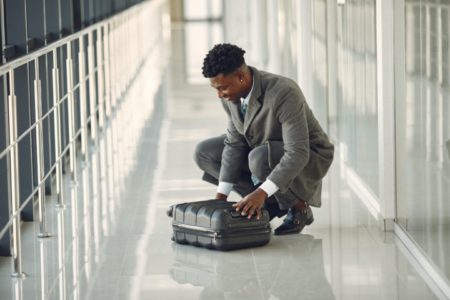
Due to the high volume of travelers funneling through airports, the holiday season is prime time for delayed flights and long layovers. Waiting can get exhausting and most airports aren’t set up for entertainment. If you’re a frequent traveler, this is a great opportunity to tap into lounge perks provided by your credit card company.
American Express, Citibank, Chase, and a few other companies offer airport lounge access with some of their premium travel credit cards. Depending on the lounge and airport location, travelers can enjoy buffets, free wifi, comfort, and privacy while they endure long layovers. If you want lounge access without needing a travel credit card, consider checking out LoungeBuddy where you can get passes for as low as $25.
Sign Up For PreCheck & CLEAR
Getting signed up for TSA PreCheck and CLEAR is one of the best decisions you can make when traveling for business during the holiday season. It only costs $85 and you won’t have to worry about taking off your shoes, unpacking your laptop, or liquids again.
The pass can be used at 180 US airports and typically gets travelers through TSA PreCheck in less than 10 minutes. Remember, holiday travel lines can get long so this is a great way to skip the lines especially if you’re in a hurry.
Don’t Fear Holiday Day Of Travel
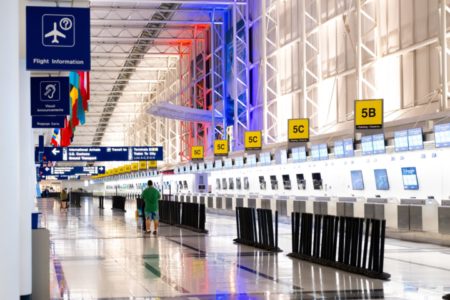
While the holiday season is always a busy time, you’ll find many airports cleared out on the day of the actual holiday. These are excellent days to travel if you have no intention of being with family that day. Many travelers have already arrived at their destination by the day of so you’ll miss the holiday before-and-after rush.
Of course, you’ve called your bank to notify them of your travels so your debit cards won’t get shut down. But what happens if the ATMs at the airport or hotel aren’t working? Carrying cash keeps you covered in case of emergency when traveling for business. Be sure to keep all of your receipts in case your job reimburses you later.
Enjoy Yourself

Remember to enjoy yourself when traveling for business this holiday season. It doesn’t have to be all work and no play. Be open-minded to spending time with your co-workers while out of town. If no one is down to hang out, consider looking into other activities and excursions outside of work hours. Life is about balance so be sure you get a manageable dose of work and enjoyment when traveling during the holidays.
Subscribe to travel noire
Get more travel content
Subscribe to Travel Noire, a free daily newsletter that features the best of travel, destinations, and guides to the cities you love from a new point of view — yours.
By subscribing to this newsletter, you agree to our terms of service and privacy policy.
Popular posts
Trending stories in world travel

The 24/7, 365 Travel Experts
We’re in the help business. Welcome to 50+ years of award-winning experience.
Meon Valley Travel is an independent award-winning travel management group enjoying global reach from the UK.

Business Travel
Employing the perfect blend of talent and technology providing complete travel management expertise and unrivalled personal service.

Discover a world of passionately curated holidays, crafted with finesse and enthusiasm by our travel team. No holiday is too big or small, and no itinerary is too complicated.

Repatriation
Unrivalled professional travel buyers for global repatriations travel requirements and a trusted supplier to blue chip Insurers and Assistance providers worldwide.
Our Sustainable Journey...
Trust our family to look after yours, we are striving to help you choose the best sustainable holiday. we want to enable the world to go on travelling, to experience different cultures and make those all important lasting memories with family and friends in a way that is kinder to the planet and creates a more climate positive future for us all., there is no easy solution. it is unrealistic to give up flying as this could be damaging to the destinations that rely on tourism for income. we have ingrained in our ethos that 'small changes have big impacts' and now with eco-travelling becoming ever more at the forefront of travellers minds, we want to help. , upcoming events.
Register now to receive updates about our destination and holiday focused events.

Travel With Meon ~ Holiday Show
- Saturday 27th April
- 11am – 3pm
- Petersfield Festival Hall
- Prizes to be won

Join Us For A Morning of Coffee & Coconuts As We Explore Mauritius...
Drop-in anytime between 9.30am – 12.30pm, enjoy a coffee or coconut and ask us or our Beachcomber expert, Stuart anything about holidays to the beautiful island of Mauritius.

Beyond the Screen: The Enduring Power of Face-to-Face Meetings in the Age of Remote Work
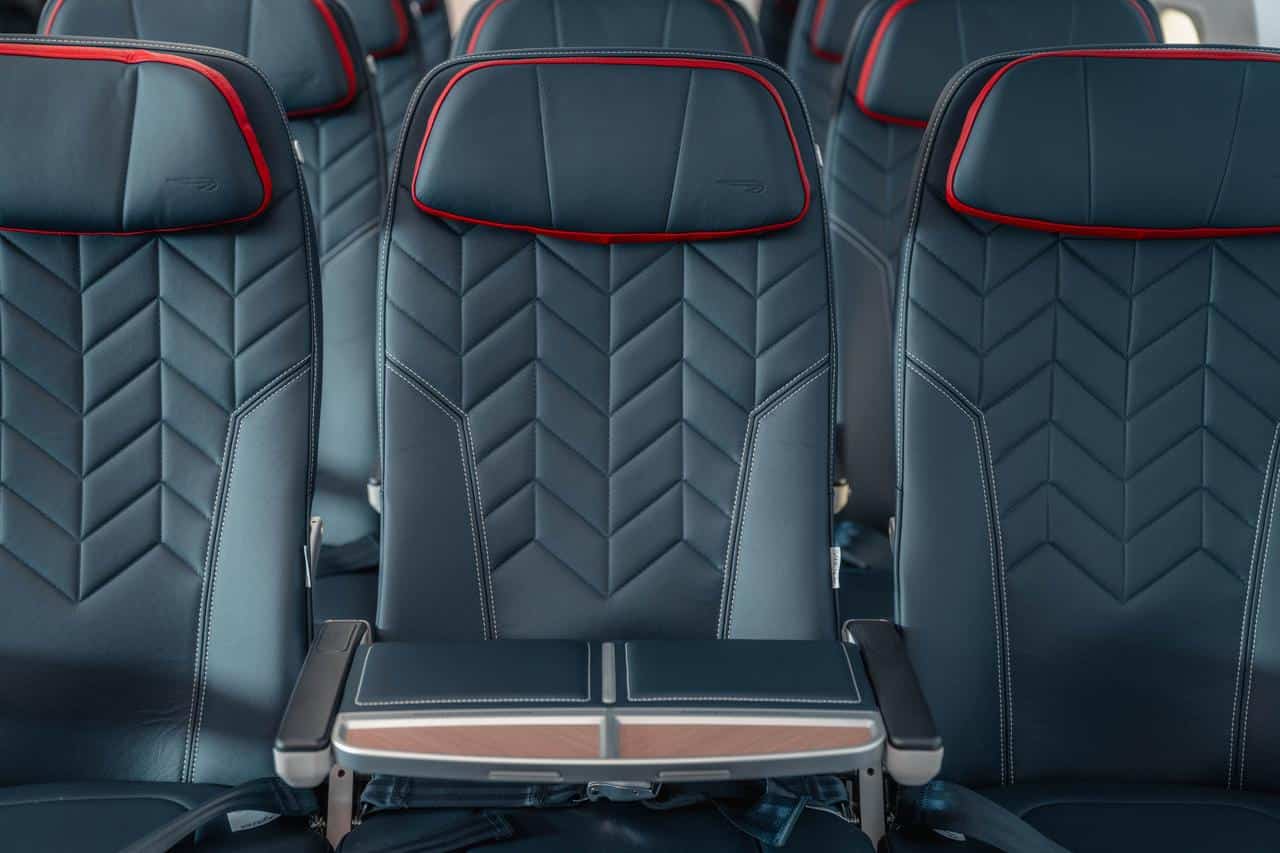
British Airways Prioritises Business Travelers with Short-Haul Cabin Refresh

How to ensure the journey to your wedding is a stress-free travel experience
Latest news and articles from our team, see what turns our heads and gets us digging out the passport.
We've got your travel needs covered
From Duty of Care to Holiday Offers, and everything in between we’re here to help.

Free Duty of Care Guide and Checklist
If you need to implement a travel duty of care policy for your employees, download our free guide which will walk you through the essential steps to protect your travellers and ensure their well-being.

Holiday Offers
We handpick the best deals from our trusted partners and preferred destinations to give you the best taste of what is available. If you can’t see exactly what you’re looking for we’d love to speak with you.

Book with Confidence…
We understand that perhaps the thought of travel may be a little daunting, but it needn’t be. We’ll talk you through each step to take to ensure your holiday gets off to a flying start!
We are striving to help you choose the sustainable holiday
We want to enable the world to go on travelling, to experience different cultures and make those all important lasting memories with family and friends in a way that is kinder to the planet and creates a more climate positive future for us all.
There is no easy solution. It is unrealistic to give up flying as this could be damaging to the destinations that rely on tourism for income. We have ingrained in our ethos that ‘small changes have big impacts’ and now with eco-travelling becoming ever more at the forefront of travellers minds, we want to help.
So where do you begin when trying to balance the impact of financial benefit and environmental burden when choosing a holiday? Maybe this is what is meant by ‘responsible travel’.
we are UK & Ireland's Top Business Travel Agency
We are delighted to be named Top Business Travel Agency in UK & Ireland at the TTG Media Top 50 Travel Agency Awards 2023.
Thank you for the support of our suppliers, clients, and colleagues. It’s an honour to serve and we treasure the opportunity to do what we love.
Meon Valley Travel Official Partner with Sani Ambassador Club and Ikos Prestige Club
“We are extremely proud to be recognised by Ikos and Sani as an official partner for their award-winning resorts. It is an honour to be awarded this prestigious title which will give our clients added, exclusive benefits when booking a Sani or Ikos holiday through us. Please do feel free to give us a call, our staff have extensive knowledge and top in-sider tips.” ~ Karen

Get In Touch, We'd Love To Talk...
Meon Valley Travel Ltd 32 High Street Petersfield Hampshire GU32 3JL
Holidays: 01730 711 010
Business Travel: 0116 264 5270
business travel
- Case Studies
- Corporate Travel
- Free Corporate Travel Policy Template
- Free Duty of Care Guide and Checklists
- Free Travel Spend Review
- Groups Travel
- Sustainable Business Travel
- Holiday Offers
- Holiday Inspiration
- Petersfield Travel Agency
- Honeymoon Travel Agency
- Weddings Abroad
- Where & When To Go
- PFA Travel Club
Repatriations
- Repatriation Travel Management
Meon Valley Travel
- Meet The Team

Privacy Overview
Travel and Expense
Top travel destinations for 2023 holiday business travel.
November and December are busy travel months. Travelers are gearing up to visit family or take advantage of time off for a bucket-list vacation. But some travelers will still be on the clock. SAP Concur analyzed U.S. bookings in Concur Travel over November and December and surprisingly, many employees took business trips over Thanksgiving, and several already have trips booked for Christmas and New Years.
Hundreds of Thousands Took Business Trips this Thanksgiving
The busiest day for business travel in November was Monday, November 13. Hundreds of thousands of workers traveled on 11/13 and 5.6% of trips went to Dallas, Texas, the number one destination and 5.4% went to Chicago, Illinois, which was a very close second. Other major metros like Washington, D.C. and New York City rounded out the top 10 list.
Top Destinations for November 13
- Dallas, Texas
- Chicago, Illinois
- Atlanta, Georgia
- Washington D.C.
- Denver, Colorado
- New York, New York
- Phoenix, Arizona
- Boston, Massachusetts
- Los Angeles, California
- Houston, Texas
While mid-November was the peak, business travel didn’t stop for the Thanksgiving holiday. Between November 17, the Friday before Thanksgiving, and November 26, the Sunday after Thanksgiving, hundreds of thousands of employees traveled for work.
Most employees traveled before or after the holiday. Friday, November 17 was the top travel date but Sunday, November 26 was a close second. The least popular travel date was Thanksgiving, on Thursday, November 23.
In terms of the top destinations, Las Vegas, Nevada claimed the top spot. In fact, more than three times as many business travelers went to Las Vegas compared to Phoenix, Arizona in the tenth spot. Like the most popular travel day in November (11/13), Chicago, Illinois, Atlanta, Georgia, and Dallas, Texas fell within the top 10 destinations. However, over Thanksgiving, Charlotte, North Carolina joined the list.
Top Destinations for Thanksgiving (11/17-11/26)
- Las Vegas, Nevada
- Washington, D.C.
- Charlotte, North Carolina
Business Travelers Ring in the New Year in Orlando
The top travel date in December was Monday, December 4. Like the busiest travel date in November, Dallas, Texas claims the number one spot, representing 6.2% of business trips taking place on December 4. Atlanta, Georgia comes in at second, representing 5.1% of business trips. Compared to November, new to the top ten list are Orlando, Florida and San Francisco, California. But read on because Orlando takes center stage over the holidays.
Top Destinations for December 4
- Orlando, Florida
- San Francisco, California
It’s still a few weeks away, but still, tens of thousands of employees have booked business trips during the Christmas and the New Year holidays, between the Thursday before Christmas, December 21, and the Wednesday after New Year’s Day, January 3.
Most trips won’t take place until after New Year’s celebrations, with the top travel dates being Tuesday, January 2 and Wednesday, January 3. The least popular travel date will be Christmas Day on Monday, December 25.
For top destinations, Orlando, Florida claims the number one spot by a mile. More than double the amount of business travelers will head to Orlando compared to Phoenix, Arizona in the second spot. New additions to the list include Seattle, Washington and San Antonio, Texas.
Top Destinations for Christmas and New Year’s (12/21-1/3)
- Seattle, Washington
- San Antonio, Texas
We’re not surprised to see so many holiday business trips planned. Our annual SAP Concur Global Business Travel Survey found that nearly all global business travelers (94%) said they were willing to travel for business in the next 12 months, including 67% who were very willing.
Happy holidays to the road warriors and cheers to maintaining client relationships and starting new ones!
Methodology: SAP Concur analyzed business travel bookings in Concur Travel with a U.S. origin during November and December 2023, and established holiday date ranges of 11/17-11/26 for Thanksgiving and 12/21-1/3 for Christmas and the New Year.

Select your preferred language
- Deutsch English English (Australia) English (China) English (India)
- English (United Kingdom) Español (Latinoamérica) Español (España) Français Italiano
- Português (Brasil) Suomi Svenska 中文
Top tips on how to plan a business trip
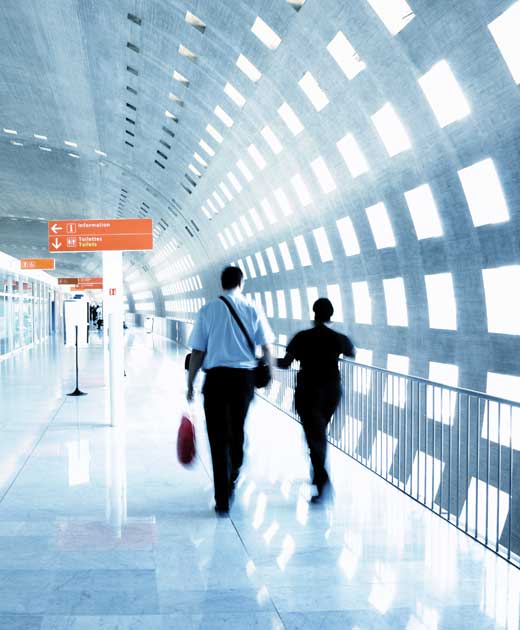
Follow these 6 steps for an effective business trip:
- Make your travel arrangements well in advance
- Select your accommodation based on both price and convenience
- Create an itinerary
Research your destination
- Remember your electronics, accessories and travel documents
- Prepare for your meeting
In today’s digital world, we can communicate across different time zones at a moment’s notice. However, when it comes to brokering a big deal or fostering a solid and long-lasting business relationship, nothing beats face-to-face interaction.
Corporate travel is still so important, and it’s equally important for anyone making a business trip to prepare thoroughly. When you arrive at your destination relaxed and well-prepared, you’re better equipped to make a good impression and focus on the purpose of your meeting. Preparation lets your mind focus on the here and now, making sure you stay on the ball in that all-important meeting. If you’d like to fine-tune how you get ready for your next excursion, follow these essential tips to become an effective business trip planner.
Make travel arrangements
Whether it’s your name on the travel documents or you’re a travel manager, planning business travel thoroughly is important. Your first step should always be to familiarize yourself with your company’s corporate travel policy . You’re making travel arrangements for a business trip, not planning a personal or a short break, so being compliant with your company policy is essential.
Next, it’s time to book your travel. This may involve traveling by air, rail, car hire or even boat. Think about the journey door-to-door, balancing travel times against cost and convenience. Visualize the various steps of the trip from A to B. Consider details like how long it will take to move between airport and railway station, the time it takes to fill out paperwork at the vehicle hire company, and whether luggage storage might be useful. Use multiple sources and different comparison sites, researching which companies are offering the best deals. Again, be aware of any budget restraints in your company’s travel policy.
Don’t forget the small details. Does the airplane have Wi-Fi so you can work on the move? Would leaving a day earlier allow you to arrive at your first meeting better rested and prepared? At this stage, the more carefully you prepare, the more confident and relaxed you’ll be when you depart.
Select your accommodation
Preparing business travel is, of course, only half the job. Choosing the best accommodation for your requirements is also essential. If you’ve only got one meeting place to reach, make sure you book a hotel that’s nearby – rather than be swayed by a more luxurious option that might be a stressful 45 minute trip away. Use maps on your smartphone to measure distances from the station or airport to your hotel – and remember the roads and transport networks will be busier at certain times of day.
Check your company’s hotel policies to see if there are any preferred hotels - you might be able to get a good deal too. When considering the cost, make sure you compare rates for similar types of accommodation and make sure you select something that’s fairly priced – some companies even stipulate a cost per day that would limit the choice of hotels.
It’s also a good idea to pay close attention to the amenities at the hotel. Some tourist-focused hotels may serve breakfast too late for your early starts, and as a business traveler you’re likely to want free Wi-Fi, 24-hour room service, plenty of power points for charging your devices. CWT Hotel Intel gives travelers access to trusted peer hotel reviews and can be a handy tool for business trip planners.
Create a detailed itinerary
Your itinerary is your blueprint for a successful business trip. Use it to stay in control of every detail – from transport times and the names of those you’re meeting, to your travel reservations and hotel address. Be sure to allow yourself extra time on your itinerary for relaxing, meetings that have been delayed or overrun, and busy traffic. Consider using a specially designed tool like the myCWT app , which syncs your itinerary with work calendars, and allows travelers to share this with colleagues. This is handy from a communication and efficiency perspective, and as a safety measure if you’re travelling to an unfamiliar destination.
It may be that you’re traveling to a destination you are familiar with and feel comfortable in. Or, you may be entering unchartered territory. If that’s the case, research is essential to avoid unnecessary risk. For example, some cities are well known for pick pockets, so you’ll need to be extra careful when storing important and expensive items like phones in your pockets. Depending on where you’re going, reading up on the current political situation at your destination could also be prudent.
Perhaps you’re traveling to a city or country with a different culture and customs to your own. Avoid looking foolish or, worse, causing offence, by researching the differences in behavior and manners before you arrive. For example, if you’re taking potential clients for a meal, do you know the etiquette on tipping, or when to give people your business cards? Or, if you’re visiting a country where English isn’t the common language, you could even learn a few basic phrases, such as greetings and “thank you”, which could make all the difference when making a good first impression.
Prepare your travel documents
Hours of careful preparation and research will all be wasted if you forget vital travel documents. Traveling between countries requires a current, valid passport, travel tickets and sometimes a visa. It’s key to research whether or not you need a visa as soon as possible, even if you are just transiting through a country, without stepping foot outside the airport. Some embassies can take a number of days or even weeks to issue visas. Even if you’re not traveling to a different country, you may need photo ID to clarify that your name corresponds to the one on the ticket - your passport or driving license are the best options so keep them safe at all times.
Remember your electronic accessories
Stay as productive as possible on your trip by taking a laptop or tablet – it’ll make your travel time really count. Remember to pack the relevant chargers and adapters, too. You can usually pick these up at the airport when you’re passing through, but being prepared is key and will save you time and money in the long run.
Get ready for your meeting
So you’ve followed all the right steps for planning a business trip, but what about your business objectives and the meeting itself? Making a note of what you hope to achieve on the trip can help improve your focus - even if you simply want to reach out to new contacts or gain a general overview of potential new client. Arm yourself with as much information as possible about the people you’ll meet, as well as the places they’ll be. What’s the dress code? If you’re visiting an industrial site, for example, will you need sturdy shoes? If you’re going to be giving a presentation, what format will it take and will your host have the equipment you need? Simply emailing ahead to check if they have suitable screens and cables can ensure you avoid embarrassing delays or confusion that would get your meeting off to an awkward start. That first impression counts so give yourself the best chance of making a good one.
By setting aside the time to prepare, conducting some detailed research and following these business travel tips, you can optimize your chances of a productive and enjoyable trip.
More publications
Contact us today to see just what we could do for your business.

Traveler help
Help me manage my travel

Careers at CWT
Explore career opportunities
Careers @ CWT

Learn more about travel management
Contact CWT
Learn more about our travel management offering
Travelers: manage your travel here . The below form is for inquiries about our corporate travel management offering.
To reach out to CWT to learn more and also receive communications (email or phone) on our products and services, please complete the form below. You can unsubscribe at any point in the future from our mailing list using the ‘unsubscribe’ link on any of our emails.
Thank you for your interest in CWT, we will contact you soon.
Thank you for your interest in CWT. Unfortunately, CWT cannot offer services in your home country at this time. Your contact request has not been submitted.
With kind regards,
How to Combine a Business Trip with a Vacation

T he long history of road warriors adding vacation days before or after a business trip, initially a response to the old airline pricing practice of marking up midweek round trips, is getting a fresh look thanks to the widespread acceptance of remote work.
High inflation that has driven airline fares up by 18% over the past year are also a big driver, according to Suzanne Neufang, CEO of the Global Business Travel Association (GBTA).
“If you’re already on a plane, [that’s] a huge motivation. If your basic transportation… is already covered by your employer, I think that’s a huge benefit, and a reason why business travelers are interested in this,” she says.
A 2022 survey conducted by hotel brand Crowne Plaza found that 60% plan to add leisure travel days onto future business trip itineraries. “It’s almost as if Monday is the new Sunday and Thursday is the new Friday,” says Ginger Taggart, vice president of global brand management at Crowne Plaza’s corporate parent, IHG Hotels & Resorts.
More from TIME
Hotels are on board: Although vacationers are making up for lost time with abandon, the return of more-lucrative corporate bookings has been, at best, halting. The GBTA predicts that factors including persistent inflation, climbing energy prices and companies’ desire to conserve cash in the face of an economic downturn will delay until 2026 the recovery of what had been a $1.4 trillion business before the pandemic. And that is one of the more optimistic projections. “Consumer sentiment suggests a full return to pre-COVID levels of business travel may never occur,” according to an analysis by hotel data consultancy STR. .
Beleaguered hotels can make up for some of the shortfall when business travelers bring their families and spring for adjoining rooms or suites, as well as when traveling companions with nothing to do during the workday spend money at a hotel spa, golf course or casino.
Some employers haven’t warmed to the blended-travel trend, says Evan Konwiser, executive vice president of product and strategy at American Express Global Business Travel. “Having a policy denotes formal endorsement of something, and a lot of travel management teams don’t have the overhead or resources to manage an additional component,” he says.
But in spite of concerns about potential liability, expense account mismanagement, workers slacking off or some combination of all three, many employers have been eager to embrace an activity that doesn’t add to their payroll costs and is perceived as a perk by many employees. In a 2022 GBTA survey of corporate travel managers, 90% said employees were interested in combining business trips with recreational travel at their companies.
How to make the balancing act work
Blending work and play can be easier said than done—especially for business travelers whose instincts have gotten rusty. “It’s almost like a muscle people haven’t flexed in the past couple of years,” says Misty Belles, vice president of global public relations at travel agency network Virtuoso.
But with a few tips from industry pros, you can make sure that both the work and the recreation parts of your trip get the job done.
- Get the green light from your higher-ups. Combining the two is a gray area at many companies, so clear communication with your boss is key, particularly as more executives are agitating to get worker bees back into the office. “Making sure they can be productive [is] important for their own sanity, but also important to show to the company,” Konwiser says.
- Plan for disruptions. Gaming out a contingency plan with your fellow travelers beforehand is smart. Shortages of workers ranging from baggage handlers to air-traffic controllers have triggered epic logjams at airports in recent months. In the event of a canceled flight, a traveler on a bargain or frequent-flier reward ticket is apt to have more hassle getting rebooked than a business traveler whose reservation benefits from the clout of a corporate account, says Paul Tumpowsky, CEO of Virtuoso member agency Skylark Travel Group. “Be prepared … Those two people are going to get treated very differently,” he says. For business travelers whose itineraries are prone to change on short notice, he suggests looking into travel insurance that includes coverage for work-related cancellations.
- Have a place where you can get work done. Ironically, the trick to working from anywhere is making sure you have a place to get work done. Belles says many travelers bringing partners or family with them book larger rooms or suites, or stay at hotels with amenities that cater to professionals, like a business center, club floor or lounge. Your hotel lobby might be another option: Many have comfortable nooks that offer a modicum of quiet and privacy.
- Don’t forget to put relaxation on your calendar. If you’re traveling with family or friends, make a schedule and stick to those boundaries. “It’s not fair to your family when you’re saying, ‘Hey, come with me,’ and then you end up working your normal 60- or 70-hour workweek,” Neufang says. “I think the most successful blended travelers have their work and their play … It’s very clear when they can go and shut the laptop.”
More Must-Reads From TIME
- Exclusive: Google Workers Revolt Over $1.2 Billion Contract With Israel
- Jane Fonda Champions Climate Action for Every Generation
- Stop Looking for Your Forever Home
- The Sympathizer Counters 50 Years of Hollywood Vietnam War Narratives
- The Bliss of Seeing the Eclipse From Cleveland
- Hormonal Birth Control Doesn’t Deserve Its Bad Reputation
- The Best TV Shows to Watch on Peacock
- Want Weekly Recs on What to Watch, Read, and More? Sign Up for Worth Your Time
Contact us at [email protected]
4 of the best practices and 4 of the worst mistakes employees make when traveling for business
- Employees traveling for work can make their time on the road more pleasant with a few practices.
- For a successful trip, business travelers should eat healthily, prioritize sleep, and pack wisely.
- This article is part of " Business Travel Playbook ," a series about making the most of work travel.

Business travel continues to rebound from the early stages of the pandemic as employees take more work trips.
A 2023 US Travel Association survey of 2,379 business travelers found that the average number of monthly trips the respondents expected to take was around three — a slight bump compared to two trips a month the previous year.
With professionals traveling more for work , Business Insider talked to three frequent business travelers about their successful habits and a few things they avoid when on the go.
4 habits of successful business travelers:
1. practicing good hygiene.
While this might seem obvious, Donzella Burton , the owner of a center for assisted-living healthcare and training, said that if you're going to be taking frequent business trips, it's important to prioritize your health by practicing good hygiene.
"I travel for business once or twice a month, depending on the season," she said. "I wash my hands frequently with soap and water for at least 20 seconds, especially before eating or touching my face. If soap and water are not available, I try to make sure I have alcohol-based hand sanitizer with at least 60% alcohol content."
2. Eating healthily and exercising
While business travel can disrupt your routines, eating healthier meals and drinking plenty of water can help you feel more energized . Michael Murray, the CEO of the electronics manufacturer Kopin Corp., travels at least twice a month for business and said that eating healthy meals could be tough, especially when his flights arrive late at night.
"By the time I arrive, many hotels have shut down room service at 9 p.m.," he said. "If it's late, I tend to order from a food-delivery app while I'm en route to my hotel and focus on ordering from places with great ratings, natural food, and decent salads."
Carving out time to exercise on the road is also important because exercise has the potential to boost immune responses and keep energy levels high .
"I invested in some lightweight running/workout shoes which are easy to pack and some workout gear that is light and breathable so I can use it often," Murray said. "When I travel, I choose hotels for their gym equipment, access to walking paths, or access to a nearby fitness chain that offers day passes. I've also downloaded several fitness apps if I need to work out in my hotel room."
3. Enrolling in airline security programs
If you know you'll be flying often, look into signing up for an airline security program to save time before your flight.
"I recommend utilizing TSA PreCheck or Clear," Anneleah Williams-Bridges, a hospital executive and healthcare consultant who travels weekly for her job, said. "These are options to help fast-track your security-check-in process during high travel times and are a valuable time saver that will help you bypass the heavier foot traffic of all the other business travelers."
Both TSA PreCheck and Clear are often great for domestic flyers and can reduce time spent in airport security lines. TSA PreCheck users get access to a separate, shorter security line, and Clear users can jump to the front of the security line after verifying their ID and boarding pass.
4. Prioritizing sleep
While it might be tempting to use all your downtime to tackle more tasks on your to-do list and work late into the night, getting sleep is essential for a successful work trip.
"Don't be brave. You don't get a medal for 'burning through the day' without sleeping," Murray said. "I used to fly to the UK and Ireland and go straight to the office from the overnight flight, which from the East Coast is just enough time to sleep for an hour or two, maybe. In the long run, running on a few hours of sleep wasn't effective for me, my team, and the business."
4 things successful business travelers avoid:
1. overpacking.
Wanting to be prepared for anything is understandable, but don't go overboard with stuffing your suitcase . Overpacking can result in a cluttered hotel room — and you'll likely have to check a bag, which can slow down your commute.
"Packing light is a great way to make it through the airport quicker," Williams-Bridges said. "Only using carry-on luggage for business travel ensures that you can board the plane, exit the plane, and go directly to your destination without waiting for a checked bag. This can save you about an hour and a half of time during your commute."
2. Overplanning
Another successful habit is to avoid overplanning. Burton said that while it's important to have a general idea of what you want to accomplish on a business trip, you should leave room in your schedule for downtime and avoid scheduling back-to-back meetings or events.
"Overplanning every minute of a business trip can lead to unnecessary stress and can hinder the potential for spontaneous discoveries or relaxation," Burton said. "Scheduling downtime allows me to decompress and can offer valuable opportunities for self-care and personal reflection."
3. Booking the cheapest flight
Burton said you should stick to one airline to take advantage of loyalty points if you travel at least once a month. The benefits of joining an airline loyalty program include upgraded seating, lounge access, and priority boarding.
To make things easier, business travelers should also try to book the best direct flights and not opt for the least expensive flight because "sometimes you get what you pay for," Williams-Bridges said, adding that cheaper flights could mean a travel experience riddled with complications like excessive delays.
"I also avoid traveling on holidays, which can be cost-effective," she said. "Lastly, I try to avoid connecting flights, which could add unnecessary flight time to your trip."
4. Consuming too much alcohol
While many business meetings and client dinners can include a glass or two of wine, excessive drinking could result in impaired judgment or a hangover.
"While it's OK to enjoy a drink or two with colleagues or clients, be mindful of alcohol consumption and its impact on your overall health and energy levels," Burton said. "Opt for lighter options like wine or spritzers, and alternate alcoholic beverages with water to stay hydrated."
- Main content
How to get through business travel during peak holiday season
Business travel has its perks, but, especially around the holidays, you have to go through a lot to enjoy them. Let’s say you are on a business trip. At your fifth business meeting of the day, you are probably picturing yourself going back to the hotel room and hoarding the plush bed all to yourself while dinner’s on the way. However, to get there, you must brave the cold, the flu bug, lengthy waiting lines at the airport, and what not. After all, it is the holiday season and you cannot expect to glide your way through.
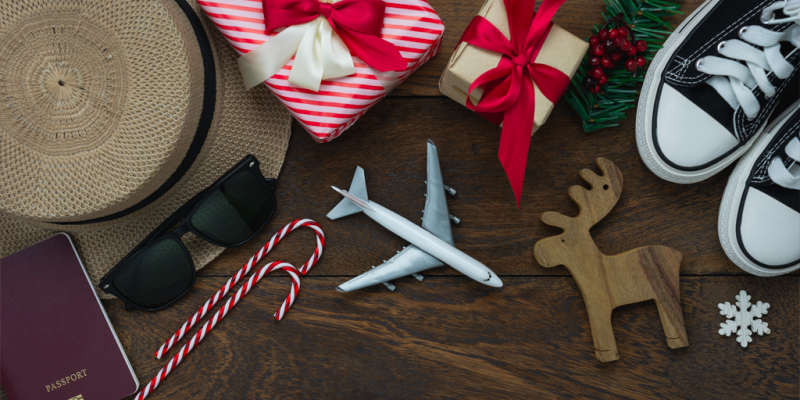
While it may not be a bed of roses, business travel during the holiday season is definitely survivable. We have put together some useful tips and hacks to ensure you have the smoothest possible business trip from start to finish.
Booking last minute
Ideally, you would have planned and booked all the elements of your travel at least three weeks before your trip. But hey, business trips can sometimes pop up without warning. Now, booking your air tickets and accommodation within the budget mandated by your firm’s expense policy can be problematic.
To solve that, you can use travel booking websites and apps to find the airlines and hotels offering the best deals at the eleventh hour. Try Hopper’s GTFO or Lastminutetravel.com to identify the cheapest flights to your destination and find accommodations there.
Choose an early flight
While you may enjoy a good sunrise, the airport is probably not your favourite place to witness it from. However, it may be the best choice for your business trip. According to Transtats , around 21% of flights operated by the major airlines experienced delayed departure during the 2018 winter break. By taking the first flight of the day, you can avoid flight delays (since delays usually happen as the day progresses) and cancellations. You’ll also beat the crowds and pay less—early morning flights are unpopular, which tends to make them cheaper.
Fly on the day
Flying on a holiday itself can help you avoid the crowds and score a ticket at a cheaper price, since most travelers would have already arrived at their holiday destination. However, this is a good idea only if you’re not trying to spend the holiday with your family, or if you’re on a bleisure trip and have your family traveling with you.
Travel management
Let someone else do the planning
Booking business trips is pretty different from booking vacations. That is why most travelers prefer to hand it over to the experts: the travel agents. While the actual booking process may be simple, it can become strenuous when you include the hotel bookings, air tickets, car rentals, insurance, reward miles, and finding the lowest rates for each element of the trip.
Most firms partner with travel agencies or have an in-house travel team that handles corporate travel from end to end. The travel team handles everything: providing travel options, leveraging partnerships or bulk deals to get lower rates, even helping you submit your expenses. Additionally, travel agents have a 24-hour duty of care to help you with problems that arise while you are on a trip.
Download the mobile applications
Mobile apps are powerful tools for frequent travelers. If your travel agent or in-house travel manager recommends that you download an expense management app or a booking app, do it.
Some airlines, hotels, and car rental companies offer incentives for using their mobile apps to perform travel tasks. For instance, you may get points or discounts for using the right mobile app to make your reservations or check in for your flights.
Other apps offer a smoother process with some aspect of your travel. Zoho Expense , for example, allows travelers to view their itinerary, create trip requests, request advances, connect their corporate cards, and record their expenses on the go. Relevant details can be shared with bosses, travel managers, and finance teams, and that transparency even helps travel teams fulfil their duty of care if something goes wrong.
Be travel-savvy
Be early and prepared
It’s a good idea to reach the airport early. Besides making sure you don’t miss your flight, it also gives you extra time in case of any mishap or delay. Remember to check in online the day before your flight so you can skip the long line at the check-in counter. Skipping the check-in and baggage drop-off lines can be a real time saver.
Lounge your layovers
Unless you’re at Singapore’s Changi International Airport or Tokyo’s Haneda, waiting for hours at an airport can bore you to death. However, if you have a Chase Sapphire Reserve card or a Platinum Card from American Express, you can access airport lounges across the world. Or grab one of the other cards that provide access to airport clubs worldwide, where you can treat yourself to the choicest items from the buffet and enjoy the free WiFi.
If you are not a fan of credit cards, you can still wait out your layovers in a nice lounge. LoungeBuddy gets you access to airport lounges without memberships, elite statuses, or first class tickets. All you have to do is purchase a lounge pass starting at $25.
Sign up for TSA PreCheck and CLEAR
If you’ve been thinking about enrolling for TSA PreCheck or CLEAR , go ahead and do it.
Signing up for TSA PreCheck is money well spent—it only costs $85 and lets you breeze through the security checkpoints at more than 180 U.S. airports. You get to keep your shoes and jackets on and you don’t have to pull laptops and liquids from your bags. All together, the average amount of time to get through the TSA PreCheck line is less than 10 minutes. Best $85 you will ever spend!
If you are enrolled in CLEAR, you can use it at participating airports to have a personal concierge accompany you through the security line. Your concierge will walk you directly to the front of the line and help you put your bags on the belt.
Packing for a business trip can get tricky. It is advisable to pack clothing items that you can mix and match. Basic colours like black, blue or brown are ideal for this and they are stain resistant too. If you are carrying a suit, fold it to keep it wrinkle-free instead of rolling each piece of clothing individually.
Packing the right items is one thing, but it all depends on how you pack them. Try to fit all your stuff into a small carry-on suitcase and a bag/backpack. By doing this, you can skip waiting at the baggage carousel and in case of a flight delay or cancellation, you can reschedule easily since you have all your bags with you.
Also, pack right
Here’s a small checklist to prepare you for everything that comes your way:
- Cash : What if the credit card system is down or your card gets declined? Having cash on hand is essential during the holiday season.
- Medication for cold, fever, head or body aches, and stomach upsets : Get travel-friendly sizes of your medicines and do not forget to carry the prescription along with the pills.
- A travel pillow : You can catch some sleep on your flight comfortably and the duty-free stores sell overpriced travel pillows.
- Hand sanitizer and wet wipes : Cold and flu cases irrupt during the winter, and you don’t want to risk picking up bugs and germs.
- An envelope to keep your receipts in.
Ship some stuff
If you are flying to a conference or a trade show with brochures, giveaways, or presentation materials, ship them! You can send them via a carrier like FedEx or UPS directly to your hotel or the event venue. Otherwise, if the co-worker assigned to carry the bag containing your event materials misses their plane or is late to the event, it could spoil your agenda for the day. By shipping them, you can travel light and hassle-free.
Bonus travel tips
Having someone to cover for you while you are away on business can make travel much easier. It helps you focus on the trip without working overtime and stressing about what is happening back in the office. Also, don’t forget to activate your e-mail auto-responder to let your co-workers, vendors, and clients know that you’re away from the office. This way you can answer your work email at your convenience, knowing that the senders aren’t expecting an immediate response.
Whatever holiday travel strategies you use, the important thing is that they should make the travel experience smoother and less stressful. We hope these tips were helpful! If you’ve got other favourite travel tips to add, please share them in the comments below. Happy holidays!
Related Posts
- Accelerate travel expense reporting with a mobile application
- How artificial intelligence will change the way you manage business travel
Cancel reply
This site uses Akismet to reduce spam. Learn how your comment data is processed .
You might also like
Make your expense reporting effortless. try zoho expense today.
- English (CA)
- Deutsch (DE)
- Deutsch (CH)
How flexible work is changing holiday travel trends
A rise in 'workcations'
Longer holiday trips
Increased demand for midday flights
A change in peak travel days
Growth of airport coworking spaces
?)
Make business travel simpler. Forever.
- See our platform in action . Trusted by thousands of companies worldwide, TravelPerk makes business travel simpler to manage with more flexibility, full control of spending with easy reporting, and options to offset your carbon footprint.
- Find hundreds of resources on all things business travel, from tips on traveling more sustainably, to advice on setting up a business travel policy, and managing your expenses. Our latest e-books and blog posts have you covered.
- Never miss another update. Stay in touch with us on social for the latest product releases, upcoming events, and articles fresh off the press.
?)
Business Travel and Wellness Survey Results
?)
60+ online travel booking statistics & trends
?)
20 Employee retention statistics that might surprise you
- Business Travel Management
- Offset Carbon Footprint
- Flexible travel
- Travelperk Sustainability Policy
- Corporate Travel Resources
- Corporate Travel Glossary
- For Travel Managers
- For Finance Teams
- For Travelers
- Thoughts from TravelPerk
- Careers Hiring
- User Reviews
- Integrations
- Privacy Center
- Help Center
- Privacy Policy
- Cookies Policy
- Modern Slavery Act | Statement
- Supplier Code of Conduct
These are the busiest days to travel this holiday season

2023 has been a record-setting year for air travel, and there's no reason to think the end-of-year holidays will be any different.
After logging its busiest summer ever at U.S. airport security checkpoints, the Transportation Security Administration saw more passengers on Nov. 26 — the Sunday after Thanksgiving — than on any day in its 22-year history.
And the crowds are just getting started.
AAA expects 7.5 million Americans will fly over the 10-day Christmas and New Year's holiday period. That's a number larger than both last year's holiday airport crowds and those seen in 2019.
At security checkpoints, agents will be working to keep lines moving. Their goal: wait times of 10 minutes or less in the TSA PreCheck lanes and a half-hour or less in the standard lanes.
"We expect this holiday season to be our busiest ever," TSA administrator David Pekoske said in a statement last month.
It was a prediction that the Thanksgiving rush confirmed, and one that tracked with the crowds seen all year. Seven of the 10 busiest days ever at TSA checkpoints have come in 2023. The 2.9 million air travelers seen on Nov. 26 beat out the previous record from June 30, set by Fourth of July weekend travelers.
Suffice it to say, if you're traveling for a December holiday, it's a good time to make sure that your TSA PreCheck, Global Entry or Clear membership is active. Also, make sure your Known Traveler Number is attached to your flight reservation.
Meanwhile, all eyes will be on how airlines perform following 2022's headaches, most notably the Southwest Airlines December meltdown . That meltdown was an operational disaster the airline says it will avoid this year thanks to a host of changes.
Fortunately, airlines are off to a good start with this year's holiday season. Between Nov. 19 and 26, during peak the peak Thanksgiving period, U.S. based carriers canceled a collective 0.2% of flights, according to FlightAware data analyzed by TPG. That was down slightly from a similarly impressive 0.3% cancellation rate during the equivalent period last year. The rate of delays among those carriers hovered at a consistent 17% from last Thanksgiving.
However, travelers have learned all too well the last couple of years that the end-of-year holiday season can bring a plethora of potential roadblocks, including the possibility of bad weather and the lingering threat of air traffic control-related disruptions.
"Mother Nature is always the x-factor," U.S. Transportation Secretary Pete Buttigieg acknowledged at a news conference last month.
Busiest days to travel at Christmas and New Year's

The TSA anticipates heavy volume throughout the Christmas and New Year's holiday period. However, it may likely come in the form of sustained crowds, as opposed to any single, record-setting days. (In recent years, the busiest day of the year has typically been the Sunday after Thanksgiving, as it was this year.)
Exactly which days will be the busiest days to fly this month? It's a little harder to predict the end-of-year holidays, which fall on a different day of the week each year. Also, recent years have held no shortage of abnormalities, from last December's bad weather and Southwest meltdown to COVID-19 and the omicron variant surge disrupting travel in 2020 and 2021.
Last year, the three busiest days for air travel over the December holidays were as follows, per TSA data:
- Dec. 21, 2022 (a Thursday)
- Dec. 30, 2022 (a Friday)
- Jan. 2, 2023 (a Monday — and a federal holiday following New Year's Day)
This year, Christmas Day and New Year's Day fall on a Monday. It seems a safe bet that airports will be busy leading into the weekends prior to the two holidays, particularly Christmas.
Airlines for America, a trade group for the largest U.S. carriers, says the busiest days will be:
- Thursday, Dec. 21
- Friday, Dec. 22
- Tuesday, Dec. 26
- Wednesday, Dec. 27
- Thursday, Dec. 28
- Friday, Dec. 29
On the other hand, if you can find a way to travel on Christmas Day, you may find ultra-light crowds — if Thanksgiving was any indication, at least. Thanksgiving Day was the second least crowded day of 2023 at U.S. airports, according to TSA data. Likewise, Airlines for America projects Christmas Eve, New Year's Eve and New Year's Day will be similarly uncrowded.
What about driving?
As usual, even more Americans will drive than fly for the holidays, although the share of air travelers is up from recent years.
More than 103 million U.S. travelers will take year-end holiday road trips during the 10 days around the end-of-year holidays, according to AAA. That's up nearly 2% from last year.
There's some good news for drivers, too. The national average for a gallon of regular gas currently sits at $3.15, down slightly from this time last year.
That's despite airlines battling cost pressures from jet fuel prices in recent months.
Still, if you are driving for Christmas or New Year's, be sure to pay at the pump with a credit card that offers bonus points or cash back at gas stations . Consider stacking those bonus points with gas rewards programs and other ways to save on gas.
Bottom line
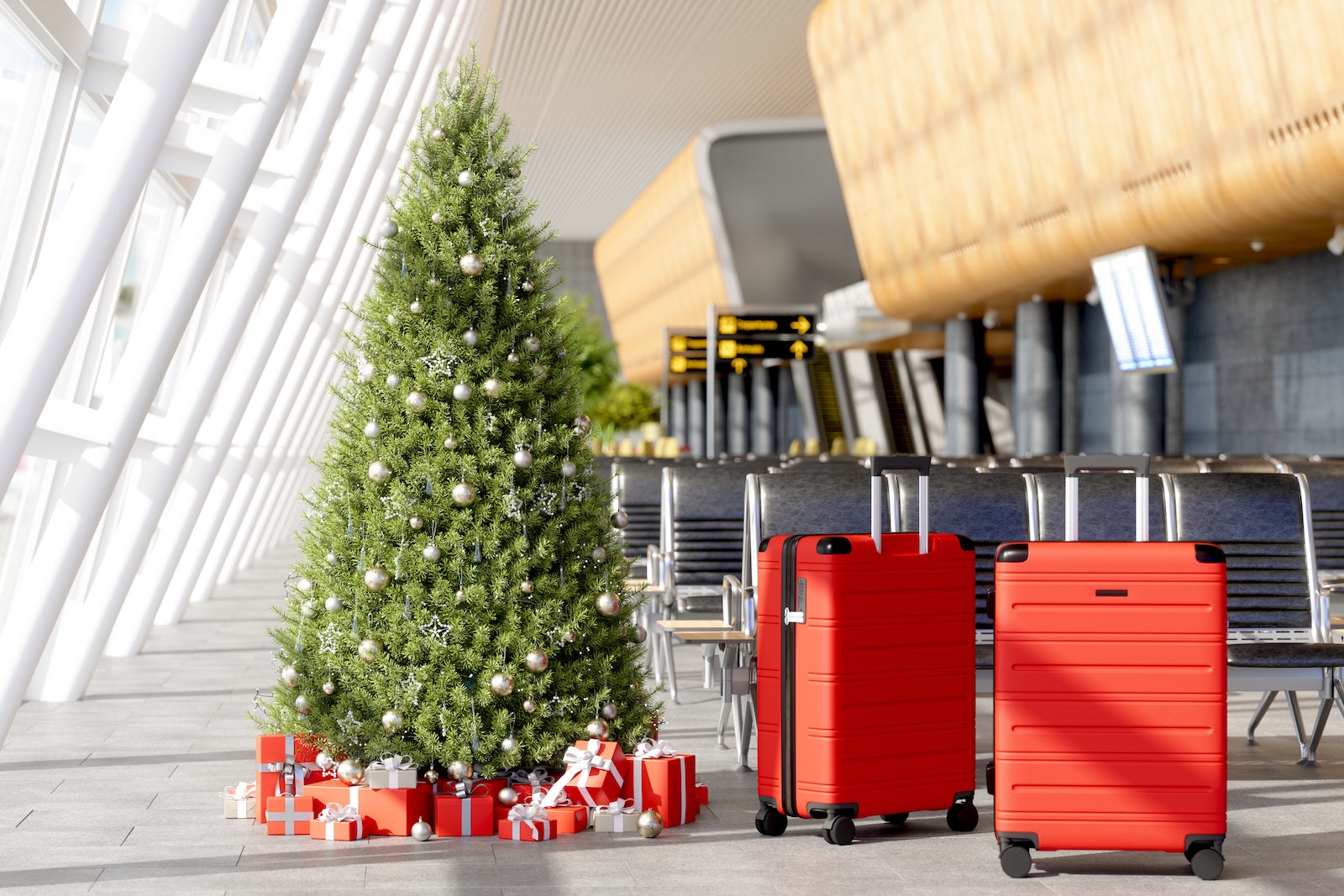
The holiday season is already off to a busy start, and that trend will likely continue this month with Christmas and New Year's travel. With those airport crowds in mind, it's a good time to double-check that you booked your flight and all other trip elements with a credit card that includes travel insurance protections.
As you travel, don't forget to take advantage of those airline fee credits on cards like The Platinum Card® from American Express . Also, don't forget to use an airline credit card for credits on checked bags or travel. This is where you can really offset that annual fee.
Download the MyTSA app so you can check security checkpoint wait times and read up on your rights as an air traveler in the event something goes wrong — including when you're owed a refund.
Related reading:
- Key travel tips you need to know — whether you're a beginner or expert traveler
- The best travel credit cards
- Where to go in 2024: The 16 best places to travel
- 6 real-life strategies you can use when your flight is canceled or delayed
- 8 of the best credit cards for general travel purchases
- 13 must-have items the TPG team can't travel without

These Are the Busiest Travel Days of the Year, According to TSA
The holidays and holiday weekends often bring with them some of the most congested days at the country’s airports and on the roads..
- Copy Link copied

The Tuesday and Wednesday just before Thanksgiving and the Sunday after Thanksgiving are often among the busiest travel days of the year.
Photo by Jim Lambert / Shutterstock
Every year, millions of people embark on journeys, whether for business or leisure. After a few years of much less crowded airports due to the pandemic, the International Air Transport Association is reporting that passenger numbers are just about what they were prepandemic levels.
However, there have already been a number of days that have surpassed prepandemic levels and they’ve largely fallen right before or after holidays.
Take Independence Day, for example. In 2023, AAA projected that 4.17 million people flew over the July Fourth holiday period, surpassing the previous air travel record of 3.91 million travelers, set in 2019. Similarly, TSA screened a record number of passengers on the Sunday following Thanksgiving in 2022, with more than 2.56 million passengers.
According to the TSA, the busiest travel days of the year are usually the Tuesday and Wednesday before Thanksgiving and the Sunday after Thanksgiving . TSA recorded its highest passenger screening volume in its history on the Sunday after Thanksgiving in 2019, when nearly 2.9 million passengers passed through TSA checkpoints. But Thanksgiving and Christmas aren’t the only times we can expect busy airports. Here are the busiest travel day of the year.
Busiest travel days of the year
Thanksgiving and Christmas tend to be the busiest travel days of the year, but other holidays like Memorial Day, July Fourth, and Labor Day also see some of the highest volumes of air passengers.
So far this year, daily passenger numbers have been growing each month. In all of 2022, only one day had more than 2.5 million air passengers in the United States: November 27 (the Sunday after Thanksgiving), with 2.560 million. As of August 20, 2023, there had already been more than 75 days in the calendar year that had surpassed 2.5 million air passengers, according to TSA checkpoint data .
These have been the five busiest travel days in the last full year:
- July 30: 2.793 million passengers
- July 28: 2.785 million passengers
- July 23: 2.789 million passengers
- June 30: 2.884 million passengers (the new record for the busiest air travel day ever in the United States)
- June 16: 2.785 million passengers
For reference, the busiest travel day in all of 2019 was November 27, with 2.882 million passengers.
The busiest travel days around Christmas and New Year’s, historically
As for Christmas and New Year’s Eve, the number of travelers is likely to ramp up during the end of December and into early January as well. In 2019, the highest number of travelers during the Christmas and New Year period was on Friday, December 17 (one week before Christmas), when 2.6 million travelers passed through TSA checkpoints. The second busiest day was Christmas Eve, with 2.58 million travelers, followed by the day after Christmas with 2.57 million travelers.

New York City consistently ranks as one of the top domestic travel destinations for the holidays.
Photo by Elias Andres Jose/Unsplash
Tips for flying during the busiest times of the year
There are a few ways to make travel easier and clear busy TSA checkpoints more quickly, this holiday season.
Get TSA PreCheck, Clear, and/or Global Entry
Never have these security expediting services been more valuable than during the current congestion happening at U.S. airports. TSA PreCheck recently reduced its prices from $85 to $78 for a five-year membership, and it’s only $70 to renew . Clear costs $189 per year. International travelers should consider the $100 Global Entry, which includes TSA PreCheck, for expedited customs screening upon arrival in the United States—and there’s a secret way to speed up the application process .
Check to see if your airport has a fast-pass security lane you can book in advance—for free
No TSA PreCheck or Clear? Select U.S. airports are giving travelers the option to make an advance “fast pass” reservation to head to the front of the security line—free of charge. We’ve compiled the full list of airports that offer this service .
Consider traveling with carry-on only
For those who don’t want to risk their luggage getting lost during a busy travel time when airports remain understaffed, traveling with carry-on may be your best bet. Another alternative? Luggage-shipping services .
Know what you can bring through security
If you’re traveling with carry-on, know what you can and cannot pack in said carry-on. By now, you know you can only carry on liquids in containers 3.4 ounces or smaller, so be sure that holiday items such as gravy, cranberry sauce, or wine are either left behind or packed in a checked bag as they are considered liquids and could otherwise be confiscated (and create delays). Check AFAR’s in-depth guide to what foods you can bring through TSA to make sure that what you’ve packed in your carry-on can pass through security.
Thoroughly check your bags before leaving the house
TSA recommends that travelers fully empty their bags prior to packing to make sure that they don’t accidentally bring something to the airport that they didn’t intend to bring, which could cause further delays.
Monitor the weather
Check the weather and forecasts that are available on sites such as the National Weather Service , the Weather Channel , and AccuWeather so that you can be prepared for possible disruptions and establish back-up plans for delayed travel.
Get to the airport earlier than you’d think
The lines and wait times at the country’s airports (and abroad, too) are longer than they’ve been in years. Best to arrive early and have some extra time postsecurity than risk missing your flight waiting in an hours-long check-in or security line. Aim for at least two hours before domestic flights and at least three for international flights.
Know if and when you are due a refund because of a delayed or canceled flight
On September 1, the U.S. Department of Transportation (DOT) launched a new Aviation Consumer Protection website to help travelers track down what kind of refunds or compensation their airline should provide when there is a cancellation or delay.
Airlines aren’t required to compensate passengers when flights are delayed or canceled due to problems deemed beyond the company’s control, like bad weather. They also aren’t required to provide a refund when the passenger initiates the cancellation or flight change. But a refund is required by U.S. law when the airline cancels, delays, or alters a flight, or passengers are involuntarily bumped from a flight that is oversold or due to issues originating from the airline, such as operational or staffing problems.
Additionally, after the federal government began cracking down on airlines this year, all of the major U.S. airlines vowed to provide meal vouchers for delays of more than three hours and to provide transfers and hotel stays to passengers affected by an overnight cancellation. They have all also agreed to rebook travelers on an alternate flight at no added cost due to a delay or cancellation and most will also rebook on a partner airline.
This article originally appeared online in 2018; it was most recently updated in August 2023 to include current information.

THE 10 BEST Hotels in Moscow 2024

Moscow Hotels
Property types, distance from, neighborhoods, traveler rating, hotel class, popular hotels in moscow right now.

- Best Value Properties ranked using exclusive Tripadvisor data, including traveler ratings, confirmed availability from our partners, prices, booking popularity and location, as well as personal user preferences and recently viewed hotels.
- Traveler Ranked Highest rated hotels on Tripadvisor, based on traveler reviews.
- Distance to city center See properties located closest to the center first with confirmed availability for your dates from our partners

1. Lotte Hotel Moscow

2. Page 20 Aparthotel
3. Hotel Metropol Moscow
4. Palmira Business Club
5. Ararat Park Hotel Moscow
6. Park Inn by Radisson Izmailovo Moscow
7. Brick Design Hotel

8. Hotel De Paris
9. Mercure Moscow Paveletskaya
10. Mercure Arbat Moscow
11. AZIMUT City Hotel Smolenskaya Moscow

12. Radisson Collection Hotel, Moscow
13. Four Seasons Hotel Moscow
14. Swissotel Krasnye Holmy Moscow
15. Mercure Moscow Baumanskaya
16. President Hotel
17. Pokrovka 6 Hotel
18. AZIMUT City Hotel Tulskaya Moscow

19. Boutique Hotel Brighton
20. D'Hotel
21. InterContinental Moscow - Tverskaya, an IHG Hotel

22. Radisson Blu Olympiyskiy Hotel, Moscow
23. Crowne Plaza Moscow - Tretyakovskaya, an IHG hotel

24. Hotel Baltschug Kempinski Moscow

25. DoubleTree by Hilton Hotel Moscow - Marina
26. Hotel Moscow Krasnoselskaya

27. Mamaison All Suites Spa Hotel Pokrovka
28. AZIMUT City Hotel Olympic Moscow

29. StandArt Design Hotel
30. Hotel Savoy Moscow

Moscow Hotels Information
Hotels near the sights.

Results Similar to Moscow


Fly Delta business class to Europe for the holidays from $2,522 round-trip
Y ou can save big on Delta Air Lines business-class travel to Europe right now. Prices for nonstop flights from New York City to prized destinations in Greece, Italy and Spain are on sale, and the availability is unusually good.
Almost every route in this latest sale includes the Delta One cabins on the airline's new A330-900neo jets, which have lie-flat suites with memory foam cushions, as well as excellent food and drink options. The Barcelona and Madrid itineraries use Delta's retrofitted 767 jets; they still offer lie-flat seats, but the planes aren't quite as fresh as the cabins on the A330s.
The travel window stretches from July 2024 — peak summer travel time in Europe — all the way until February 2025. The best prices and the greatest availability we saw were for winter flights, and unlike many fare sales, holidays are included. So, if you're looking to take a break from hosting family for Thanksgiving or Christmas, you're in luck.
Related: Delta One Suites review on the Airbus A330-900neo
Deal basics
Airline : Delta.
Routes : New York City to Greece, Italy and Spain.
How to book : Browse Google Flights, then book directly with the airline.
Travel dates : From July through February; holidays (Thanksgiving, Christmas and New Year's Eve) are included for some routes.
Sample flights
This sale includes nonstop flights from John F. Kennedy International Airport (JFK) to:
- Athens International Airport (ATH)
- Josep Tarradellas Barcelona-El Prat Airport (BCN)
- Adolfo Suárez Madrid-Barajas Airport (MAD)
- Milan Malpensa Airport (MXP)
- Rome Fiumicino Leonardo da Vinci Airport (FCO)
I used Google Flights to scour for the best prices, because I find the interface more user-friendly than Delta's site. I started with Spain and found flights in late summer from JFK to BCN for $2,522 round-trip.
To give you an idea of how good a deal this is, Google Flights says this route usually costs about double the price.
You can fly nonstop from JFK to MAD for $2,526 round-trip.
We found this price on several itineraries in November and early 2025.
You can also save big on a late-summer jaunt to Italy. We found seats from New York City to Milan in late July and August for $2,541.
That's an excellent price, and since it's on Delta's A330-900 jets, you get to enjoy the latest and greatest Delta One product.
It can get really hot in Italy in August, but it might be worth taking this flight — it offers a large discount on a lie-flat seat across the Atlantic.
August also has the best prices to fly in style to Rome. We found business-class seats from New York City to Rome for $2,553.
We told you earlier that this sale included travel over the major holidays. If you want to spend Thanksgiving in Italy, you can book business-class seats from New York City to Rome for $2,766.
There is one caveat: This is the one route we saw to Italy in this sale where Delta uses a Boeing 767 instead of one of the newer Airbus A330s. Still, that's a fantastic price.
What about Greece, you ask? We found decent availability around Thanksgiving for flights to Athens for $2,630 round-trip. The same price was also available in December, making it a good option for a family vacation during the holiday break.
Related: 10 things no one tells you about ... Athens, Greece
Maximize your purchase
When you book this deal or any flights, be sure to use a credit card that earns bonus points on airfare purchases, such as:
- Chase Sapphire Preferred® Card : 2 points per dollar spent on travel
- American Express® Gold Card : 3 points per dollar spent on airfare when booked directly with the airline or through amextravel.com
- The Platinum Card® from American Express : 5 points per dollar spent on airfare when booked directly with the airline or through American Express Travel (on up to $500,000 of these purchases per calendar year, then 1 point per dollar)
- Citi Premier® Card ( see rates and fees ): 3 points per dollar spent on airfare
- Chase Sapphire Reserve® : 3 points per dollar spent on travel
Bottom line
This is a good time to enjoy rare savings on business-class seats to Greece. And if you book your trip in the fall, you'll be able to enjoy the endless antiquities and sites when there's nice weather and sparse crowds.
Related reading:
- Here are the best current credit card welcome offers
- 7 things to understand about credit before applying for a new card
- How to apply for a credit card
- What is APR on a credit card?
- How to check your credit score for free
Editorial disclaimer: Opinions expressed here are the author’s alone, not those of any bank, credit card issuer, airline or hotel chain, and have not been reviewed, approved or otherwise endorsed by any of these entities.
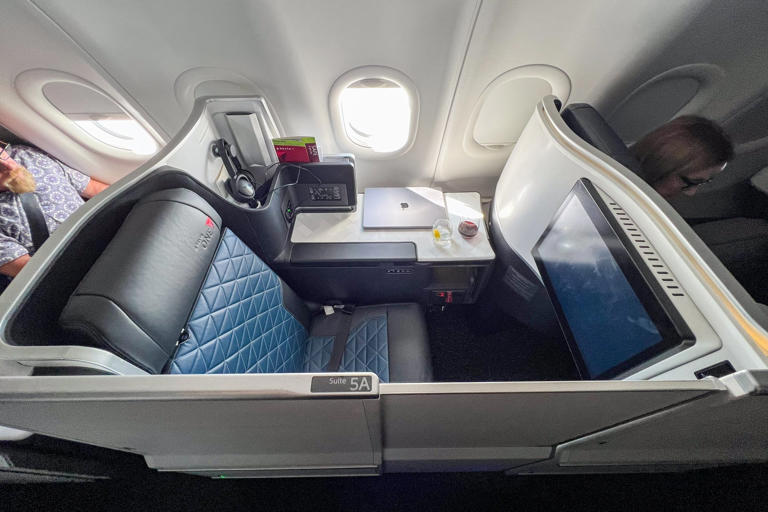
- Today's news
- Reviews and deals
- Climate change
- 2024 election
- Fall allergies
- Health news
- Mental health
- Sexual health
- Family health
- So mini ways
- Unapologetically
- Buying guides
Entertainment
- How to Watch
- My watchlist
- Stock market
- Biden economy
- Personal finance
- Stocks: most active
- Stocks: gainers
- Stocks: losers
- Trending tickers
- World indices
- US Treasury bonds
- Top mutual funds
- Highest open interest
- Highest implied volatility
- Currency converter
- Basic materials
- Communication services
- Consumer cyclical
- Consumer defensive
- Financial services
- Industrials
- Real estate
- Mutual funds
- Credit cards
- Credit card rates
- Balance transfer credit cards
- Business credit cards
- Cash back credit cards
- Rewards credit cards
- Travel credit cards
- Checking accounts
- Online checking accounts
- High-yield savings accounts
- Money market accounts
- Personal loans
- Student loans
- Car insurance
- Home buying
- Options pit
- Investment ideas
- Research reports
- Fantasy football
- Pro Pick 'Em
- College Pick 'Em
- Fantasy baseball
- Fantasy hockey
- Fantasy basketball
- Download the app
- Daily fantasy
- Scores and schedules
- GameChannel
- World Baseball Classic
- Premier League
- CONCACAF League
- Champions League
- Motorsports
- Horse racing
- Newsletters
New on Yahoo
- Privacy Dashboard
How To Prepare For Business Travel This Holiday Season
The fall season brought back the return of business travel for people around the world. Whether it’s a team offsite or a company-wide All Hands meeting, many travelers are gearing up to hit the skies for work this holiday season.
There are a few steps you can take to travel efficiently and comfortably during the holiday months. Although it’s one of the busiest travel times of the year, business travel this holiday season can be smooth, easy, and fun. While you should always practice diligent travel habits year-round, add a few of these pro tips as you travel for business this holiday season.
Book Your Plans In Advance
It’s exciting to prepare to head out of town on a business trip. Many people have been working from home since the pandemic. So in a remote work environment, linking up with your team in another city could be a good change of pace. However, nothing ruins a trip like last-minute preparations.
Be sure to communicate with your boss and team about flights, hotel arrangements, and the trip itinerary. Is the entire group staying at one hotel? Are you responsible for any of the costs associated with travel? Get clarity on all of these things and any other concerns before heading out of town.
Some companies use apps like TripActions to help organize corporate travel for their employees. Check-in with your boss to get on board with any tools that’ll help you plan your business travel plans in advance.
Depending on how long you’ll be traveling for business, take a good inventory of the items you’re packing. If you’ll only be traveling for a few days, there’s no reason to pack your entire wardrobe. By planning ahead, you should have an idea of your trip itinerary. Use this to map out what outfits you’ll wear for each planned occasion or meeting.
When traveling for business, some companies don’t pay for checked luggage. Packing light will help you fit your planned outfits into a carry-on-sized bag to avoid extra fees.
Create An Itinerary
Having an itinerary allows you to keep your trip organized from beginning to end. This is especially important during the holiday season when travel can be delayed, canceled, and overcrowded. Take time to plan your travel to and from the airport based on your flight times in advance. Your job may arrange travel for you, so it’s important to iron out all of the details.
Outlining your trip in an itinerary also allows you to plan out your after-work hours. Business travel doesn’t have to be all work and no play. You may want to invite your team members out for drinks or dinner. Or perhaps you have family or friends who live in town and you want to set up a time to visit them. Finetuning your travel itinerary for your business trips keeps you from missing opportunities or having unnecessary anxiety because you didn’t plan things out beforehand.
Make Sure Someone Covers Your Back While Traveling
Just because you’re traveling for business during the holiday season doesn’t mean your job stops relying on you. Most business trips happen during the work week. So if you’ll have a lapse in communication while traveling, be sure to communicate that with your boss or other team members.
It’s important to keep in mind that you’re traveling during the holiday season. So many employees will be on PTO during that time or spending time with loved ones. Be proactive by notifying your team of your business travel early to prevent confusion. If you have a heavy workload with tasks that need to be done, consider making an Out Of Office document detailing what needs to happen while you’re unavailable due to travel.
Layovers Are For Lounging
Due to the high volume of travelers funneling through airports, the holiday season is prime time for delayed flights and long layovers. Waiting can get exhausting and most airports aren’t set up for entertainment. If you’re a frequent traveler, this is a great opportunity to tap into lounge perks provided by your credit card company.
American Express, Citibank, Chase, and a few other companies offer airport lounge access with some of their premium travel credit cards. Depending on the lounge and airport location, travelers can enjoy buffets, free wifi, comfort, and privacy while they endure long layovers. If you want lounge access without needing a travel credit card, consider checking out LoungeBuddy where you can get passes for as low as $25.
Sign Up For PreCheck & CLEAR
Getting signed up for TSA PreCheck and CLEAR is one of the best decisions you can make when traveling for business during the holiday season. It only costs $85 and you won’t have to worry about taking off your shoes, unpacking your laptop, or liquids again.
The pass can be used at 180 US airports and typically gets travelers through TSA PreCheck in less than 10 minutes. Remember, holiday travel lines can get long so this is a great way to skip the lines especially if you’re in a hurry.
Don’t Fear Holiday Day Of Travel
While the holiday season is always a busy time, you’ll find many airports cleared out on the day of the actual holiday. These are excellent days to travel if you have no intention of being with family that day. Many travelers have already arrived at their destination by the day of so you’ll miss the holiday before-and-after rush.
Of course, you’ve called your bank to notify them of your travels so your debit cards won’t get shut down. But what happens if the ATMs at the airport or hotel aren’t working? Carrying cash keeps you covered in case of emergency when traveling for business. Be sure to keep all of your receipts in case your job reimburses you later.
Enjoy Yourself
Remember to enjoy yourself when traveling for business this holiday season. It doesn’t have to be all work and no play. Be open-minded to spending time with your co-workers while out of town. If no one is down to hang out, consider looking into other activities and excursions outside of work hours. Life is about balance so be sure you get a manageable dose of work and enjoyment when traveling during the holidays.
Recommended Stories
Nike responds to backlash over team usa track kits, notes athletes can wear shorts.
The new female track uniform looked noticeably skimpy at the bottom in one picture, which social media seized upon.
'Sasquatch Sunset' is so relentlessly gross that people are walking out of screenings. Star Jesse Eisenberg says the film was a ‘labor of love.’
“There are so many movies made for people who like typical things. This is not that," the film's star told Yahoo Entertainment.
UFC 300: Max Holloway takes 'BMF' title with one of the wildest KOs in MMA history
Max Holloway is a certified BMF. And then some.
76ers' statue for Allen Iverson draws jokes, outrage due to misunderstanding: 'That was disrespectful'
Iverson didn't get a life-size statue. Charles Barkley and Wilt Chamberlain didn't either.
UFC 300: Kayla Harrison introduces herself to UFC fans with utter domination of Holly Holm
Harrison was quick to call for a title fight after the win, and it's hard to imagine why she wouldn't get it.
Masters: Augusta National asked Jason Day to take off billboard sweater
At Augusta National, green jackets are a fashion statement. Sweaters with billboard-size logos, not so much.
Travis Kelce receives his University of Cincinnati diploma, chugs a beer on stage
Nobody is going to change the Kelce brothers.
UFC 300: Kayla Harrison makes weight before bantamweight bout versus Holly Holm
Kayla Harrison made the 135-pound weight limit required for her bantamweight bout at UFC 300 versus Holly Holm. It's the lowest weight at which she has ever fought.
UFC 300: Alex Pereira emphatically defends light heavyweight belt with 1st-round KO of Jamahal Hill
Alex Pereira is a dangerous man.
2025 Toyota 4Runner (finally!) revealed, and the new Trailhunter is extremely cool
The 2025 Toyota 4Runner is finally arriving this fall with a full lineup including returning TRD Pro and new Trailhunter. Hybrid power now available.
2024 NBA Awards: All-NBA, All-Defensive and All-Rookie selections
Here's one voter's awards ballot with All-NBA, All-Defensive and All-Rookie selections.
Republicans (?!?) are killing a tax cut
In a flip of the usual priorities, Senate Republicans seem likely to kill a set of tax cuts that have already passed the House and are broadly popular. Here's why.
2024 NBA Awards: Official picks for MVP, Rookie of the Year and every individual honor
With the 2023-24 NBA season coming to an end, here's one voter's award ballot, breaking down the top candidates — and declaring the winners.
Alex Sarr, potential No. 1 pick, declares for 2024 NBA Draft
International basketball prospect Alex Sarr declared for the 2024 NBA Draft. Playing this season for Perth in Australia's National Basketball League, Sarr is projected as a No. 1 overall selection.
2024 NFL Draft guide: 32 teams, 32 needs, picks, best fits and more
What selections does your team have? What areas should it address? Who's the dream fantasy pick? We cover all that and more for every franchise right here.
Fantasy Baseball Trade Analyzer: Players to sell high, buy low — and one to go all-in on
April is the perfect time of the season to buy low, sell low, buy high and sell high on key players — but you need to know who fits in what department. Fred Zinkie helps fantasy baseball managers with an initial batch.
Report: Alex Rodriguez and Marc Lore planned significant payroll cuts with Timberwolves
Alex Rodriguez and Marc Lore reportedly planned to bring the Timberwolves below the projected luxury tax threshold next season, which left Glen Taylor very concerned.
2024 NFL Draft: Top 100 big board goes in-depth on names to know ahead of marquee offseason event
Yahoo Sports' Nate Tice has Drake Maye at No. 1, Caleb Williams at No. 2, and a whole lot of intrigue after in a deep class at wide receiver, offensive line and cornerback.
NBA Playoff Picture: Everything at stake entering Friday with 17 teams still playing for seeding
Here are the latest updates on the landscape, including magic numbers, relevant tiebreakers and the stakes for Friday's slate of games.
Shohei Ohtani scandal: The 5 most surprising revelations of Ippei Mizuhara's criminal complaint
Ippei Mizuhara allegedly stole $16 million to help pay for his gambling habit that included 19,000 illegal bets.
- International edition
- Australia edition
- Europe edition

The experts: travel agents on 20 ways to book a sustainable and sensational summer holiday
Keen to get away? Here is how to find a great deal, pick the perfect destination and support the local community
A holiday should be relaxing, but booking one can be a fraught experience, with days lost to endless scrolling, comparing reviews and prices. How can you be sure you are getting a good deal? Travel agents share their tips for the most affordable, sustainable and memorable trips.
1. Book like an agent
“Everybody views themselves as a travel agent and they can be up to a point,” says Paul Sharp from Newcastle upon Tyne, who operates as part of the Travel Counsellors network and has 30 years’ experience in the industry. He says the rise of budget airlines and online booking have led to people feeling confident about organising trips themselves. What is the one thing we should know when doing so? “It is a false economy to book things separately because you have no protection,” Sharp says. He gives the example of someone planning a trip to South Africa to watch rugby, who booked flights with the airline and hotels directly and rugby tickets elsewhere. The game was cancelled but the flights and hotel were non-refundable. If they had been booked together, the trip would have been covered under package travel regulations. “Book with a company you trust and know – there are a lot of sites that crop up and you don’t really know their provenance,” he says.
2. Be an early bird
“Planning in advance is always going to be better value,” says Helen Youngman , an independent travel agent and partner at 360 Private Travel , based near Norwich. “Late deals do exist, but a lot of hotels use ‘dynamic pricing’, which means prices increase as availability goes down. Flights are only going to increase in price the closer you get to the departure date because the fuller the flight gets, the more expensive it will be.” Sharp adds: “Don’t hang on for a last-minute deal because you could end up disappointed. Scheduled flights tend to be available about 11 months in advance, so that is the best time to book. Also, at that stage, a lot of hotels and accommodation providers will have early-bird specials.”
3. If you do book late, be flexible

Jessica Bollinger, who works in the Bristol branch of Danish travel agent Kilroy , which specialises in youth and adventure holidays, agrees that late deals are now something of a myth. “They are not unheard of, but with a last-minute deal there are certain things you’re not going to get. So you have to be really open-minded as to where you’re going to go,” she says.
4. Avoid peak season
The cheapest time to travel is always outside the school holidays, says Youngman, with Christmas and new year the most expensive times. Can you get a good deal if you fly on Christmas or New Year’s Day itself? Sometimes, she says, “but a lot of people are catching on to that trick”. If you have to go in the school holidays, be open to going somewhere off the beaten track. “Being clever about destinations is a good plan,” says Youngman. “In Europe, look farther east at places such as Montenegro, Albania and Georgia. And Morocco is a good summer destination for families.”
5. Midweek can be more affordable
“Midweek can be cheaper, it just depends on availability,” says Youngman. “A Thursday to Monday trip is going to be slightly more expensive than Monday to Friday, but all travel fares are based on availability, so the further in advance you can book, the better.”
6. Take out travel insurance when you book
A lot of people sort out their insurance at the airport, says Sharp, but it is best to do it as soon as you have booked your trip. He says: “Travel insurance doesn’t just cover you if you lose a bag or are poorly while you are away. It also covers you should you need to cancel for an insurable reason before you travel.” This includes illness or a bereavement.
7. On solo trips, consider a group tour

If you are travelling alone, “pretty much anywhere is possible”, says Youngman. “Embarking on your first solo trip can be daunting, which is why small group tours are an amazing way to travel with like-minded people. Some companies I work with are doing specialist female-only tours with visits to female entrepreneurs, co-operatives, makers and bakers. Small group tours are great because they handle all the logistics, include really immersive experiences and are safe. They pick you up from the airport, and from that point onwards, you’re travelling with other people and you’ve got an expert guide.”
8. Have a daily budget
“We advise setting a daily limit for yourself while travelling and then multiplying that number by the days you are away to get the amount to save for your spending money,” says Bollinger. “When you work it out like this, it makes a lot more sense in people’s minds, especially young people who don’t have much budgeting experience. It also keeps you accountable to yourself, so you don’t blow everything right at the beginning and then have nothing left for the end.” To stick to a tight budget, she says: “Cook food as you go along and use public transport instead of tourist buses – this will really help you save money.”
9. Consider all-inclusive options
“If you are going to spend a lot of time eating and drinking in the hotel, I recommend upgrading to an all-inclusive option if possible,” says Youngman, “especially if you’d like a cocktail or two and you’re grazing throughout the day. Otherwise it can all add up and when you check out it costs a fortune.” With active holidays such as skiing or safaris, she adds: “If you have the option to choose an all-inclusive package that includes the activities, food and drink, that is usually a more cost-effective way of travelling. Because sometimes they will really sting you on the extras and it will be more expensive.”
10. Work your way around the world
“A working holiday is a great way to fund your trip,” says Bollinger, who helps people book travel to Australia, New Zealand and Canada by organising working holidays so they can extend their stay. “A lot of jobs will be hospitality-related, but if you go to a more rural spot you can do farm work, and if you have qualifications already, sometimes those can be used. Working holidays in Canada are often at ski resorts near Vancouver, so you get the added benefit of being in a beautiful place to take advantage of the winter sports.”
11. Travel as sustainably as possible

“You can get to most places in Europe by train , so if you are open to slowing down and having a more relaxed itinerary, not only are you travelling more sustainably, but you have more time to absorb the culture surrounding you,” says Youngman. “Be good to the environment you are travelling to see.” She stresses the importance of limiting flights as much as possible, especially internally, and avoiding indirect long-haul options. “We highly recommend ‘open-jaw flights’, which means you fly into one destination and out of another, to limit the number of flights,” says Bollinger. “We also promote travelling for longer in one destination as opposed to trying to go to many in a short time, and travelling overland when possible, instead of taking multiple flights.”
12. Offset carbon emissions with a reputable company
When considering carbon from flights, says Thomas Power of Pura Aventura , a B Corp sustainable travel company in Brighton: “Don’t believe the airline schemes, or anyone else who promises you absolution for a few quid. While 85% of offset schemes may be worthless, there are high-quality carbon credits starting at about £20 a tonne.” These can be bought to compensate for CO 2 emissions. Companies such as “ C Level help you at least take positive action to balance your impact”, says Power.
13. Think of responsible travel as a ‘fair exchange’
When travelling, says Power, consider: “What are we giving and what are we receiving? Is it a fair exchange? Is somebody getting something in return for what I am receiving in this transaction?” This applies to everything from “taking a cruise to Venice and not giving anything to the city, to going camping in Sussex and getting a supermarket delivery to your tent instead of going to the village shop or buying eggs from the house down the road”. This concept of “fair exchange” can be beneficial for everyone, he says, by giving you access to unique experiences. “In terms of the economy, the less money that leaves the village, town or city, the better,” he says.
14. Embrace the great outdoors

If you camp out “you are closer to nature than any other accommodation option”, says Brodie Farrow, of the online camping and touring travel agent Pitchup . There are many benefits to this, she says: “It is really good for mental health. It is also a much more sustainable option: the carbon footprints of outdoor holidays tend to be much lower than hotel stays, as people travel by car rather than flying and it promotes local produce and low-impact activities such as hiking in the surrounding area. The accommodation or pitches are much less carbon intensive than hotels, too. And you have a positive impact on the community that you are visiting: camping attracts a higher number of customers at a lower cost than hotels do, which can help to underpin the viability of local facilities such as the shop, the bar and takeaway, and that benefits the wider community.”
15. If you are camping-phobic, glamp
“There really is something for everyone,” says Farrow. “You can get glamping accommodation with four-poster beds if you prefer camping in luxury, or you can go really wild and remote, with no facilities, out on your own and back to nature. I think you would be hard-pressed to say that there is nothing that appeals.” Although glamping has become a fairly pricey option, she says: “Some types are much cheaper than others. You can get some ‘pod-only’ camping accommodation, where you bring your own bedding, starting from £15 a night.”
16. If the weather is terrible …
… And you are under canvas, “try to keep your bedroom a wet-gear-free zone”, says Farrow. “Store and dry wet stuff in your porch area rather than in your bedroom compartment. Protect your equipment by putting it in plastic bags or dry bags. Don’t let anything touch your tent walls or you will have soggy socks.” For activities, she suggests, “swimming in the sea, because you are wet already, or going to the pub”. If you are disappointed by the weather on a non-camping holiday, “as annoying as it is, try to embrace it”, says Sharp. Many people come back from their holidays exhausted because they try to see and do everything when they’re away. Instead, he says: “Have a lie-in, ask local people which is the best restaurant for a long, lazy lunch and, most of all, relax and recharge your batteries – it’s a holiday after all.”
17. For best value destinations, try …

“Go for Belgrade over Berlin,” says Youngman. “It has an underground culture scene very similar to Berlin 20 years ago.” For backpackers, Bollinger suggests: “Some places in Central America can be really affordable. Nicaragua, Honduras and Guatemala are good options for someone wanting to think outside the box.” Sharp says there are more affordable options in “Cyprus, Bulgaria, Turkey and Egypt, compared with Spain and the Balearics, which are becoming increasingly expensive due to cost of living increases”. If you are looking for a staycation, North Yorkshire, Cumbria and Cornwall are some of the most popular UK locations on Pitchup, says Farrow, which can inflate the price. Locations such as Pembrokeshire and the Isle of Wight are cheaper.
18. For a trip of a lifetime that doesn’t cost the earth …
“North Macedonia is just amazing,” says Youngman. “Ohrid has beautiful cobbled streets, Ottoman architecture , fantastic food and wine and you can visit the most biodiverse lake in Europe.” Farrow says: “I camped at the foot of Ben Nevis last year before hiking up it. The weather was terrible but it was worth it for the unreal views.” While Bollinger’s most memorable trip was “Interrailing in Europe and finding a way to do things on my own. It was before smartphones, so it was a very interesting experience and built up my confidence in travelling.”
19. If in doubt, follow local people
“Live like a local person by taking local buses and eating in local spots,” says Bollinger. “It is going to save you money, and will also let you experience life in a different way.” Power adds: “People want to go to Peru but they never come back talking about Machu Picchu, they come back talking about the people they met. Buy local and connections will happen for you. In the absence of interaction with your host community, the things you see are just wallpaper.”
20. And remember: you get what you pay for
“If a deal looks too good to be true, it probably is,” says Sharp.
- The experts
Comments (…)
Most viewed.
You are using an outdated browser. Please upgrade your browser .
- Moscow Tours
Our 20 Best Moscow Tours of 2022
Join us on an unforgettable tour to Moscow, the capital of Russia. Imagine visiting Red Square, St. Basil’s the Kremlin and more. Moscow is one of Europe’s most vibrant cities and one of Russia’s most historical. All of our tours to Moscow are fully customizable and can be adjusted to fit any budget. Our most popular tours are listed below. Please click on the tour details to learn more or contact us for more information about our Moscow tours using the form at the side of the page. You can also schedule a call with one of our Russian travel specialists to learn more.

Classic Moscow
This is our most popular Moscow tour that includes all the most prominent sights. You will become acquainted with ancient Russia in the Kremlin, admire Russian art in the Tretyakov Gallery, listen to street musicians as you stroll along the Old Arbat street, and learn about Soviet times on the Moscow Metro tour.
Accommodation
PRIVATE TOUR

A Week in Moscow
This tour is a perfect choice for those who wish to get to know Moscow in depth. One of the highlights of this package is the KGB history tour which gives an interesting perspective on the Cold War. You will also have time for exploring the city on your own or doing extra sightseeing.


Weekend in Moscow
This tour is a great way to get acquainted with the capital of Russia if you are short of time. You will see all the main attractions of the city, the most important of which is the Kremlin - the heart of Russia. The tour starts on Friday and can be combined with a business trip.

Group Tour Moscow Break by Intourist
Russia's capital has so much to offer, from the Kremlin and the Metro to the Old Arbat street and the Tretyakov Gallery. Besides these sites, you will also visit a fascinating country estate which today is quite off the beaten path, Gorky Estate, where the Soviet leader Lenin spent the last months of his life.

Kolomenskoye Tour with transport
The history of Kolomenskoye stretches back for centuries. In 1380, Dmitri Donskoi’s army passed through Kolomenskoye on their way to the Kulikovo battlefield, and it was...
Tours by car

Kremlin, Red Sq., Cathedrals & Armory Tour
The Kremlin is truly a fascinating structure, at the same time it is an ancient tower, the city’s former military fortification, a palace, an armory, the sovereign treasury...
Walking tours

Kremlin, Red Sq., Cathedrals, Armory, Diamond Fund Tour

Old Arbat walking tour
You will be told of the street’s interesting history and view the street’s artisan culture. You will also have the opportunity to view and purchase souvenirs from the...

Tour to Sergiev Posad with transport
Considered by some to be the Russian Vatican, Sergiev Posad is the temporary residence of the Patriarch of the Russian Orthodox Church. The Trinity St. Sergius Monastery (Lavra)...

Tour to Kuskovo with transport
The Kuskovo Estate often called the Moscow Versailles due to its perfectly preserved French park, is an example of an 18th century, luxurious Moscow summer residence. Its history...

Tour to Tsaritsyno with transport
The Tsaritsyno Estate is located in the southern part of Moscow. The estate was constructed for Catherine the Great by the Russian architects Bazhenov and Kazakov in a romantic...

Moscow Metro and Old Arbat Tour
The Moscow Metro is one of the largest and most grandly built metro systems in the world. It was meant to be a showcase of the Soviet Union’s achievements for both the Russians...

Vodka Museum Tour with transport (excursion and vodka tasting)
Vodka is an important component of Russian life, an element of national identity and everyday culture. We invite you to visit the Vodka Museum and feel the atmosphere of long-gone...

Mikhail Bulgakov Apartment Museum
This apartment museum located close to Patriarch Ponds became the prototype of the "bad apartment" described in the novel "The Master and Margarita." Currently the museum's...

Kremlin, Red Sq., Cathedrals & Diamond Fund Tour

The State Museum of Lev Tolstoy Tour
Take this opportunity to learn more about the Russian writer Lev Tolstoy. During the visit to the museum you will see part of a vast collection of exhibits connected to Tolstoy...

Novodevichy Convent Tour with transport
Tour of the Novodevichy Monastery. Founded in 1524 by Grand Prince VasiliIoanovich, the original convent was enclosed by fortified walls and contained 12 towers. The structure...

City Tour with Visit to St. Basils & Red Sq. with transport
Panoramic City Tour. This Moscow tour is a great start to your trip and the best way to get acquainted with many of the city’s major highlights. Our professional guide will...

City Tour of Moscow
Head to the heart of Moscow with a professional guide on a 4-hour private walk through the city center. See Tverskaya and Old Arbat streets, Theatre Square with the world-famous...

Moscow Metro walking tour

Kremlin, Red Square and Cathedrals Tour

KGB Tour with transport
This is a very interesting and insightful tour. You will visit places connected with Stalin’s terror - a time of great repression and fear. You will be shown monuments to...

Soviet and Post-Soviet Moscow Tour
The tour begins with a drive or walk down Tverskaya Street – a Soviet masterpiece. In the years of Soviet power, Tverskaya began to undergo a transformation: it was widened...

Tretyakov State Gallery Tour
This world-famous gallery contains masterpieces of Russian art beginning in the 10th century up until today. You will view exquisite Russian icons and paintings from the 18th and...

Jewish Heritage of Moscow Tour
This tour offers a detailed look into the history and present-day life of the Jewish community of Moscow. On the tour, you will visit sites connected with the cultural and religious...

Vodka Museum Tour with transport (excursion only)

Lena, our guide in Moscow was excellent. She was very knowledgable and could answer any question we had for her. We liked that she could pick up on our interests and take us places we might not have thought of to go. When we realized that one of the places we had chosen to see would probably not be that interesting to us, she was able to arrange entry to the Diamond Fund and the Armoury for us. Riding the Metro with Lena was a real adventure and a lot of fun. In Saint Petersburg we found Anna well versed in the history of the Tsars and in the Hermitage collection. Arkady in Veliky Novgorod was a very good guide and answered all of our questions with ease. Novgorod was perhaps a long way to go for a day trip, but we did enjoy it. Vasily was a great driver to have and kept us safe with good humour and skill. We enjoyed ourselves so much, my daughter says she is already planning to return. We would both have no hesistation to recommend ExpresstoRussia to anyone we know.
Just wanted to let you know that My grandson Bruno and I couldn´t have been more pleased with our week in Moscow (6/15 - 6/21). We were absolutely enchanted with the whole experience, including getting lost a couple of times in the Metro during our free time. Although both our guides (both Eleanas) were excellent, I would particularly commend the first one (she took us to the Tatiakov, the KGB tour, and to that beautiful cemetery where so many great Russian artists, authors, composers, musicians, militarists, and politicians are buried). Her knowledge is encyclopedic; and her understanding of today´s Russia as a product of its past was, for us, truly enlightening. I will be taking another tour in Russia, with my wife, within the next two or three years. I will be in touch with you when the time comes. Meanwhile, I will refer you to other potential visitors to Russia as I meet them.
Tours to Moscow
Our Moscow tours are land only meaning that you arrange your own air travel to Russia and our expert staff meets you at the airport and handles everything else from there. Our online Airline Ticket booking system offers some of the most competitive rates to Russia available on the web so if you need tickets, please visit our Russian air ticket center . Rest assured that you will be taken great care of on one of our Moscow tours. Express to Russia has a fully staffed office in Moscow that will help to make your visit fun, informative and unforgettable. Please remember that of all these tours are private and can be adjusted to your taste. You can add, replace or skip some sights; you can add more days to the package or cut the tour short. Our specialists will be glad to help you create the tour of your dreams!

Moscow, a City Like No Other
Moscow is Russia’s largest city with a population of between 12 and 13 million. It is also Europe’s largest city and when you visit Moscow, you can feel it. The layout and architecture of the city is eclectic, ranging from crooked, ancient streets and alleyways to wide, bustling boulevards, from medieval churches to Stalin skyscrapers and to modern, glass buildings towering over everything and of course in the center of it all is the Kremlin and the magnificent Red Square. Moscow is also home to a fantastic, efficient and very beautiful metro system – each station having its own special design. In fact, Express to Russia’s Moscow metro tours and excursions are some of our most popular attractions that we offer. On our Moscow tours, you will see this and more.

Moscow Tours centering on Russian History
Moscow has a long and interesting history and has been the capital of Russia in many of its different iterations – capital of the Grand Duchy of Moscow , the Russian Empire and of course the Soviet Union (who could ever forget the Soviet Union?). Moscow, was founded in the 12th century by Prince Yuri Dolgaruki (Yuri of the long arms – he really did have long arms!). From that time on, it was home to the Russian Tsars until Peter the Great moved the capital to St. Petersburg in 1703. The city has survived invasions and sieges from the Mongols, the Tartars, the Poles, Lithuanians and Napoleon but has always persevered. Our Moscow tours will enlighten you on this great history and give you insights into Muscovites and their unique culture. Our Moscow tours show you what the city is like today but also brings to life the past. Moscow never seems to sleep and is bursting with energy. A Moscow tour with Express to Russia is truly the best way of getting to know Russia’s largest and most vibrant city.
Frequently Asked Questions From Our Travelers
What is the best time to visit moscow.
Any time of year is fine depending on what you plan to do. Summertime is pleasantly warm, ideal for exploring the city and its vibrant atmosphere, but Moscow will be much busier and accommodation is more expensive. Winter can be quite cold but beautiful nonetheless, and this is unproblematic if you intend to spend most of your trip in museums and galleries. There are also various festivals and events organised throughout the year. For more information about the best time to visit, read our guide
How many days are enough in Moscow?
If you plan your itinerary strategically and aren’t averse to a packed schedule, you can cover Moscow’s main sights over a long weekend. Most popular attractions are in the city centre, and the Moscow Metro allows you to cover much ground in a small amount of time. Ensure that your accommodation is fairly central and book tickets in advance, so that you can make the most of your days. For an informative and well-organised day out, check out our Moscow day tours with options to suit all interests.
Do they speak English in Moscow?
As Russia’s capital city, tourists are well accommodated in Moscow. There should be English-speaking staff in restaurants, bars, hotels, shops and attractions in tourist hotspots, and there are also English-speaking tourist police. Transport services have English translations on their maps and English announcements via intercom; alternatively, order taxis from the Yandex Taxi app (Russian Uber), though it’s unlikely that your taxi driver will speak English. If you get stuck and cannot communicate, it’s fine to use Google Translate.
Is it safe to travel to Moscow?
It is no less safe to travel to Moscow than to any European city if you exercise common sense and look after your belongings. As with every city some regions can be more unsavoury than others, but no tourist attractions are located there. The traffic in Moscow is notorious, so exercise caution when crossing roads. Do not take unlicensed taxis; book in advance or take public transport, which is widespread and perfectly safe. If you encounter any problems, look for the special tourist police who can help you. For more information, read our guide about staying safe in Russia .
Our travel brands include

Express to Russia
Join us on Facebook
We invite you to become a fan of our company on Facebook and read Russian news and travel stories. To become a fan, click here .
Join our own Russian Travel, Culture and Literature Club on Facebook. The club was created to be a place for everyone with an interest in Russia to get to know each other and share experiences, stories, pictures and advice. To join our club, please follow this link .
We use cookies to improve your experience on our Website, and to facilitate providing you with services available through our Website. To opt out of non-essential cookies, please click here . By continuing to use our Website, you accept our use of cookies, the terms of our Privacy Policy and Terms of Service . I agree
An official website of the United States Government
- Kreyòl ayisyen
- Search Toggle search Search Include Historical Content - Any - No Include Historical Content - Any - No Search
- Menu Toggle menu
- INFORMATION FOR…
- Individuals
- Business & Self Employed
- Charities and Nonprofits
- International Taxpayers
- Federal State and Local Governments
- Indian Tribal Governments
- Tax Exempt Bonds
- FILING FOR INDIVIDUALS
- How to File
- When to File
- Where to File
- Update Your Information
- Get Your Tax Record
- Apply for an Employer ID Number (EIN)
- Check Your Amended Return Status
- Get an Identity Protection PIN (IP PIN)
- File Your Taxes for Free
- Bank Account (Direct Pay)
- Payment Plan (Installment Agreement)
- Electronic Federal Tax Payment System (EFTPS)
- Your Online Account
- Tax Withholding Estimator
- Estimated Taxes
- Where's My Refund
- What to Expect
- Direct Deposit
- Reduced Refunds
- Amend Return
Credits & Deductions
- INFORMATION FOR...
- Businesses & Self-Employed
- Earned Income Credit (EITC)
- Child Tax Credit
- Clean Energy and Vehicle Credits
- Standard Deduction
- Retirement Plans
Forms & Instructions
- POPULAR FORMS & INSTRUCTIONS
- Form 1040 Instructions
- Form 4506-T
- POPULAR FOR TAX PROS
- Form 1040-X
- Circular 230
Future Developments
Who should use this publication.
Users of employer-provided vehicles.
Who doesn’t need to use this publication.
Volunteers.
Comments and suggestions.
Getting answers to your tax questions.
Getting tax forms, instructions, and publications.
Ordering tax forms, instructions, and publications.
- Useful Items - You may want to see:
Travel expenses defined.
Members of the Armed Forces.
Main place of business or work.
No main place of business or work.
Factors used to determine tax home.
Tax Home Different From Family Home
Temporary assignment vs. indefinite assignment.
Exception for federal crime investigations or prosecutions.
Determining temporary or indefinite.
Going home on days off.
Probationary work period.
Separating costs.
Travel expenses for another individual.
Business associate.
Bona fide business purpose.
Lavish or extravagant.
50% limit on meals.
Actual Cost
Incidental expenses.
Incidental-expenses-only method.
50% limit may apply.
Who can use the standard meal allowance.
Use of the standard meal allowance for other travel.
Amount of standard meal allowance.
Federal government's fiscal year.
Standard meal allowance for areas outside the continental United States.
Special rate for transportation workers.
Travel for days you depart and return.
Trip Primarily for Business
Trip primarily for personal reasons.
Public transportation.
Private car.
Travel entirely for business.
Travel considered entirely for business.
Exception 1—No substantial control.
Exception 2—Outside United States no more than a week.
Exception 3—Less than 25% of time on personal activities.
Exception 4—Vacation not a major consideration.
Travel allocation rules.
Counting business days.
Transportation day.
Presence required.
Day spent on business.
Certain weekends and holidays.
Nonbusiness activity on the way to or from your business destination.
Nonbusiness activity at, near, or beyond business destination.
Other methods.
Travel Primarily for Personal Reasons
Daily limit on luxury water travel.
Meals and entertainment.
Not separately stated.
Convention agenda.
North American area.
Reasonableness test.
Cruise Ships
Deduction may depend on your type of business.
Exceptions to the Rules
Entertainment events.
Entertainment facilities.
Club dues and membership fees.
Gift or entertainment.
Other rules for meals and entertainment expenses.
Costs to include or exclude.
Application of 50% limit.
When to apply the 50% limit.
Taking turns paying for meals.
1—Expenses treated as compensation.
2—Employee's reimbursed expenses.
3—Self-employed reimbursed expenses.
4—Recreational expenses for employees.
5—Advertising expenses.
6—Sale of meals.
Individuals subject to “hours of service” limits.
Incidental costs.
Exceptions.
- Illustration of transportation expenses.
Temporary work location.
No regular place of work.
Two places of work.
Armed Forces reservists.
Commuting expenses.
Parking fees.
Advertising display on car.
Hauling tools or instruments.
Union members' trips from a union hall.
Office in the home.
Examples of deductible transportation.
Choosing the standard mileage rate.
Standard mileage rate not allowed.
Five or more cars.
Personal property taxes.
Parking fees and tolls.
Sale, trade-in, or other disposition.
Business and personal use.
Employer-provided vehicle.
Interest on car loans.
Taxes paid on your car.
Sales taxes.
Fines and collateral.
Casualty and theft losses.
Depreciation and section 179 deductions.
Car defined.
Qualified nonpersonal use vehicles.
More information.
More than 50% business use requirement.
Limit on the amount of the section 179 deduction.
Limit for sport utility and certain other vehicles.
Limit on total section 179 deduction, special depreciation allowance, and depreciation deduction.
Cost of car.
Basis of car for depreciation.
When to elect.
How to elect.
Revoking an election.
Recapture of section 179 deduction.
Dispositions.
Combined depreciation.
Qualified car.
Election not to claim the special depreciation allowance.
Placed in service.
Car placed in service and disposed of in the same year.
Methods of depreciation.
More-than-50%-use test.
Qualified business use.
Use of your car by another person.
Business use changes.
Use for more than one purpose.
Change from personal to business use.
Unadjusted basis.
Improvements.
Car trade-in.
Effect of trade-in on basis.
Traded car used only for business.
Traded car used partly in business.
Modified Accelerated Cost Recovery System (MACRS).
Recovery period.
Depreciation methods.
MACRS depreciation chart.
Depreciation in future years.
Disposition of car during recovery period.
How to use the 2023 chart.
Trucks and vans.
Car used less than full year.
Reduction for personal use.
Section 179 deduction.
Deductions in years after the recovery period.
Unrecovered basis.
The recovery period.
How to treat unrecovered basis.
- Table 4-1. 2023 MACRS Depreciation Chart (Use To Figure Depreciation for 2023)
Qualified business use 50% or less in year placed in service.
Qualified business use 50% or less in a later year.
Excess depreciation.
Deductible payments.
Fair market value.
Figuring the inclusion amount.
Leased car changed from business to personal use.
Leased car changed from personal to business use.
Reporting inclusion amounts.
Casualty or theft.
Depreciation adjustment when you used the standard mileage rate.
Depreciation deduction for the year of disposition.
Documentary evidence.
Adequate evidence.
Canceled check.
Duplicate information.
Timely kept records.
Proving business purpose.
Confidential information.
Exceptional circumstances.
Destroyed records.
Separating expenses.
Combining items.
Car expenses.
Gift expenses.
Allocating total cost.
If your return is examined.
Reimbursed for expenses.
Examples of Records
Self-employed.
Both self-employed and an employee.
Statutory employees.
Reimbursement for personal expenses.
Income-producing property.
Value reported on Form W-2.
Full value included in your income.
Less than full value included in your income.
No reimbursement.
Reimbursement, allowance, or advance.
Reasonable period of time.
Employee meets accountable plan rules.
Accountable plan rules not met.
Failure to return excess reimbursements.
Reimbursement of nondeductible expenses.
Adequate Accounting
Related to employer.
The federal rate.
Regular federal per diem rate.
The standard meal allowance.
High-low rate.
Prorating the standard meal allowance on partial days of travel.
The standard mileage rate.
Fixed and variable rate (FAVR).
Reporting your expenses with a per diem or car allowance.
Allowance less than or equal to the federal rate.
Allowance more than the federal rate.
Travel advance.
Unproven amounts.
Per diem allowance more than federal rate.
Reporting your expenses under a nonaccountable plan.
Adequate accounting.
How to report.
Contractor adequately accounts.
Contractor doesn’t adequately account.
High-low method.
Regular federal per diem rate method.
Federal per diem rate method.
Information on use of cars.
Standard mileage rate.
Actual expenses.
Car rentals.
Transportation expenses.
Employee business expenses other than nonentertainment meals.
Non-entertainment-related meal expenses.
“Hours of service” limits.
Reimbursements.
Allocating your reimbursement.
After you complete the form.
Limits on employee business expenses.
1. Limit on meals and entertainment.
2. Limit on total itemized deductions.
Member of a reserve component.
Officials Paid on a Fee Basis
Special rules for married persons.
Where to report.
Impairment-Related Work Expenses of Disabled Employees
Preparing and filing your tax return.
Free options for tax preparation.
Using online tools to help prepare your return.
Need someone to prepare your tax return?
Employers can register to use Business Services Online.
IRS social media.
Watching IRS videos.
Online tax information in other languages.
Free Over-the-Phone Interpreter (OPI) Service.
Accessibility Helpline available for taxpayers with disabilities.
Getting tax forms and publications.
Getting tax publications and instructions in eBook format.
Access your online account (individual taxpayers only).
Get a transcript of your return.
Tax Pro Account.
Using direct deposit.
Reporting and resolving your tax-related identity theft issues.
Ways to check on the status of your refund.
Making a tax payment.
What if I can’t pay now?
Filing an amended return.
Checking the status of your amended return.
Understanding an IRS notice or letter you’ve received.
Responding to an IRS notice or letter.
Contacting your local TAC.
What Is TAS?
How can you learn about your taxpayer rights, what can tas do for you, how can you reach tas, how else does tas help taxpayers, low income taxpayer clinics (litcs), appendix a-1. inclusion amounts for passenger automobiles first leased in 2018, appendix a-2. inclusion amounts for passenger automobiles first leased in 2019, appendix a-3. inclusion amounts for passenger automobiles first leased in 2020, appendix a-4. inclusion amounts for passenger automobiles first leased in 2021, appendix a-5. inclusion amounts for passenger automobiles first leased in 2022, appendix a-6. inclusion amounts for passenger automobiles first leased in 2023, publication 463 - additional material, publication 463 (2023), travel, gift, and car expenses.
For use in preparing 2023 Returns
Publication 463 - Introductory Material
For the latest information about developments related to Pub. 463, such as legislation enacted after it was published, go to IRS.gov/Pub463 .
Standard mileage rate. For 2023, the standard mileage rate for the cost of operating your car for business use is 65.5 cents ($0.655) per mile. Car expenses and use of the standard mileage rate are explained in chapter 4.
Depreciation limits on cars, trucks, and vans. The first-year limit on the depreciation deduction, special depreciation allowance, and section 179 deduction for vehicles acquired before September 28, 2017, and placed in service during 2023, is $12,200. The first-year limit on depreciation, special depreciation allowance, and section 179 deduction for vehicles acquired after September 27, 2017, and placed in service during 2023 increases to $20,200. If you elect not to claim a special depreciation allowance for a vehicle placed in service in 2023, the amount increases to $12,200. Depreciation limits are explained in chapter 4.
Section 179 deduction. The maximum amount you can elect to deduct for section 179 property (including cars, trucks, and vans) you placed in service in tax years beginning in 2023 is $1,160,000. This limit is reduced by the amount by which the cost of section 179 property placed in service during the tax year exceeds $2,890,000. Section 179 deduction is explained in chapter 4.Also, the maximum section 179 expense deduction for sport utility vehicles placed in service in tax years beginning in 2023 is $28,900.
Temporary deduction of 100% business meals. The 100% deduction on certain business meals expenses as amended under the Taxpayer Certainty and Disaster Tax Relief Act of 2020, and enacted by the Consolidated Appropriations Act, 2021, has expired. Generally, the cost of business meals remains deductible, subject to the 50% limitation. See 50% Limit in chapter 2 for more information.
Photographs of missing children. The IRS is a proud partner with the National Center for Missing & Exploited Children® (NCMEC) . Photographs of missing children selected by the Center may appear in this publication on pages that would otherwise be blank. You can help bring these children home by looking at the photographs and calling 800-THE-LOST (800-843-5678) if you recognize a child.
Per diem rates. Current and prior per diem rates may be found on the U.S. General Services Administration (GSA) website at GSA.gov/travel/plan-book/per-diem-rates .
Introduction
You may be able to deduct the ordinary and necessary business-related expenses you have for:
Non-entertainment-related meals,
Transportation.
This publication explains:
What expenses are deductible,
How to report them on your return,
What records you need to prove your expenses, and
How to treat any expense reimbursements you may receive.
You should read this publication if you are an employee or a sole proprietor who has business-related travel, non-entertainment-related meals, gift, or transportation expenses.
If an employer-provided vehicle was available for your use, you received a fringe benefit. Generally, your employer must include the value of the use or availability of the vehicle in your income. However, there are exceptions if the use of the vehicle qualifies as a working condition fringe benefit (such as the use of a qualified nonpersonal use vehicle).
A working condition fringe benefit is any property or service provided to you by your employer, the cost of which would be allowable as an employee business expense deduction if you had paid for it.
A qualified nonpersonal use vehicle is one that isn’t likely to be used more than minimally for personal purposes because of its design. See Qualified nonpersonal use vehicles under Actual Car Expenses in chapter 4.
For information on how to report your car expenses that your employer didn’t provide or reimburse you for (such as when you pay for gas and maintenance for a car your employer provides), see Vehicle Provided by Your Employer in chapter 6.
Partnerships, corporations, trusts, and employers who reimburse their employees for business expenses should refer to the instructions for their required tax forms, for information on deducting travel, meals, and entertainment expenses.
If you are an employee, you won’t need to read this publication if all of the following are true.
You fully accounted to your employer for your work-related expenses.
You received full reimbursement for your expenses.
Your employer required you to return any excess reimbursement and you did so.
There is no amount shown with a code L in box 12 of your Form W-2, Wage and Tax Statement.
If you perform services as a volunteer worker for a qualified charity, you may be able to deduct some of your costs as a charitable contribution. See Out-of-Pocket Expenses in Giving Services in Pub. 526, Charitable Contributions, for information on the expenses you can deduct.
We welcome your comments about this publication and suggestions for future editions.
You can send us comments through IRS.gov/FormComments . Or, you can write to the Internal Revenue Service, Tax Forms and Publications, 1111 Constitution Ave. NW, IR-6526, Washington, DC 20224.
Although we can’t respond individually to each comment received, we do appreciate your feedback and will consider your comments and suggestions as we revise our tax forms, instructions, and publications. Don’t send tax questions, tax returns, or payments to the above address.
If you have a tax question not answered by this publication or the How To Get Tax Help section at the end of this publication, go to the IRS Interactive Tax Assistant page at IRS.gov/Help/ITA where you can find topics by using the search feature or viewing the categories listed.
Go to IRS.gov/Forms to download current and prior-year forms, instructions, and publications.
Go to IRS.gov/OrderForms to order current forms, instructions, and publications; call 800-829-3676 to order prior-year forms and instructions. The IRS will process your order for forms and publications as soon as possible. Don’t resubmit requests you’ve already sent us. You can get forms and publications faster online.
Useful Items
Publication
946 How To Depreciate Property
Form (and Instructions)
Schedule A (Form 1040) Itemized Deductions
Schedule C (Form 1040) Profit or Loss From Business (Sole Proprietorship)
Schedule F (Form 1040) Profit or Loss From Farming
2106 Employee Business Expenses
4562 Depreciation and Amortization (Including Information on Listed Property)
See How To Get Tax Help for information about getting these publications and forms.
If you temporarily travel away from your tax home, you can use this chapter to determine if you have deductible travel expenses.
This chapter discusses:
Traveling away from home,
Temporary assignment or job, and
What travel expenses are deductible.
For tax purposes, travel expenses are the ordinary and necessary expenses of traveling away from home for your business, profession, or job.
An ordinary expense is one that is common and accepted in your trade or business. A necessary expense is one that is helpful and appropriate for your business. An expense doesn’t have to be required to be considered necessary.
You will find examples of deductible travel expenses in Table 1-1 .
Traveling Away From Home
You are traveling away from home if:
Your duties require you to be away from the general area of your tax home (defined later) substantially longer than an ordinary day's work, and
You need to sleep or rest to meet the demands of your work while away from home.
You are a railroad conductor. You leave your home terminal on a regularly scheduled round-trip run between two cities and return home 16 hours later. During the run, you have 6 hours off at your turnaround point where you eat two meals and rent a hotel room to get necessary sleep before starting the return trip. You are considered to be away from home.
You are a truck driver. You leave your terminal and return to it later the same day. You get an hour off at your turnaround point to eat. Because you aren’t off to get necessary sleep and the brief time off isn’t an adequate rest period, you aren’t traveling away from home.
If you are a member of the U.S. Armed Forces on a permanent duty assignment overseas, you aren’t traveling away from home. You can’t deduct your expenses for meals and lodging. You can’t deduct these expenses even if you have to maintain a home in the United States for your family members who aren’t allowed to accompany you overseas. If you are transferred from one permanent duty station to another, you may have deductible moving expenses, which are explained in Pub. 3, Armed Forces' Tax Guide.
A naval officer assigned to permanent duty aboard a ship that has regular eating and living facilities has a tax home (explained next) aboard the ship for travel expense purposes.
To determine whether you are traveling away from home, you must first determine the location of your tax home.
Generally, your tax home is your regular place of business or post of duty, regardless of where you maintain your family home. It includes the entire city or general area in which your business or work is located.
If you have more than one regular place of business, your tax home is your main place of business. See Main place of business or work , later.
If you don’t have a regular or a main place of business because of the nature of your work, then your tax home may be the place where you regularly live. See No main place of business or work , later.
If you don’t have a regular or main place of business or post of duty and there is no place where you regularly live, you are considered an itinerant (a transient) and your tax home is wherever you work. As an itinerant, you can’t claim a travel expense deduction because you are never considered to be traveling away from home.
If you have more than one place of work, consider the following when determining which one is your main place of business or work.
The total time you ordinarily spend in each place.
The level of your business activity in each place.
Whether your income from each place is significant or insignificant.
You live in Cincinnati where you have a seasonal job for 8 months each year and earn $40,000. You work the other 4 months in Miami, also at a seasonal job, and earn $15,000. Cincinnati is your main place of work because you spend most of your time there and earn most of your income there.
You may have a tax home even if you don’t have a regular or main place of work. Your tax home may be the home where you regularly live.
If you don’t have a regular or main place of business or work, use the following three factors to determine where your tax home is.
You perform part of your business in the area of your main home and use that home for lodging while doing business in the area.
You have living expenses at your main home that you duplicate because your business requires you to be away from that home.
You haven’t abandoned the area in which both your historical place of lodging and your claimed main home are located; you have a member or members of your family living at your main home; or you often use that home for lodging.
If you satisfy all three factors, your tax home is the home where you regularly live. If you satisfy only two factors, you may have a tax home depending on all the facts and circumstances. If you satisfy only one factor, you are an itinerant; your tax home is wherever you work and you can’t deduct travel expenses.
You are single and live in Boston in an apartment you rent. You have worked for your employer in Boston for a number of years. Your employer enrolls you in a 12-month executive training program. You don’t expect to return to work in Boston after you complete your training.
During your training, you don’t do any work in Boston. Instead, you receive classroom and on-the-job training throughout the United States. You keep your apartment in Boston and return to it frequently. You use your apartment to conduct your personal business. You also keep up your community contacts in Boston. When you complete your training, you are transferred to Los Angeles.
You don’t satisfy factor (1) because you didn’t work in Boston. You satisfy factor (2) because you had duplicate living expenses. You also satisfy factor (3) because you didn’t abandon your apartment in Boston as your main home, you kept your community contacts, and you frequently returned to live in your apartment. Therefore, you have a tax home in Boston.
You are an outside salesperson with a sales territory covering several states. Your employer's main office is in Newark, but you don’t conduct any business there. Your work assignments are temporary, and you have no way of knowing where your future assignments will be located. You have a room in your married sister's house in Dayton. You stay there for one or two weekends a year, but you do no work in the area. You don’t pay your sister for the use of the room.
You don’t satisfy any of the three factors listed earlier. You are an itinerant and have no tax home.
If you (and your family) don’t live at your tax home (defined earlier), you can’t deduct the cost of traveling between your tax home and your family home. You also can’t deduct the cost of meals and lodging while at your tax home. See Example 1 , later.
If you are working temporarily in the same city where you and your family live, you may be considered as traveling away from home. See Example 2 , later.
You are a truck driver and you and your family live in Tucson. You are employed by a trucking firm that has its terminal in Phoenix. At the end of your long runs, you return to your home terminal in Phoenix and spend one night there before returning home. You can’t deduct any expenses you have for meals and lodging in Phoenix or the cost of traveling from Phoenix to Tucson. This is because Phoenix is your tax home.
Your family home is in Pittsburgh, where you work 12 weeks a year. The rest of the year you work for the same employer in Baltimore. In Baltimore, you eat in restaurants and sleep in a rooming house. Your salary is the same whether you are in Pittsburgh or Baltimore.
Because you spend most of your working time and earn most of your salary in Baltimore, that city is your tax home. You can’t deduct any expenses you have for meals and lodging there. However, when you return to work in Pittsburgh, you are away from your tax home even though you stay at your family home. You can deduct the cost of your round trip between Baltimore and Pittsburgh. You can also deduct your part of your family's living expenses for non-entertainment-related meals and lodging while you are living and working in Pittsburgh.
Temporary Assignment or Job
You may regularly work at your tax home and also work at another location. It may not be practical to return to your tax home from this other location at the end of each workday.
If your assignment or job away from your main place of work is temporary, your tax home doesn’t change. You are considered to be away from home for the whole period you are away from your main place of work. You can deduct your travel expenses if they otherwise qualify for deduction. Generally, a temporary assignment in a single location is one that is realistically expected to last (and does in fact last) for 1 year or less.
However, if your assignment or job is indefinite, the location of the assignment or job becomes your new tax home and you can’t deduct your travel expenses while there. An assignment or job in a single location is considered indefinite if it is realistically expected to last for more than 1 year, whether or not it actually lasts for more than 1 year.
If your assignment is indefinite, you must include in your income any amounts you receive from your employer for living expenses, even if they are called “travel allowances” and you account to your employer for them. You may be able to deduct the cost of relocating to your new tax home as a moving expense. See Pub. 3 for more information.
If you are a federal employee participating in a federal crime investigation or prosecution, you aren’t subject to the 1-year rule. This means you may be able to deduct travel expenses even if you are away from your tax home for more than 1 year provided you meet the other requirements for deductibility.
For you to qualify, the Attorney General (or their designee) must certify that you are traveling:
For the federal government;
In a temporary duty status; and
To investigate, prosecute, or provide support services for the investigation or prosecution of a federal crime.
You must determine whether your assignment is temporary or indefinite when you start work. If you expect an assignment or job to last for 1 year or less, it is temporary unless there are facts and circumstances that indicate otherwise. An assignment or job that is initially temporary may become indefinite due to changed circumstances. A series of assignments to the same location, all for short periods but that together cover a long period, may be considered an indefinite assignment.
The following examples illustrate whether an assignment or job is temporary or indefinite.
You are a construction worker. You live and regularly work in Los Angeles. You are a member of a trade union in Los Angeles that helps you get work in the Los Angeles area. Your tax home is Los Angeles. Because of a shortage of work, you took a job on a construction project in Fresno. Your job was scheduled to end in 8 months. The job actually lasted 10 months.
You realistically expected the job in Fresno to last 8 months. The job actually did last less than 1 year. The job is temporary and your tax home is still in Los Angeles.
The facts are the same as in Example 1 , except that you realistically expected the work in Fresno to last 18 months. The job was actually completed in 10 months.
Your job in Fresno is indefinite because you realistically expected the work to last longer than 1 year, even though it actually lasted less than 1 year. You can’t deduct any travel expenses you had in Fresno because Fresno became your tax home.
The facts are the same as in Example 1 , except that you realistically expected the work in Fresno to last 9 months. After 8 months, however, you were asked to remain for 7 more months (for a total actual stay of 15 months).
Initially, you realistically expected the job in Fresno to last for only 9 months. However, due to changed circumstances occurring after 8 months, it was no longer realistic for you to expect that the job in Fresno would last for 1 year or less. You can deduct only your travel expenses for the first 8 months. You can’t deduct any travel expenses you had after that time because Fresno became your tax home when the job became indefinite.
If you go back to your tax home from a temporary assignment on your days off, you aren’t considered away from home while you are in your hometown. You can’t deduct the cost of your meals and lodging there. However, you can deduct your travel expenses, including meals and lodging, while traveling between your temporary place of work and your tax home. You can claim these expenses up to the amount it would have cost you to stay at your temporary place of work.
If you keep your hotel room during your visit home, you can deduct the cost of your hotel room. In addition, you can deduct your expenses of returning home up to the amount you would have spent for meals had you stayed at your temporary place of work.
If you take a job that requires you to move, with the understanding that you will keep the job if your work is satisfactory during a probationary period, the job is indefinite. You can’t deduct any of your expenses for meals and lodging during the probationary period.
What Travel Expenses Are Deductible?
Once you have determined that you are traveling away from your tax home, you can determine what travel expenses are deductible.
You can deduct ordinary and necessary expenses you have when you travel away from home on business. The type of expense you can deduct depends on the facts and your circumstances.
Table 1-1 summarizes travel expenses you may be able to deduct. You may have other deductible travel expenses that aren’t covered there, depending on the facts and your circumstances.
If you have one expense that includes the costs of non-entertainment-related meals, entertainment, and other services (such as lodging or transportation), you must allocate that expense between the cost of non-entertainment-related meals, and entertainment and the cost of other services. You must have a reasonable basis for making this allocation. For example, you must allocate your expenses if a hotel includes one or more meals in its room charge.
If a spouse, dependent, or other individual goes with you (or your employee) on a business trip or to a business convention, you generally can’t deduct their travel expenses.
You can deduct the travel expenses of someone who goes with you if that person:
Is your employee,
Has a bona fide business purpose for the travel, and
Would otherwise be allowed to deduct the travel expenses.
If a business associate travels with you and meets the conditions in (2) and (3) above, you can deduct the travel expenses you have for that person. A business associate is someone with whom you could reasonably expect to actively conduct business. A business associate can be a current or prospective (likely to become) customer, client, supplier, employee, agent, partner, or professional advisor.
Table 1-1. Travel Expenses You Can Deduct
A bona fide business purpose exists if you can prove a real business purpose for the individual's presence. Incidental services, such as typing notes or assisting in entertaining customers, aren’t enough to make the expenses deductible.
You drive to Chicago on business and take your spouse with you. Your spouse isn’t your employee. Your spouse occasionally types notes, performs similar services, and accompanies you to luncheons and dinners. The performance of these services doesn’t establish that your spouse’s presence on the trip is necessary to the conduct of your business. Your spouse’s expenses aren’t deductible.
You pay $199 a day for a double room. A single room costs $149 a day. You can deduct the total cost of driving your car to and from Chicago, but only $149 a day for your hotel room. If both you and your spouse use public transportation, you can only deduct your fare.
You can deduct a portion of the cost of meals if it is necessary for you to stop for substantial sleep or rest to properly perform your duties while traveling away from home on business. Meal and entertainment expenses are discussed in chapter 2 .
You can't deduct expenses for meals that are lavish or extravagant. An expense isn't considered lavish or extravagant if it is reasonable based on the facts and circumstances. Meal expenses won't be disallowed merely because they are more than a fixed dollar amount or because the meals take place at deluxe restaurants, hotels, or resorts.
You can figure your meal expenses using either of the following methods.
Actual cost.
If you are reimbursed for the cost of your meals, how you apply the 50% limit depends on whether your employer's reimbursement plan was accountable or nonaccountable. If you aren’t reimbursed, the 50% limit applies even if the unreimbursed meal expense is for business travel. Chapter 2 discusses the 50% Limit in more detail, and chapter 6 discusses accountable and nonaccountable plans.
You can use the actual cost of your meals to figure the amount of your expense before reimbursement and application of the 50% deduction limit. If you use this method, you must keep records of your actual cost.
Standard Meal Allowance
Generally, you can use the “standard meal allowance” method as an alternative to the actual cost method. It allows you to use a set amount for your daily meals and incidental expenses (M&IE), instead of keeping records of your actual costs. The set amount varies depending on where and when you travel. In this publication, “standard meal allowance” refers to the federal rate for M&IE, discussed later under Amount of standard meal allowance . If you use the standard meal allowance, you must still keep records to prove the time, place, and business purpose of your travel. See the recordkeeping rules for travel in chapter 5 .
The term “incidental expenses” means fees and tips given to porters, baggage carriers, hotel staff, and staff on ships.
Incidental expenses don’t include expenses for laundry, cleaning and pressing of clothing, lodging taxes, costs of telegrams or telephone calls, transportation between places of lodging or business and places where meals are taken, or the mailing cost of filing travel vouchers and paying employer-sponsored charge card billings.
You can use an optional method (instead of actual cost) for deducting incidental expenses only. The amount of the deduction is $5 a day. You can use this method only if you didn’t pay or incur any meal expenses. You can’t use this method on any day that you use the standard meal allowance. This method is subject to the proration rules for partial days. See Travel for days you depart and return , later, in this chapter.
The incidental-expenses-only method isn’t subject to the 50% limit discussed below.
If you use the standard meal allowance method for non-entertainment-related meal expenses and you aren’t reimbursed or you are reimbursed under a nonaccountable plan, you can generally deduct only 50% of the standard meal allowance. If you are reimbursed under an accountable plan and you are deducting amounts that are more than your reimbursements, you can deduct only 50% of the excess amount. The 50% Limit is discussed in more detail in chapter 2, and accountable and nonaccountable plans are discussed in chapter 6.
You can use the standard meal allowance whether you are an employee or self-employed, and whether or not you are reimbursed for your traveling expenses.
You can use the standard meal allowance to figure your meal expenses when you travel in connection with investment and other income-producing property. You can also use it to figure your meal expenses when you travel for qualifying educational purposes. You can’t use the standard meal allowance to figure the cost of your meals when you travel for medical or charitable purposes.
The standard meal allowance is the federal M&IE rate. For travel in 2023, the rate for most small localities in the United States is $59 per day.
Most major cities and many other localities in the United States are designated as high-cost areas, qualifying for higher standard meal allowances.
If you travel to more than one location in one day, use the rate in effect for the area where you stop for sleep or rest. If you work in the transportation industry, however, see Special rate for transportation workers , later.
Per diem rates are listed by the federal government's fiscal year, which runs from October 1 to September 30. You can choose to use the rates from the 2022 fiscal year per diem tables or the rates from the 2023 fiscal year tables, but you must consistently use the same tables for all travel you are reporting on your income tax return for the year. See Transition Rules , later.
The standard meal allowance rates above don’t apply to travel in Alaska, Hawaii, or any other location outside the continental United States. The Department of Defense establishes per diem rates for Alaska, Hawaii, Puerto Rico, American Samoa, Guam, Midway, the Northern Mariana Islands, the U.S. Virgin Islands, Wake Island, and other non-foreign areas outside the continental United States. The Department of State establishes per diem rates for all other foreign areas.
You can use a special standard meal allowance if you work in the transportation industry. You are in the transportation industry if your work:
Directly involves moving people or goods by airplane, barge, bus, ship, train, or truck; and
Regularly requires you to travel away from home and, during any single trip, usually involves travel to areas eligible for different standard meal allowance rates.
Using the special rate for transportation workers eliminates the need for you to determine the standard meal allowance for every area where you stop for sleep or rest. If you choose to use the special rate for any trip, you must use the special rate (and not use the regular standard meal allowance rates) for all trips you take that year.
For both the day you depart for and the day you return from a business trip, you must prorate the standard meal allowance (figure a reduced amount for each day). You can do so by one of two methods.
Method 1: You can claim 3 / 4 of the standard meal allowance.
Method 2: You can prorate using any method that you consistently apply and that is in accordance with reasonable business practice.
You are employed in New Orleans as a convention planner. In March, your employer sent you on a 3-day trip to Washington, DC, to attend a planning seminar. You left your home in New Orleans at 10 a.m. on Wednesday and arrived in Washington, DC, at 5:30 p.m. After spending 2 nights there, you flew back to New Orleans on Friday and arrived back home at 8 p.m. Your employer gave you a flat amount to cover your expenses and included it with your wages.
Under Method 1 , you can claim 2½ days of the standard meal allowance for Washington, DC: 3 / 4 of the daily rate for Wednesday and Friday (the days you departed and returned), and the full daily rate for Thursday.
Under Method 2 , you could also use any method that you apply consistently and that is in accordance with reasonable business practice. For example, you could claim 3 days of the standard meal allowance even though a federal employee would have to use Method 1 and be limited to only 2½ days.
Travel in the United States
The following discussion applies to travel in the United States. For this purpose, the United States includes the 50 states and the District of Columbia. The treatment of your travel expenses depends on how much of your trip was business related and on how much of your trip occurred within the United States. See Part of Trip Outside the United States , later.
You can deduct all of your travel expenses if your trip was entirely business related. If your trip was primarily for business and, while at your business destination, you extended your stay for a vacation, made a personal side trip, or had other personal activities, you can deduct only your business-related travel expenses. These expenses include the travel costs of getting to and from your business destination and any business-related expenses at your business destination.
You work in Atlanta and take a business trip to New Orleans in May. Your business travel totals 900 miles round trip. On your way home, you stop in Mobile to visit your parents. You spend $2,165 for the 9 days you are away from home for travel, non-entertainment-related meals, lodging, and other travel expenses. If you hadn’t stopped in Mobile, you would have been gone only 6 days, and your total cost would have been $1,633.50. You can deduct $1,633.50 for your trip, including the cost of round-trip transportation to and from New Orleans. The deduction for your non-entertainment-related meals is subject to the 50% limit on meals mentioned earlier.
If your trip was primarily for personal reasons, such as a vacation, the entire cost of the trip is a nondeductible personal expense. However, you can deduct any expenses you have while at your destination that are directly related to your business.
A trip to a resort or on a cruise ship may be a vacation even if the promoter advertises that it is primarily for business. The scheduling of incidental business activities during a trip, such as viewing videotapes or attending lectures dealing with general subjects, won’t change what is really a vacation into a business trip.
Part of Trip Outside the United States
If part of your trip is outside the United States, use the rules described later in this chapter under Travel Outside the United States for that part of the trip. For the part of your trip that is inside the United States, use the rules for travel in the United States. Travel outside the United States doesn’t include travel from one point in the United States to another point in the United States. The following discussion can help you determine whether your trip was entirely within the United States.
If you travel by public transportation, any place in the United States where that vehicle makes a scheduled stop is a point in the United States. Once the vehicle leaves the last scheduled stop in the United States on its way to a point outside the United States, you apply the rules under Travel Outside the United States , later.
You fly from New York to Puerto Rico with a scheduled stop in Miami. Puerto Rico isn’t considered part of the United States for purposes of travel. You return to New York nonstop. The flight from New York to Miami is in the United States, so only the flight from Miami to Puerto Rico is outside the United States. Because there are no scheduled stops between Puerto Rico and New York, all of the return trip is outside the United States.
Travel by private car in the United States is travel between points in the United States, even though you are on your way to a destination outside the United States.
You travel by car from Denver to Mexico City and return. Your travel from Denver to the border and from the border back to Denver is travel in the United States, and the rules in this section apply. The rules below under Travel Outside the United States apply to your trip from the border to Mexico City and back to the border.
Travel Outside the United States
If any part of your business travel is outside the United States, some of your deductions for the cost of getting to and from your destination may be limited. For this purpose, the United States includes the 50 states and the District of Columbia.
How much of your travel expenses you can deduct depends in part upon how much of your trip outside the United States was business related.
Travel Entirely for Business or Considered Entirely for Business
You can deduct all your travel expenses of getting to and from your business destination if your trip is entirely for business or considered entirely for business.
If you travel outside the United States and you spend the entire time on business activities, you can deduct all of your travel expenses.
Even if you didn’t spend your entire time on business activities, your trip is considered entirely for business if you meet at least one of the following four exceptions.
Your trip is considered entirely for business if you didn’t have substantial control over arranging the trip. The fact that you control the timing of your trip doesn’t, by itself, mean that you have substantial control over arranging your trip.
You don’t have substantial control over your trip if you:
Are an employee who was reimbursed or paid a travel expense allowance, and
Aren’t related to your employer, or
Aren’t a managing executive.
“Related to your employer” is defined later in chapter 6 under Per Diem and Car Allowances .
A “managing executive” is an employee who has the authority and responsibility, without being subject to the veto of another, to decide on the need for the business travel.
A self-employed person generally has substantial control over arranging business trips.
Your trip is considered entirely for business if you were outside the United States for a week or less, combining business and nonbusiness activities. One week means 7 consecutive days. In counting the days, don’t count the day you leave the United States, but do count the day you return to the United States.
You traveled to Brussels primarily for business. You left Denver on Tuesday and flew to New York. On Wednesday, you flew from New York to Brussels, arriving the next morning. On Thursday and Friday, you had business discussions, and from Saturday until Tuesday, you were sightseeing. You flew back to New York, arriving Wednesday afternoon. On Thursday, you flew back to Denver.
Although you were away from your home in Denver for more than a week, you weren’t outside the United States for more than a week. This is because the day you depart doesn’t count as a day outside the United States.
You can deduct your cost of the round-trip flight between Denver and Brussels. You can also deduct the cost of your stay in Brussels for Thursday and Friday while you conducted business. However, you can’t deduct the cost of your stay in Brussels from Saturday through Tuesday because those days were spent on nonbusiness activities.
Your trip is considered entirely for business if:
You were outside the United States for more than a week, and
You spent less than 25% of the total time you were outside the United States on nonbusiness activities.
You flew from Seattle to Tokyo, where you spent 14 days on business and 5 days on personal matters. You then flew back to Seattle. You spent 1 day flying in each direction.
Because only 5 / 21 (less than 25%) of your total time abroad was for nonbusiness activities, you can deduct as travel expenses what it would have cost you to make the trip if you hadn’t engaged in any nonbusiness activity. The amount you can deduct is the cost of the round-trip plane fare and 16 days of non-entertainment-related meals (subject to the 50% Limit ), lodging, and other related expenses.
Your trip is considered entirely for business if you can establish that a personal vacation wasn’t a major consideration, even if you have substantial control over arranging the trip.
Travel Primarily for Business
If you travel outside the United States primarily for business but spend some of your time on other activities, you generally can’t deduct all of your travel expenses. You can only deduct the business portion of your cost of getting to and from your destination. You must allocate the costs between your business and other activities to determine your deductible amount. See Travel allocation rules , later.
If your trip outside the United States was primarily for business, you must allocate your travel time on a day-to-day basis between business days and nonbusiness days. The days you depart from and return to the United States are both counted as days outside the United States.
To figure the deductible amount of your round-trip travel expenses, use the following fraction. The numerator (top number) is the total number of business days outside the United States. The denominator (bottom number) is the total number of business and nonbusiness days of travel.
Your business days include transportation days, days your presence was required, days you spent on business, and certain weekends and holidays.
Count as a business day any day you spend traveling to or from a business destination. However, if because of a nonbusiness activity you don’t travel by a direct route, your business days are the days it would take you to travel a reasonably direct route to your business destination. Extra days for side trips or nonbusiness activities can’t be counted as business days.
Count as a business day any day your presence is required at a particular place for a specific business purpose. Count it as a business day even if you spend most of the day on nonbusiness activities.
If your principal activity during working hours is the pursuit of your trade or business, count the day as a business day. Also, count as a business day any day you are prevented from working because of circumstances beyond your control.
Count weekends, holidays, and other necessary standby days as business days if they fall between business days. But if they follow your business meetings or activity and you remain at your business destination for nonbusiness or personal reasons, don’t count them as business days.
Your tax home is New York City. You travel to Quebec, where you have a business meeting on Friday. You have another meeting on the following Monday. Because your presence was required on both Friday and Monday, they are business days. Because the weekend is between business days, Saturday and Sunday are counted as business days. This is true even though you use the weekend for sightseeing, visiting friends, or other nonbusiness activity.
If, in Example 1 , you had no business in Quebec after Friday, but stayed until Monday before starting home, Saturday and Sunday would be nonbusiness days.
If you stopped for a vacation or other nonbusiness activity either on the way from the United States to your business destination, or on the way back to the United States from your business destination, you must allocate part of your travel expenses to the nonbusiness activity.
The part you must allocate is the amount it would have cost you to travel between the point where travel outside the United States begins and your nonbusiness destination and a return to the point where travel outside the United States ends.
You determine the nonbusiness portion of that expense by multiplying it by a fraction. The numerator (top number) of the fraction is the number of nonbusiness days during your travel outside the United States, and the denominator (bottom number) is the total number of days you spend outside the United States.
You live in New York. On May 4, you flew to Paris to attend a business conference that began on May 5. The conference ended at noon on May 14. That evening, you flew to Dublin where you visited with friends until the afternoon of May 21, when you flew directly home to New York. The primary purpose for the trip was to attend the conference.
If you hadn’t stopped in Dublin, you would have arrived home the evening of May 14. You don’t meet any of the exceptions that would allow you to consider your travel entirely for business. May 4 through May 14 (11 days) are business days and May 15 through May 21 (7 days) are nonbusiness days.
You can deduct the cost of your non-entertainment-related meals (subject to the 50% Limit ), lodging, and other business-related travel expenses while in Paris.
You can’t deduct your expenses while in Dublin. You also can’t deduct 7 / 18 of what it would have cost you to travel round trip between New York and Dublin.
You paid $750 to fly from New York to Paris, $400 to fly from Paris to Dublin, and $700 to fly from Dublin back to New York. Round-trip airfare from New York to Dublin would have been $1,250.
You figure the deductible part of your air travel expenses by subtracting 7 / 18 of the round-trip airfare and other expenses you would have had in traveling directly between New York and Dublin ($1,250 × 7 / 18 = $486) from your total expenses in traveling from New York to Paris to Dublin and back to New York ($750 + $400 + $700 = $1,850).
Your deductible air travel expense is $1,364 ($1,850 − $486).
If you had a vacation or other nonbusiness activity at, near, or beyond your business destination, you must allocate part of your travel expenses to the nonbusiness activity.
The part you must allocate is the amount it would have cost you to travel between the point where travel outside the United States begins and your business destination and a return to the point where travel outside the United States ends.
None of your travel expenses for nonbusiness activities at, near, or beyond your business destination are deductible.
Assume that the dates are the same as in the previous example but that instead of going to Dublin for your vacation, you fly to Venice, Italy, for a vacation.
You can’t deduct any part of the cost of your trip from Paris to Venice and return to Paris. In addition, you can’t deduct 7 / 18 of the airfare and other expenses from New York to Paris and back to New York.
You can deduct 11 / 18 of the round-trip plane fare and other travel expenses from New York to Paris, plus your non-entertainment-related meals (subject to the 50% Limit ), lodging, and any other business expenses you had in Paris. (Assume these expenses total $4,939.) If the round-trip plane fare and other travel-related expenses (such as food during the trip) are $1,750, you can deduct travel costs of $1,069 ( 11 / 18 × $1,750), plus the full $4,939 for the expenses you had in Paris.
You can use another method of counting business days if you establish that it more clearly reflects the time spent on other than business activities outside the United States.
If you travel outside the United States primarily for vacation or for investment purposes, the entire cost of the trip is a nondeductible personal expense. However, if you spend some time attending brief professional seminars or a continuing education program, you can deduct your registration fees and other expenses you have that are directly related to your business.
The university from which you graduated has a continuing education program for members of its alumni association. This program consists of trips to various foreign countries where academic exercises and conferences are set up to acquaint individuals in most occupations with selected facilities in several regions of the world. However, none of the conferences are directed toward specific occupations or professions. It is up to each participant to seek out specialists and organizational settings appropriate to their occupational interests.
Three-hour sessions are held each day over a 5-day period at each of the selected overseas facilities where participants can meet with individual practitioners. These sessions are composed of a variety of activities including workshops, mini-lectures, roleplaying, skill development, and exercises. Professional conference directors schedule and conduct the sessions. Participants can choose those sessions they wish to attend.
You can participate in this program because you are a member of the alumni association. You and your family take one of the trips. You spend about 2 hours at each of the planned sessions. The rest of the time you go touring and sightseeing with your family. The trip lasts less than 1 week.
Your travel expenses for the trip aren’t deductible since the trip was primarily a vacation. However, registration fees and any other incidental expenses you have for the five planned sessions you attended that are directly related and beneficial to your business are deductible business expenses. These expenses should be specifically stated in your records to ensure proper allocation of your deductible business expenses.
Luxury Water Travel
If you travel by ocean liner, cruise ship, or other form of luxury water transportation for business purposes, there is a daily limit on the amount you can deduct. The limit is twice the highest federal per diem rate allowable at the time of your travel. (Generally, the federal per diem is the amount paid to federal government employees for daily living expenses when they travel away from home within the United States for business purposes.)
The highest federal per diem rate allowed and the daily limit for luxury water travel in 2023 are shown in the following table.
You are a travel agent and traveled by ocean liner from New York to London, England, on business in May. Your expense for the 6-day cruise was $6,200. Your deduction for the cruise can’t exceed $4,776 (6 days × $796 daily limit).
If your expenses for luxury water travel include separately stated amounts for meals or entertainment, those amounts are subject to the 50% limit on non-entertainment-related meals and entertainment before you apply the daily limit. For a discussion of the 50% Limit , see chapter 2.
In the previous example, your luxury water travel had a total cost of $6,200. Of that amount, $3,700 was separately stated as non-entertainment-related meals and $1,000 was separately stated as entertainment. Considering that you are self-employed, you aren’t reimbursed for any of your travel expenses. You figure your deductible travel expenses as follows.
If your meal or entertainment charges aren’t separately stated or aren’t clearly identifiable, you don’t have to allocate any portion of the total charge to meals or entertainment.
The daily limit on luxury water travel (discussed earlier) doesn’t apply to expenses you have to attend a convention, seminar, or meeting on board a cruise ship. See Cruise Ships , later, under Conventions.
Conventions
You can deduct your travel expenses when you attend a convention if you can show that your attendance benefits your trade or business. You can’t deduct the travel expenses for your family.
If the convention is for investment, political, social, or other purposes unrelated to your trade or business, you can’t deduct the expenses.
The convention agenda or program generally shows the purpose of the convention. You can show your attendance at the convention benefits your trade or business by comparing the agenda with the official duties and responsibilities of your position. The agenda doesn’t have to deal specifically with your official duties and responsibilities; it will be enough if the agenda is so related to your position that it shows your attendance was for business purposes.
Conventions Held Outside the North American Area
You can’t deduct expenses for attending a convention, seminar, or similar meeting held outside the North American area unless:
The meeting is directly related to the active conduct of your trade or business, and
It is as reasonable to hold the meeting outside the North American area as within the North American area. See Reasonableness test , later.
The North American area includes the following locations.
The following factors are taken into account to determine if it was as reasonable to hold the meeting outside the North American area as within the North American area.
The purpose of the meeting and the activities taking place at the meeting.
The purposes and activities of the sponsoring organizations or groups.
The homes of the active members of the sponsoring organizations and the places at which other meetings of the sponsoring organizations or groups have been or will be held.
Other relevant factors you may present.
You can deduct up to $2,000 per year of your expenses of attending conventions, seminars, or similar meetings held on cruise ships. All ships that sail are considered cruise ships.
You can deduct these expenses only if all of the following requirements are met.
The convention, seminar, or meeting is directly related to the active conduct of your trade or business.
The cruise ship is a vessel registered in the United States.
All of the cruise ship's ports of call are in the United States or in territories of the United States.
You attach to your return a written statement signed by you that includes information about:
The total days of the trip (not including the days of transportation to and from the cruise ship port),
The number of hours each day that you devoted to scheduled business activities, and
A program of the scheduled business activities of the meeting.
You attach to your return a written statement signed by an officer of the organization or group sponsoring the meeting that includes:
A schedule of the business activities of each day of the meeting, and
The number of hours you attended the scheduled business activities.
2. Meals and Entertainment
You can no longer take a deduction for any expense related to activities generally considered entertainment, amusement, or recreation. You can continue to deduct 50% of the cost of business meals if you (or your employee) are present and the food or beverages aren't considered lavish or extravagant.
Entertainment
Entertainment—defined.
Entertainment includes any activity generally considered to provide entertainment, amusement, or recreation. Examples include entertaining guests at nightclubs; at social, athletic, and sporting clubs; at theaters; at sporting events; on yachts; or on hunting, fishing, vacation, and similar trips. Entertainment may also include meeting personal, living, or family needs of individuals, such as providing meals, a hotel suite, or a car to customers or their families.
Your kind of business may determine if a particular activity is considered entertainment. For example, if you are a dress designer and have a fashion show to introduce your new designs to store buyers, the show generally isn’t considered entertainment. This is because fashion shows are typical in your business. But, if you are an appliance distributor and hold a fashion show for the spouses of your retailers, the show is generally considered entertainment.
If you have one expense that includes the costs of entertainment and other services (such as lodging or transportation), you must allocate that expense between the cost of entertainment and the cost of other services. You must have a reasonable basis for making this allocation. For example, you must allocate your expenses if a hotel includes entertainment in its lounge on the same bill with your room charge.
In general, entertainment expenses are nondeductible. However, there are a few exceptions to the general rule, including:
Entertainment treated as compensation on your originally filed tax returns (and treated as wages to your employees);
Recreational expenses for employees such as a holiday party or a summer picnic;
Expenses related to attending business meetings or conventions of certain exempt organizations such as business leagues, chambers of commerce, professional associations, etc.; and
Entertainment sold to customers. For example, if you run a nightclub, your expenses for the entertainment you furnish to your customers, such as a floor show, aren’t subject to the nondeductible rules.
Examples of Nondeductible Entertainment
Generally, you can't deduct any expense for an entertainment event. This includes expenses for entertaining guests at nightclubs; at social, athletic, and sporting clubs; at theaters; at sporting events; on yachts; or on hunting, fishing, vacation, and similar trips.
Generally, you can’t deduct any expense for the use of an entertainment facility. This includes expenses for depreciation and operating costs such as rent, utilities, maintenance, and protection.
An entertainment facility is any property you own, rent, or use for entertainment. Examples include a yacht, hunting lodge, fishing camp, swimming pool, tennis court, bowling alley, car, airplane, apartment, hotel suite, or home in a vacation resort.
You can’t deduct dues (including initiation fees) for membership in any club organized for business, pleasure, recreation, or other social purposes.
This rule applies to any membership organization if one of its principal purposes is either:
To conduct entertainment activities for members or their guests; or
To provide members or their guests with access to entertainment facilities, discussed later.
The purposes and activities of a club, not its name, will determine whether or not you can deduct the dues. You can’t deduct dues paid to:
Country clubs,
Golf and athletic clubs,
Airline clubs,
Hotel clubs, and
Clubs operated to provide meals under circumstances generally considered to be conducive to business discussions.
Any item that might be considered either a gift or entertainment will generally be considered entertainment. However, if you give a customer packaged food or beverages that you intend the customer to use at a later date, treat it as a gift.
As discussed above, entertainment expenses are generally nondeductible. However, you may continue to deduct 50% of the cost of business meals if you (or an employee) is present and the food or beverages are not considered lavish or extravagant. The meals may be provided to a current or potential business customer, client, consultant, or similar business contact.
Food and beverages that are provided during entertainment events are not considered entertainment if purchased separately from the entertainment, or if the cost of the food and beverages is stated separately from the cost of the entertainment on one or more bills, invoices, or receipts. However, the entertainment disallowance rule may not be circumvented through inflating the amount charged for food and beverages.
Any allowed expense must be ordinary and necessary. An ordinary expense is one that is common and accepted in your trade or business. A necessary expense is one that is helpful and appropriate for your business. An expense doesn't have to be required to be considered necessary. Expenses must not be lavish or extravagant. An expense isn't considered lavish or extravagant if it is reasonable based on the facts and circumstances.
For each example, assume that the food and beverage expenses are ordinary and necessary expenses under section 162(a) paid or incurred during the tax year in carrying on a trade or business and are not lavish or extravagant under the circumstances. Also assume that the taxpayer and the business contact are not engaged in a trade or business that has any relation to the entertainment activity.
Taxpayer A invites B, a business contact, to a baseball game. A purchases tickets for A and B to attend the game. While at the game, A buys hot dogs and drinks for A and B. The baseball game is entertainment as defined in Regulations section 1.274-11(b)(1)(i) and, thus, the cost of the game tickets is an entertainment expense and is not deductible by A. The cost of the hot dogs and drinks, which are purchased separately from the game tickets, is not an entertainment expense and is not subject to the section 274(a)(1) disallowance. Therefore, A may deduct 50% of the expenses associated with the hot dogs and drinks purchased at the game.
Taxpayer C invites D, a business contact, to a basketball game. C purchases tickets for C and D to attend the game in a suite, where they have access to food and beverages. The cost of the basketball game tickets, as stated on the invoice, includes the food and beverages. The basketball game is entertainment as defined in Regulations section 1.274-11(b)(1)(i) and, thus, the cost of the game tickets is an entertainment expense and is not deductible by C. The cost of the food and beverages, which are not purchased separately from the game tickets, is not stated separately on the invoice. Thus, the cost of the food and beverages is also an entertainment expense that is subject to the section 274(a)(1) disallowance. Therefore, C may not deduct any of the expenses associated with the basketball game.
Assume the same facts as in Example 2 , except that the invoice for the basketball game tickets separately states the cost of the food and beverages. As in Example 2 , the basketball game is entertainment as defined in Regulations section 1.274-2(b)(1)(i) and, thus, the cost of the game tickets, other than the cost of the food and beverages, is an entertainment expense and is not deductible by C. However, the cost of the food and beverages, which is stated separately on the invoice for the game tickets, is not an entertainment expense and is not subject to the section 274(a)(1) disallowance. Therefore, C may deduct 50% of the expenses associated with the food and beverages provided at the game.
In general, you can deduct only 50% of your business-related meal expenses, unless an exception applies. (If you are subject to the Department of Transportation's “hours of service” limits, you can deduct 80% of your business-related meal expenses. See Individuals subject to hours of service limits , later.)
The 50% limit applies to employees or their employers, and to self-employed persons (including independent contractors) or their clients, depending on whether the expenses are reimbursed.
Examples of meals might include:
Meals while traveling away from home (whether eating alone or with others) on business, or
Meal at a business convention or business league meeting.
Figure A. Does the 50% Limit Apply to Your Expenses?
There are exceptions to these rules. See Exceptions to the 50% Limit for Meals , later.
Figure A. Does the 50% limit apply to Your Expenses?TAs for Figure A are: Notice 87-23; Form 2106 instructions
Summary: This is a flowchart used to determine if employees and self-employed persons need to put a 50% limit on their business expense deductions.
This is the starting of the flowchart.
Decision (1)
Were your meal and entertainment expenses reimbursed? (Count only reimbursements your employer didn’t include in box 1 of your Form W-2. If self-employed, count only reimbursements from clients or customers that aren’t included on Form 1099-MISC, Miscellaneous Income.)
Decision (2)
If an employee, did you adequately account to your employer under an accountable plan? If self-employed, did you provide the payer with adequate records? (See Chapter 6.)
Decision (3)
Did your expenses exceed the reimbursement?
Decision (4)
Process (a)
Your meal and entertainment expenses are NOT subject to the limitations. However, since the reimbursement wasn’t treated as wages or as other taxable income, you can’t deduct the expenses.
Process (b)
Your nonentertainment meal expenses ARE subject to the 50% limit. Your entertainment expenses are nondeductible.
This is the ending of the flowchart.
Please click here for the text description of the image.
Taxes and tips relating to a business meal are included as a cost of the meal and are subject to the 50% limit. However, the cost of transportation to and from the meal is not treated as part of the cost and would not be subject to the limit.
The 50% limit on meal expenses applies if the expense is otherwise deductible and isn’t covered by one of the exceptions discussed later. Figure A can help you determine if the 50% limit applies to you.
The 50% limit also applies to certain meal expenses that aren’t business related. It applies to meal expenses you have for the production of income, including rental or royalty income. It also applies to the cost of meals included in deductible educational expenses.
The 50% limit will apply after determining the amount that would otherwise qualify for a deduction. You first have to determine the amount of meal expenses that would be deductible under the other rules discussed in this publication.
If a group of business acquaintances takes turns picking up each others' meal checks primarily for personal reasons, without regard to whether any business purposes are served, no member of the group can deduct any part of the expense.
You spend $200 (including tax and tip) for a business meal. If $110 of that amount isn’t allowable because it is lavish and extravagant, the remaining $90 is subject to the 50% limit. Your deduction can’t be more than $45 (50% (0.50) × $90).
You purchase two tickets to a concert for $200 for you and your client. Your deduction is zero because no deduction is allowed for entertainment expenses.
Exception to the 50% Limit for Meals
Your meal expense isn’t subject to the 50% limit if the expense meets one of the following exceptions.
In general, expenses for goods, services, and facilities, to the extent the expenses are treated by the taxpayer, with respect to entertainment, amusement, or recreation, as compensation to an employee and as wages to the employee for tax purposes.
If you are an employee, you aren’t subject to the 50% limit on expenses for which your employer reimburses you under an accountable plan. Accountable plans are discussed in chapter 6.
If you are self-employed, your deductible meal expenses aren’t subject to the 50% limit if all of the following requirements are met.
You have these expenses as an independent contractor.
Your customer or client reimburses you or gives you an allowance for these expenses in connection with services you perform.
You provide adequate records of these expenses to your customer or client. (See chapter 5 .)
In this case, your client or customer is subject to the 50% limit on the expenses.
You are a self-employed attorney who adequately accounts for meal expenses to a client who reimburses you for these expenses. You aren’t subject to the limitation on meal expenses. If the client can deduct the expenses, the client is subject to the 50% limit.
If you (as an independent contractor) have expenses for meals related to providing services for a client but don’t adequately account for and seek reimbursement from the client for those expenses, you are subject to the 50% limit on non-entertainment-related meals and the entertainment-related meal expenses are nondeductible to you.
You aren't subject to the 50% limit for expenses for recreational, social, or similar activities (including facilities) such as a holiday party or a summer picnic.
You aren’t subject to the 50% limit if you provide meals to the general public as a means of advertising or promoting goodwill in the community. For example, neither the expense of sponsoring a television or radio show nor the expense of distributing free food and beverages to the general public is subject to the 50% limit.
You aren’t subject to the 50% limit if you actually sell meals to the public. For example, if you run a restaurant, your expense for the food you furnish to your customers isn’t subject to the 50% limit.
You can deduct a higher percentage of your meal expenses while traveling away from your tax home if the meals take place during or incident to any period subject to the Department of Transportation's “hours of service” limits. The percentage is 80%.
Individuals subject to the Department of Transportation's “hours of service” limits include the following persons.
Certain air transportation workers (such as pilots, crew, dispatchers, mechanics, and control tower operators) who are under Federal Aviation Administration regulations.
Interstate truck operators and bus drivers who are under Department of Transportation regulations.
Certain railroad employees (such as engineers, conductors, train crews, dispatchers, and control operations personnel) who are under Federal Railroad Administration regulations.
Certain merchant mariners who are under Coast Guard regulations.
If you give gifts in the course of your trade or business, you may be able to deduct all or part of the cost. This chapter explains the limits and rules for deducting the costs of gifts.
You can deduct no more than $25 for business gifts you give directly or indirectly to each person during your tax year. A gift to a company that is intended for the eventual personal use or benefit of a particular person or a limited class of people will be considered an indirect gift to that particular person or to the individuals within that class of people who receive the gift.
If you give a gift to a member of a customer's family, the gift is generally considered to be an indirect gift to the customer. This rule doesn’t apply if you have a bona fide, independent business connection with that family member and the gift isn’t intended for the customer's eventual use.
If you and your spouse both give gifts, both of you are treated as one taxpayer. It doesn’t matter whether you have separate businesses, are separately employed, or whether each of you has an independent connection with the recipient. If a partnership gives gifts, the partnership and the partners are treated as one taxpayer.
You sell products to a local company. You and your spouse gave the local company three gourmet gift baskets to thank them for their business. You and your spouse paid $80 for each gift basket, or $240 total. Three of the local company's executives took the gift baskets home for their families' use. You and your spouse have no independent business relationship with any of the executives' other family members. You and your spouse can deduct a total of $75 ($25 limit × 3) for the gift baskets.
Incidental costs, such as engraving on jewelry, or packaging, insuring, and mailing, are generally not included in determining the cost of a gift for purposes of the $25 limit.
A cost is incidental only if it doesn’t add substantial value to the gift. For example, the cost of gift wrapping is an incidental cost. However, the purchase of an ornamental basket for packaging fruit isn’t an incidental cost if the value of the basket is substantial compared to the value of the fruit.
The following items aren’t considered gifts for purposes of the $25 limit.
An item that costs $4 or less and:
Has your name clearly and permanently imprinted on the gift, and
Is one of a number of identical items you widely distribute. Examples include pens, desk sets, and plastic bags and cases.
Signs, display racks, or other promotional material to be used on the business premises of the recipient.
Figure B. When Are Transportation Expenses Deductible?
Most employees and self-employed persons can use this chart. (Don’t use this chart if your home is your principal place of business. See Office in the home , later.)
Figure B. When Are Local Transportation Expenses Deductible?TAs for Figure B are: Reg 1.162-1(a); RR 55–109; RR 94–47
Summary: This illustration depicts the rules used to determine if transportation expenses are deductible.
The image then lists definitions for words used in the graphic:
Any item that might be considered either a gift or entertainment will generally be considered entertainment. However, if you give a customer packaged food or beverages you intend the customer to use at a later date, treat it as a gift.
4. Transportation
This chapter discusses expenses you can deduct for business transportation when you aren’t traveling away from home , as defined in chapter 1. These expenses include the cost of transportation by air, rail, bus, taxi, etc., and the cost of driving and maintaining your car.
Transportation expenses include the ordinary and necessary costs of all of the following.
Getting from one workplace to another in the course of your business or profession when you are traveling within the city or general area that is your tax home. Tax home is defined in chapter 1.
Visiting clients or customers.
Going to a business meeting away from your regular workplace.
Getting from your home to a temporary workplace when you have one or more regular places of work. These temporary workplaces can be either within the area of your tax home or outside that area.
Daily transportation expenses you incur while traveling from home to one or more regular places of business are generally nondeductible commuting expenses. However, there may be exceptions to this general rule. You can deduct daily transportation expenses incurred going between your residence and a temporary work station outside the metropolitan area where you live. Also, daily transportation expenses can be deducted if (1) you have one or more regular work locations away from your residence; or (2) your residence is your principal place of business and you incur expenses going between the residence and another work location in the same trade or business, regardless of whether the work is temporary or permanent and regardless of the distance.
Illustration of transportation expenses.
Figure B above illustrates the rules that apply for deducting transportation expenses when you have a regular or main job away from your home. You may want to refer to it when deciding whether you can deduct your transportation expenses.
If you have one or more regular work locations away from your home and you commute to a temporary work location in the same trade or business, you can deduct the expenses of the daily round-trip transportation between your home and the temporary location, regardless of distance.
If your employment at a work location is realistically expected to last (and does in fact last) for 1 year or less, the employment is temporary unless there are facts and circumstances that would indicate otherwise.
If your employment at a work location is realistically expected to last for more than 1 year or if there is no realistic expectation that the employment will last for 1 year or less, the employment isn’t temporary, regardless of whether it actually lasts for more than 1 year.
If employment at a work location initially is realistically expected to last for 1 year or less, but at some later date the employment is realistically expected to last more than 1 year, that employment will be treated as temporary (unless there are facts and circumstances that would indicate otherwise) until your expectation changes. It won’t be treated as temporary after the date you determine it will last more than 1 year.
If the temporary work location is beyond the general area of your regular place of work and you stay overnight, you are traveling away from home. You may have deductible travel expenses, as discussed in chapter 1 .
If you have no regular place of work but ordinarily work in the metropolitan area where you live, you can deduct daily transportation costs between home and a temporary work site outside that metropolitan area.
Generally, a metropolitan area includes the area within the city limits and the suburbs that are considered part of that metropolitan area.
You can’t deduct daily transportation costs between your home and temporary work sites within your metropolitan area. These are nondeductible commuting expenses.
If you work at two places in 1 day, whether or not for the same employer, you can deduct the expense of getting from one workplace to the other. However, if for some personal reason you don’t go directly from one location to the other, you can’t deduct more than the amount it would have cost you to go directly from the first location to the second.
Transportation expenses you have in going between home and a part-time job on a day off from your main job are commuting expenses. You can’t deduct them.
A meeting of an Armed Forces reserve unit is a second place of business if the meeting is held on a day on which you work at your regular job. You can deduct the expense of getting from one workplace to the other as just discussed under Two places of work .
You usually can’t deduct the expense if the reserve meeting is held on a day on which you don’t work at your regular job. In this case, your transportation is generally a nondeductible commuting expense. However, you can deduct your transportation expenses if the location of the meeting is temporary and you have one or more regular places of work.
If you ordinarily work in a particular metropolitan area but not at any specific location and the reserve meeting is held at a temporary location outside that metropolitan area, you can deduct your transportation expenses.
If you travel away from home overnight to attend a guard or reserve meeting, you can deduct your travel expenses. These expenses are discussed in chapter 1 .
If you travel more than 100 miles away from home in connection with your performance of services as a member of the reserves, you may be able to deduct some of your reserve-related travel costs as an adjustment to gross income rather than as an itemized deduction. For more information, see Armed Forces Reservists Traveling More Than 100 Miles From Home under Special Rules in chapter 6.
You can’t deduct the costs of taking a bus, trolley, subway, or taxi, or of driving a car between your home and your main or regular place of work. These costs are personal commuting expenses. You can’t deduct commuting expenses no matter how far your home is from your regular place of work. You can’t deduct commuting expenses even if you work during the commuting trip.
You sometimes use your cell phone to make business calls while commuting to and from work. Sometimes business associates ride with you to and from work, and you have a business discussion in the car. These activities don’t change the trip from personal to business. You can’t deduct your commuting expenses.
Fees you pay to park your car at your place of business are nondeductible commuting expenses. You can, however, deduct business-related parking fees when visiting a customer or client.
Putting display material that advertises your business on your car doesn’t change the use of your car from personal use to business use. If you use this car for commuting or other personal uses, you still can’t deduct your expenses for those uses.
You can’t deduct the cost of using your car in a nonprofit car pool. Don’t include payments you receive from the passengers in your income. These payments are considered reimbursements of your expenses. However, if you operate a car pool for a profit, you must include payments from passengers in your income. You can then deduct your car expenses (using the rules in this publication).
Hauling tools or instruments in your car while commuting to and from work doesn’t make your car expenses deductible. However, you can deduct any additional costs you have for hauling tools or instruments (such as for renting a trailer you tow with your car).
If you get your work assignments at a union hall and then go to your place of work, the costs of getting from the union hall to your place of work are nondeductible commuting expenses. Although you need the union to get your work assignments, you are employed where you work, not where the union hall is located.
If you have an office in your home that qualifies as a principal place of business, you can deduct your daily transportation costs between your home and another work location in the same trade or business. (See Pub. 587, Business Use of Your Home, for information on determining if your home office qualifies as a principal place of business.)
The following examples show when you can deduct transportation expenses based on the location of your work and your home.
You regularly work in an office in the city where you live. Your employer sends you to a 1-week training session at a different office in the same city. You travel directly from your home to the training location and return each day. You can deduct the cost of your daily round-trip transportation between your home and the training location.
Your principal place of business is in your home. You can deduct the cost of round-trip transportation between your qualifying home office and your client's or customer's place of business.
You have no regular office, and you don’t have an office in your home. In this case, the location of your first business contact inside the metropolitan area is considered your office. Transportation expenses between your home and this first contact are nondeductible commuting expenses. Transportation expenses between your last business contact and your home are also nondeductible commuting expenses. While you can’t deduct the costs of these trips, you can deduct the costs of going from one client or customer to another.
Car Expenses
If you use your car for business purposes, you may be able to deduct car expenses. You can generally use one of the two following methods to figure your deductible expenses.
Actual car expenses.
The cost of using your car as an employee, whether measured using actual expenses or the standard mileage rate, will no longer be allowed to be claimed as an unreimbursed employee travel expense as a miscellaneous itemized deduction due to the suspension of miscellaneous itemized deductions that are subject to the 2% floor under section 67(a). The suspension applies to tax years beginning after December 2017 and before January 2026. Deductions for expenses that are deductible in determining adjusted gross income are not suspended. For example, Armed Forces reservists, qualified performing artists, and fee-basis state or local government officials are allowed to deduct unreimbursed employee travel expenses as an adjustment to total income on Schedule 1 (Form 1040), line 12.
If you use actual expenses to figure your deduction for a car you lease, there are rules that affect the amount of your lease payments you can deduct. See Leasing a Car , later.
In this publication, “car” includes a van, pickup, or panel truck. For the definition of “car” for depreciation purposes, see Car defined under Actual Car Expenses , later.
Standard Mileage Rate
For 2023, the standard mileage rate for the cost of operating your car for business use is 65.5 cents ($0.655) per mile.
You can generally use the standard mileage rate whether or not you are reimbursed and whether or not any reimbursement is more or less than the amount figured using the standard mileage rate. See chapter 6 for more information on reimbursements .
If you want to use the standard mileage rate for a car you own, you must choose to use it in the first year the car is available for use in your business. Then, in later years, you can choose to use either the standard mileage rate or actual expenses.
If you want to use the standard mileage rate for a car you lease, you must use it for the entire lease period. For leases that began on or before December 31, 1997, the standard mileage rate must be used for the entire portion of the lease period (including renewals) that is after 1997.
You must make the choice to use the standard mileage rate by the due date (including extensions) of your return. You can’t revoke the choice. However, in later years, you can switch from the standard mileage rate to the actual expenses method. If you change to the actual expenses method in a later year, but before your car is fully depreciated, you have to estimate the remaining useful life of the car and use straight line depreciation for the car’s remaining estimated useful life, subject to depreciation limits (discussed later).
For more information about depreciation included in the standard mileage rate, see Exception under Methods of depreciation , later.
You can’t use the standard mileage rate if you:
Use five or more cars at the same time (such as in fleet operations);
Claimed a depreciation deduction for the car using any method other than straight line for the car’s estimated useful life;
Used the Modified Accelerated Cost Recovery System (MACRS) (as discussed later under Depreciation Deduction );
Claimed a section 179 deduction (discussed later) on the car;
Claimed the special depreciation allowance on the car; or
Claimed actual car expenses after 1997 for a car you leased.
You can elect to use the standard mileage rate if you used a car for hire (such as a taxi) unless the standard mileage rate is otherwise not allowed, as discussed above.
If you own or lease five or more cars that are used for business at the same time, you can’t use the standard mileage rate for the business use of any car. However, you may be able to deduct your actual expenses for operating each of the cars in your business. See Actual Car Expenses , later, for information on how to figure your deduction.
You aren’t using five or more cars for business at the same time if you alternate using (use at different times) the cars for business.
The following examples illustrate the rules for when you can and can’t use the standard mileage rate for five or more cars.
A salesperson owns three cars and two vans that they alternate using for calling on their customers. The salesperson can use the standard mileage rate for the business mileage of the three cars and the two vans because they don’t use them at the same time.
You and your employees use your four pickup trucks in your landscaping business. During the year, you traded in two of your old trucks for two newer ones. You can use the standard mileage rate for the business mileage of all six of the trucks you owned during the year.
You own a repair shop and an insurance business. You and your employees use your two pickup trucks and van for the repair shop. You alternate using your two cars for the insurance business. No one else uses the cars for business purposes. You can use the standard mileage rate for the business use of the pickup trucks, the van, and the cars because you never have more than four vehicles used for business at the same time.
You own a car and four vans that are used in your housecleaning business. Your employees use the vans, and you use the car to travel to various customers. You can’t use the standard mileage rate for the car or the vans. This is because all five vehicles are used in your business at the same time. You must use actual expenses for all vehicles.
If you are an employee, you can’t deduct any interest paid on a car loan. This applies even if you use the car 100% for business as an employee.
However, if you are self-employed and use your car in your business, you can deduct that part of the interest expense that represents your business use of the car. For example, if you use your car 60% for business, you can deduct 60% of the interest on Schedule C (Form 1040). You can’t deduct the part of the interest expense that represents your personal use of the car.
If you itemize your deductions on Schedule A (Form 1040), you can deduct on line 5c state and local personal property taxes on motor vehicles. You can take this deduction even if you use the standard mileage rate or if you don’t use the car for business.
If you are self-employed and use your car in your business, you can deduct the business part of state and local personal property taxes on motor vehicles on Schedule C (Form 1040), or Schedule F (Form 1040). If you itemize your deductions, you can include the remainder of your state and local personal property taxes on the car on Schedule A (Form 1040).
In addition to using the standard mileage rate, you can deduct any business-related parking fees and tolls. (Parking fees you pay to park your car at your place of work are nondeductible commuting expenses.)
If you sell, trade in, or otherwise dispose of your car, you may have a gain or loss on the transaction or an adjustment to the basis of your new car. See Disposition of a Car , later.
Actual Car Expenses
If you don’t use the standard mileage rate, you may be able to deduct your actual car expenses.
Actual car expenses include:
If you have fully depreciated a car that you still use in your business, you can continue to claim your other actual car expenses. Continue to keep records, as explained later in chapter 5 .
If you use your car for both business and personal purposes, you must divide your expenses between business and personal use. You can divide your expense based on the miles driven for each purpose.
You are a contractor and drive your car 20,000 miles during the year: 12,000 miles for business use and 8,000 miles for personal use. You can claim only 60% (12,000 ÷ 20,000) of the cost of operating your car as a business expense.
If you use a vehicle provided by your employer for business purposes, you can deduct your actual unreimbursed car expenses. You can’t use the standard mileage rate. See Vehicle Provided by Your Employer in chapter 6.
If you are an employee, you can’t deduct any interest paid on a car loan. This interest is treated as personal interest and isn’t deductible. If you are self-employed and use your car in that business, see Interest , earlier, under Standard Mileage Rate.
If you are an employee, you can deduct personal property taxes paid on your car if you itemize deductions. Enter the amount paid on Schedule A (Form 1040), line 5c.
Generally, sales taxes on your car are part of your car's basis and are recovered through depreciation, discussed later.
You can’t deduct fines you pay or collateral you forfeit for traffic violations.
If your car is damaged, destroyed, or stolen, you may be able to deduct part of the loss not covered by insurance. See Pub. 547, Casualties, Disasters, and Thefts, for information on deducting a loss on your car.
Generally, the cost of a car, plus sales tax and improvements, is a capital expense. Because the benefits last longer than 1 year, you generally can’t deduct a capital expense. However, you can recover this cost through the section 179 deduction (the deduction allowed by section 179 of the Internal Revenue Code), special depreciation allowance, and depreciation deductions. Depreciation allows you to recover the cost over more than 1 year by deducting part of it each year. The section 179 deduction , special depreciation allowance , and depreciation deductions are discussed later.
Generally, there are limits on these deductions. Special rules apply if you use your car 50% or less in your work or business.
You can claim a section 179 deduction and use a depreciation method other than straight line only if you don’t use the standard mileage rate to figure your business-related car expenses in the year you first place a car in service.
If, in the year you first place a car in service, you claim either a section 179 deduction or use a depreciation method other than straight line for its estimated useful life, you can’t use the standard mileage rate on that car in any future year.
For depreciation purposes, a car is any four-wheeled vehicle (including a truck or van) made primarily for use on public streets, roads, and highways. Its unloaded gross vehicle weight (for trucks and vans, gross vehicle weight) must not be more than 6,000 pounds. A car includes any part, component, or other item physically attached to it or usually included in the purchase price.
A car doesn’t include:
An ambulance, hearse, or combination ambulance-hearse used directly in a business;
A vehicle used directly in the business of transporting persons or property for pay or hire; or
A truck or van that is a qualified nonpersonal use vehicle.
These are vehicles that by their nature aren’t likely to be used more than a minimal amount for personal purposes. They include trucks and vans that have been specially modified so that they aren’t likely to be used more than a minimal amount for personal purposes, such as by installation of permanent shelving and painting the vehicle to display advertising or the company's name. Delivery trucks with seating only for the driver, or only for the driver plus a folding jump seat, are qualified nonpersonal use vehicles.
See Depreciation Deduction , later, for more information on how to depreciate your vehicle.
Section 179 Deduction
You can elect to recover all or part of the cost of a car that is qualifying section 179 property, up to a limit, by deducting it in the year you place the property in service. This is the section 179 deduction. If you elect the section 179 deduction, you must reduce your depreciable basis in the car by the amount of the section 179 deduction.
You can claim the section 179 deduction only in the year you place the car in service. For this purpose, a car is placed in service when it is ready and available for a specifically assigned use in a trade or business. Even if you aren’t using the property, it is in service when it is ready and available for its specifically assigned use.
A car first used for personal purposes can’t qualify for the deduction in a later year when its use changes to business.
In 2022, you bought a new car and used it for personal purposes. In 2023, you began to use it for business. Changing its use to business use doesn’t qualify the cost of your car for a section 179 deduction in 2023. However, you can claim a depreciation deduction for the business use of the car starting in 2023. See Depreciation Deduction , later.
You must use the property more than 50% for business to claim any section 179 deduction. If you used the property more than 50% for business, multiply the cost of the property by the percentage of business use. The result is the cost of the property that can qualify for the section 179 deduction.
You purchased a new car in April 2023 for $24,500 and used it 60% for business. Based on your business usage, the total cost of your car that qualifies for the section 179 deduction is $14,700 ($24,500 cost × 60% (0.60) business use). But see Limit on total section 179, special depreciation allowance, and depreciation deduction , discussed later.
There are limits on:
The amount of the section 179 deduction;
The section 179 deduction for sport utility and certain other vehicles; and
The total amount of the section 179 deduction, special depreciation allowance, and depreciation deduction (discussed later ) you can claim for a qualified property.
For tax years beginning in 2023, the total amount you can elect to deduct under section 179 can’t be more than $1,160,000.
If the cost of your section 179 property placed in service in tax years beginning in 2023 is over $2,890,000, you must reduce the $1,160,000 dollar limit (but not below zero) by the amount of cost over $2,890,000. If the cost of your section 179 property placed in service during tax years beginning in 2023 is $4,050,000 or more, you can’t take a section 179 deduction.
The total amount you can deduct under section 179 each year after you apply the limits listed above cannot be more than the taxable income from the active conduct of any trade or business during the year.
If you are married and file a joint return, you and your spouse are treated as one taxpayer in determining any reduction to the dollar limit, regardless of which of you purchased the property or placed it in service.
If you and your spouse file separate returns, you are treated as one taxpayer for the dollar limit. You must allocate the dollar limit (after any reduction) between you.
For more information on the above section 179 deduction limits, see Pub. 946, How To Depreciate Property.
You cannot elect to deduct more than $28,900 of the cost of any heavy sport utility vehicle (SUV) and certain other vehicles placed in service during the tax years beginning in 2023. This rule applies to any four-wheeled vehicle primarily designed or used to carry passengers over public streets, roads, or highways that isn’t subject to any of the passenger automobile limits explained under Depreciation Limits , later, and that is rated at more than 6,000 pounds gross vehicle weight and not more than 14,000 pounds gross vehicle weight. However, the $28,900 limit doesn’t apply to any vehicle:
Designed to have a seating capacity of more than nine persons behind the driver's seat;
Equipped with a cargo area of at least 6 feet in interior length that is an open area or is designed for use as an open area but is enclosed by a cap and isn’t readily accessible directly from the passenger compartment; or
That has an integral enclosure, fully enclosing the driver compartment and load carrying device, doesn’t have seating rearward of the driver's seat, and has no body section protruding more than 30 inches ahead of the leading edge of the windshield.
The first-year limit on the depreciation deduction, special depreciation allowance, and section 179 deduction for vehicles acquired before September 28, 2017, and placed in service during 2023, is $12,200. The first-year limit on depreciation, special depreciation allowance, and section 179 deduction for vehicles acquired after September 27, 2017, and placed in service during 2023 increases to $20,200. If you elect not to claim a special depreciation allowance for a vehicle placed in service in 2023, the amount increases to $12,200. The limit is reduced if your business use of the vehicle is less than 100%. See Depreciation Limits , later, for more information.
In the earlier example under More than 50% business use requirement , you had a car with a cost (for purposes of the section 179 deduction) of $14,700. However, based on your business usage of the car, the total of your section 179 deduction, special depreciation allowance, and depreciation deductions is limited to $12,120 ($20,200 limit x 60% (0.60) business use) because the car was acquired after September 27, 2017, and placed in service during 2023.
For purposes of the section 179 deduction, the cost of the car doesn’t include any amount figured by reference to any other property held by you at any time. For example, if you buy a car as a replacement for a car that was stolen or that was destroyed in a casualty loss, and you use section 1033 to determine the basis in your replacement vehicle, your cost for purposes of the section 179 deduction doesn’t include your adjusted basis in the relinquished car. In that case, your cost includes only the cash you paid.
The amount of the section 179 deduction reduces your basis in your car. If you choose the section 179 deduction, you must subtract the amount of the deduction from the cost of your car. The resulting amount is the basis in your car you use to figure your depreciation deduction.
If you want to take the section 179 deduction, you must make the election in the tax year you place the car in service for business or work.
Employees use Form 2106, Employee Business Expenses, to make the election and report the section 179 deduction. All others use Form 4562, Depreciation and Amortization, to make an election.
File the appropriate form with either of the following.
Your original tax return filed for the year the property was placed in service (whether or not you file it timely).
An amended return filed within the time prescribed by law. An election made on an amended return must specify the item of section 179 property to which the election applies and the part of the cost of each such item to be taken into account. The amended return must also include any resulting adjustments to taxable income.
An election (or any specification made in the election) to take a section 179 deduction for 2023 can only be revoked with the Commissioner's approval.
To be eligible to claim the section 179 deduction, you must use your car more than 50% for business or work in the year you acquired it. If your business use of the car is 50% or less in a later tax year during the recovery period, you have to recapture (include in income) in that later year any excess depreciation. Any section 179 deduction claimed on the car is included in figuring the excess depreciation. For information on this calculation, see Excess depreciation , later in this chapter under Car Used 50% or Less for Business. For more information on recapture of a section 179 deduction, see Pub. 946.
If you dispose of a car on which you had claimed the section 179 deduction, the amount of that deduction is treated as a depreciation deduction for recapture purposes. You treat any gain on the disposition of the property as ordinary income up to the amount of the section 179 deduction and any allowable depreciation (unless you establish the amount actually allowed). For information on the disposition of a car, see Disposition of a Car , later. For more information on recapture of a section 179 deduction, see Pub. 946.
Special Depreciation Allowance
You may be able to claim the special depreciation allowance for your car, truck, or van if it is qualified property and was placed in service in 2023. The allowance for 2023 is an additional depreciation deduction for 100% of the car's depreciable basis (after any section 179 deduction, but before figuring your regular depreciation deduction under MACRS) if the vehicle was acquired after September 27, 2017, and placed in service during 2023. Further, while it applies to a new vehicle, it also applies to a used vehicle only if the vehicle meets the used property requirements. For more information on the used property requirements, see section 168(k)(2)(E)(ii). To qualify for the allowance, more than 50% of the use of the car must be in a qualified business use (as defined under Depreciation Deduction , later).
The first-year limit on the depreciation deduction, special depreciation allowance, and section 179 deduction for vehicles acquired before September 28, 2017, and placed in service during 2023, is $12,200. Your combined section 179 depreciation, special depreciation allowance, and regular MACRS depreciation deduction is limited to the maximum allowable depreciation deduction for vehicles acquired after September 27, 2017, and placed in service during 2023 is $20,200. If you elect not to claim a special depreciation allowance for a vehicle placed in service in 2023, the amount is $12,200. See Depreciation Limits , later in this chapter.
To be qualified property, the car (including the truck or van) must meet all of the following tests.
You acquired the car after September 27, 2017, but only if no written binding contract to acquire the car existed before September 28, 2017.
You acquired the car new or used.
You placed the car in service in your trade or business before January 1, 2027.
You used the car more than 50% in a qualified business use during the tax year.
You can elect not to claim the special depreciation allowance for your car, truck, or van that is qualified property. If you make this election, it applies to all 5-year property placed in service during the year.
To make this election, attach a statement to your timely filed return (including extensions) indicating the class of property (5-year for cars) for which you are making the election and that you are electing not to claim the special depreciation allowance for qualified property in that class of property.
Depreciation Deduction
If you use actual car expenses to figure your deduction for a car you own and use in your business, you can claim a depreciation deduction. This means you can deduct a certain amount each year as a recovery of your cost or other basis in your car.
You generally need to know the following things about the car you intend to depreciate.
Your basis in the car.
The date you place the car in service.
The method of depreciation and recovery period you will use.
Your basis in a car for figuring depreciation is generally its cost. This includes any amount you borrow or pay in cash, other property, or services.
Generally, you figure depreciation on your car, truck, or van using your unadjusted basis (see Unadjusted basis , later). However, in some situations, you will use your adjusted basis (your basis reduced by depreciation allowed or allowable in earlier years). For one of these situations, see Exception under Methods of depreciation , later.
If you change the use of a car from personal to business, your basis for depreciation is the lesser of the fair market value or your adjusted basis in the car on the date of conversion. Additional rules concerning basis are discussed later in this chapter under Unadjusted basis .
You generally place a car in service when it is available for use in your work or business, in an income-producing activity, or in a personal activity. Depreciation begins when the car is placed in service for use in your work or business or for the production of income.
For purposes of figuring depreciation, if you first start using the car only for personal use and later convert it to business use, you place the car in service on the date of conversion.
If you place a car in service and dispose of it in the same tax year, you can’t claim any depreciation deduction for that car.
Generally, you figure depreciation on cars using the Modified Accelerated Cost Recovery (MACRS) discussed later in this chapter.
If you used the standard mileage rate in the first year of business use and change to the actual expenses method in a later year, you can’t depreciate your car under the MACRS rules. You must use straight line depreciation over the estimated remaining useful life of the car. The amount you depreciate can’t be more than the depreciation limit that applies for that year. See Depreciation Limits , later.
To figure depreciation under the straight line method, you must reduce your basis in the car (but not below zero) by a set rate per mile for all miles for which you used the standard mileage rate. The rate per mile varies depending on the year(s) you used the standard mileage rate. For the rate(s) to use, see Depreciation adjustment when you used the standard mileage rate under Disposition of a Car , later.
This reduction of basis is in addition to those basis adjustments described later under Unadjusted basis . You must use your adjusted basis in your car to figure your depreciation deduction. For additional information on the straight line method of depreciation, see Pub. 946.
Generally, you must use your car more than 50% for qualified business use (defined next) during the year to use MACRS. You must meet this more-than-50%-use test each year of the recovery period (6 years under MACRS) for your car.
If your business use is 50% or less, you must use the straight line method to depreciate your car. This is explained later under Car Used 50% or Less for Business .
A qualified business use is any use in your trade or business. It doesn’t include use for the production of income (investment use), or use provided under lease to, or as compensation to, a 5% owner or related person. However, you do combine your business and investment use to figure your depreciation deduction for the tax year.
Don’t treat any use of your car by another person as use in your trade or business unless that use meets one of the following conditions.
It is directly connected with your business.
It is properly reported by you as income to the other person (and, if you have to, you withhold tax on the income).
It results in a payment of fair market rent. This includes any payment to you for the use of your car.
If you used your car more than 50% in qualified business use in the year you placed it in service, but 50% or less in a later year (including the year of disposition), you have to change to the straight line method of depreciation. See Qualified business use 50% or less in a later year under Car Used 50% or Less for Business , later.
If you use your car for more than one purpose during the tax year, you must allocate the use to the various purposes. You do this on the basis of mileage. Figure the percentage of qualified business use by dividing the number of miles you drive your car for business purposes during the year by the total number of miles you drive the car during the year for any purpose.
If you change the use of a car from 100% personal use to business use during the tax year, you may not have mileage records for the time before the change to business use. In this case, you figure the percentage of business use for the year as follows.
Determine the percentage of business use for the period following the change. Do this by dividing business miles by total miles driven during that period.
Multiply the percentage in (1) by a fraction. The numerator (top number) is the number of months the car is used for business, and the denominator (bottom number) is 12.
You use a car only for personal purposes during the first 6 months of the year. During the last 6 months of the year, you drive the car a total of 15,000 miles of which 12,000 miles are for business. This gives you a business use percentage of 80% (12,000 ÷ 15,000) for that period. Your business use for the year is 40% (80% (0.80) × 6 / 12 ).
The amount you can claim for section 179, special depreciation allowance, and depreciation deductions may be limited. The maximum amount you can claim depends on the year in which you placed your car in service. You have to reduce the maximum amount if you did not use the car exclusively for business. See Depreciation Limits , later.
You use your unadjusted basis (often referred to as your basis or your basis for depreciation) to figure your depreciation using the MACRS depreciation chart, explained later under Modified Accelerated Cost Recovery System (MACRS) . Your unadjusted basis for figuring depreciation is your original basis increased or decreased by certain amounts.
To figure your unadjusted basis, begin with your car's original basis, which is generally its cost. Cost includes sales taxes (see Sales taxes , earlier), destination charges, and dealer preparation. Increase your basis by any substantial improvements you make to your car, such as adding air conditioning or a new engine. Decrease your basis by any section 179 deduction, special depreciation allowance, gas guzzler tax, and vehicle credits claimed. See Pub. 551, Basis of Assets, for further details.
If you acquired the car by gift or inheritance, see Pub. 551, Basis of Assets, for information on your basis in the car.
A major improvement to a car is treated as a new item of 5-year recovery property. It is treated as placed in service in the year the improvement is made. It doesn’t matter how old the car is when the improvement is added. Follow the same steps for depreciating the improvement as you would for depreciating the original cost of the car. However, you must treat the improvement and the car as a whole when applying the limits on the depreciation deductions. Your car's depreciation deduction for the year (plus any section 179 deduction, special depreciation allowance, and depreciation on any improvements) can’t be more than the depreciation limit that applies for that year. See Depreciation Limits , later.
If you traded one car (the “old car”) for another car (the “new car”) in 2023, you must treat the transaction as a disposition of the old car and the purchase of the new car. You must treat the old car as disposed of at the time of the trade-in. The depreciable basis of the new car is the adjusted basis of the old car (figured as if 100% of the car’s use had been for business purposes) plus any additional amount you paid for the new car. You then figure your depreciation deduction for the new car beginning with the date you placed it in service. You must also complete Form 2106, Part II, Section D. This method is explained later, beginning at Effect of trade-in on basis .
The discussion that follows applies to trade-ins of cars in 2023, where the election was made to treat the transaction as a disposition of the old car and the purchase of the new car. For information on how to figure depreciation for cars involved in a like-kind exchange (trade-in) in 2023, for which the election wasn’t made, see Pub. 946 and Regulations section 1.168(i)-6(d)(3).
Like‐kind exchanges completed after December 31, 2017, are generally limited to exchanges of real property not held primarily for sale. Regulations section 1.168(i)-6 doesn't reflect this change in law.
If you trade in a car you used only in your business for another car that will be used only in your business, your original basis in the new car is your adjusted basis in the old car, plus any additional amount you pay for the new car.
You trade in a car that has an adjusted basis of $5,000 for a new car. In addition, you pay cash of $20,000 for the new car. Your original basis of the new car is $25,000 (your $5,000 adjusted basis in the old car plus the $20,000 cash paid). Your unadjusted basis is $25,000 unless you claim the section 179 deduction, special depreciation allowance, or have other increases or decreases to your original basis, discussed under Unadjusted basis , earlier.
If you trade in a car you used partly in your business for a new car you will use in your business, you must make a “trade-in” adjustment for the personal use of the old car. This adjustment has the effect of reducing your basis in your old car, but not below zero, for purposes of figuring your depreciation deduction for the new car. (This adjustment isn’t used, however, when you determine the gain or loss on the later disposition of the new car. See Pub. 544, Sales and Other Dispositions of Assets, for information on how to report the disposition of your car.)
To figure the unadjusted basis of your new car for depreciation, first add to your adjusted basis in the old car any additional amount you pay for the new car. Then subtract from that total the excess, if any, of:
The total of the amounts that would have been allowable as depreciation during the tax years before the trade if 100% of the use of the car had been business and investment use, over
The total of the amounts actually allowed as depreciation during those years.
MACRS is the name given to the tax rules for getting back (recovering) through depreciation deductions the cost of property used in a trade or business or to produce income.
The maximum amount you can deduct is limited, depending on the year you placed your car in service. See Depreciation Limits , later.
Under MACRS, cars are classified as 5-year property. You actually depreciate the cost of a car, truck, or van over a period of 6 calendar years. This is because your car is generally treated as placed in service in the middle of the year, and you claim depreciation for one-half of both the first year and the sixth year.
For more information on the qualifications for this shorter recovery period and the percentages to use in figuring the depreciation deduction, see chapter 4 of Pub. 946.
You can use one of the following methods to depreciate your car.
The 200% declining balance method (200% DB) over a 5-year recovery period that switches to the straight line method when that method provides an equal or greater deduction.
The 150% declining balance method (150% DB) over a 5-year recovery period that switches to the straight line method when that method provides an equal or greater deduction.
The straight line method (SL) over a 5-year recovery period.
Before choosing a method, you may wish to consider the following facts.
Using the straight line method provides equal yearly deductions throughout the recovery period.
Using the declining balance methods provides greater deductions during the earlier recovery years with the deductions generally getting smaller each year.
A 2023 MACRS Depreciation Chart and instructions are included in this chapter as Table 4-1 . Using this table will make it easy for you to figure the 2023 depreciation deduction for your car. A similar chart appears in the Instructions for Form 2106.
You must use the Depreciation Tables in Pub. 946 rather than the 2023 MACRS Depreciation Chart in this publication if any one of the following three conditions applies to you.
You file your return on a fiscal year basis.
You file your return for a short tax year (less than 12 months).
During the year, all of the following conditions apply.
You placed some property in service from January through September.
You placed some property in service from October through December.
Your basis in the property you placed in service from October through December (excluding nonresidential real property, residential rental property, and property placed in service and disposed of in the same year) was more than 40% of your total bases in all property you placed in service during the year.
If you use the percentages from the chart, you generally must continue to use them for the entire recovery period of your car. However, you can’t continue to use the chart if your basis in your car is adjusted because of a casualty. In that case, for the year of the adjustment and the remaining recovery period, figure the depreciation without the chart using your adjusted basis in the car at the end of the year of the adjustment and over the remaining recovery period. See Figuring the Deduction Without Using the Tables in chapter 4 of Pub. 946.
If you dispose of the car before the last year of the recovery period, you are generally allowed a half-year of depreciation in the year of disposition. This rule applies unless the mid-quarter convention applies to the vehicle being disposed of. See Depreciation deduction for the year of disposition under Disposition of a Car , later, for information on how to figure the depreciation allowed in the year of disposition.
To figure your depreciation deduction for 2023, find the percentage in the column of Table 4-1 based on the date that you first placed the car in service and the depreciation method that you are using. Multiply the unadjusted basis of your car (defined earlier) by that percentage to determine the amount of your depreciation deduction. If you prefer to figure your depreciation deduction without the help of the chart, see Pub. 946.
You bought a used truck in February 2022 to use exclusively in your landscape business. You paid $9,200 for the truck with no trade-in. You didn’t claim any section 179 deduction, the truck didn’t qualify for the special depreciation allowance, and you chose to use the 200% DB method to get the largest depreciation deduction in the early years.
You used the MACRS Depreciation Chart in 2022 to find your percentage. The unadjusted basis of the truck equals its cost because you used it exclusively for business. You multiplied the unadjusted basis of the truck, $9,200, by the percentage that applied, 20%, to figure your 2022 depreciation deduction of $1,840.
In 2023, you used the truck for personal purposes when you repaired your parent’s cabin. Your records show that the business use of the truck was 90% in 2023. You used Table 4-1 to find your percentage. Reading down the first column for the date placed in service and across to the 200% DB column, you locate your percentage, 32%. You multiply the unadjusted basis of the truck, $8,280 ($9,200 cost × 90% (0.90) business use), by 32% (0.32) to figure your 2023 depreciation deduction of $2,650.
Depreciation Limits
There are limits on the amount you can deduct for depreciation of your car, truck, or van. The section 179 deduction and special depreciation allowance are treated as depreciation for purposes of the limits. The maximum amount you can deduct each year depends on the date you acquired the passenger automobile and the year you place the passenger automobile in service. These limits are shown in the following tables for 2023.
Maximum Depreciation Deduction for Passenger Automobiles (Including Trucks and Vans) Acquired Before September 28, 2017, and Placed in Service During 2018–2023
Maximum depreciation deduction for passenger automobiles (including trucks and vans) acquired after september 27, 2017, and placed in service during 2018 or later.
The maximum amount you can deduct each year depends on the year you place the car in service. These limits are shown in the following tables for prior years.
Maximum Depreciation Deduction for Cars Placed in Service Prior to 2018
For tax years prior to 2018, the maximum depreciation deductions for trucks and vans are generally higher than those for cars. A truck or van is a passenger automobile that is classified by the manufacturer as a truck or van and rated at 6,000 pounds gross vehicle weight or less.
Maximum Depreciation Deduction for Trucks and Vans Placed in Service Prior to 2018
The depreciation limits aren’t reduced if you use a car for less than a full year. This means that you don’t reduce the limit when you either place a car in service or dispose of a car during the year. However, the depreciation limits are reduced if you don’t use the car exclusively for business and investment purposes. See Reduction for personal use next.
The depreciation limits are reduced based on your percentage of personal use. If you use a car less than 100% in your business or work, you must determine the depreciation deduction limit by multiplying the limit amount by the percentage of business and investment use during the tax year.
The section 179 deduction is treated as a depreciation deduction. If you acquired a passenger automobile (including trucks and vans) after September 27, 2017, and placed it in service in 2023, use it only for business, and choose the section 179 deduction, the special depreciation allowance and depreciation deduction for that vehicle for 2023 is limited to $20,200.
On September 4, 2023, you bought and placed in service a used car for $15,000. You used it 80% for your business, and you choose to take a section 179 deduction for the car. The car isn’t qualified property for purposes of the special depreciation allowance.
Before applying the limit, you figure your maximum section 179 deduction to be $12,000. This is the cost of your qualifying property (up to the maximum $1,160,000 amount) multiplied by your business use ($15,000 × 80% (0.80)).
You then figure that your section 179 deduction for 2023 is limited to $9,760 (80% of $12,200). You then figure your unadjusted basis of $2,440 (($15,000 × 80% (0.80)) − $9,760) for determining your depreciation deduction. You have reached your maximum depreciation deduction for 2023. For 2024, you will use your unadjusted basis of $2,440 to figure your depreciation deduction.
If the depreciation deductions for your car are reduced under the passenger automobile limits (discussed earlier), you will have unrecovered basis in your car at the end of the recovery period. If you continue to use your car for business, you can deduct that unrecovered basis (subject to depreciation limits) after the recovery period ends.
This is your cost or other basis in the car reduced by any clean-fuel vehicle deduction (for vehicles placed in service before January 1, 2006), alternative motor vehicle credit, electric vehicle credit, gas guzzler tax, and depreciation (including any special depreciation allowance , discussed earlier, unless you elect not to claim it) and section 179 deductions that would have been allowable if you had used the car 100% for business and investment use.
For 5-year property, your recovery period is 6 calendar years. A part year's depreciation is allowed in the first calendar year, a full year's depreciation is allowed in each of the next 4 calendar years, and a part year's depreciation is allowed in the 6th calendar year.
Under MACRS, your recovery period is the same whether you use declining balance or straight line depreciation. You determine your unrecovered basis in the 7th year after you placed the car in service.
If you continue to use your car for business after the recovery period, you can claim a depreciation deduction in each succeeding tax year until you recover your basis in the car. The maximum amount you can deduct each year is determined by the date you placed the car in service and your business-use percentage. For example, no deduction is allowed for a year you use your car 100% for personal purposes.
In April 2017, you bought and placed in service a car you used exclusively in your business. The car cost $31,500. You didn’t claim a section 179 deduction or the special depreciation allowance for the car. You continued to use the car 100% in your business throughout the recovery period (2017 through 2022). For those years, you used the MACRS Depreciation Chart (200% DB method), the Maximum Depreciation Deduction for Cars Placed in Service Prior to 2018 table and Maximum Depreciation Deduction for Passenger Automobiles (Including Trucks and Vans) Acquired Before September 28, 2017, and Placed in Service During 2018–2023 table, earlier, for the applicable tax year to figure your depreciation deductions during the recovery period. Your depreciation deductions were subject to the depreciation limits, so you will have unrecovered basis at the end of the recovery period as shown in the following table.
At the end of 2022, you had an unrecovered basis in the car of $14,626 ($31,500 – $16,874). If you continued to use the car 100% for business in 2023 and later years, you can claim a depreciation deduction equal to the lesser of $1,875 or your remaining unrecovered basis.
If your business use of the car was less than 100% during any year, your depreciation deduction would be less than the maximum amount allowable for that year. However, in determining your unrecovered basis in the car, you would still reduce your original basis by the maximum amount allowable as if the business use had been 100%. For example, if you had used your car 60% for business instead of 100%, your allowable depreciation deductions would have been $10,124 ($16,874 × 60% (0.60)), but you still would have to reduce your basis by $16,874 to determine your unrecovered basis.
Table 4-1. 2023 MACRS Depreciation Chart (Use To Figure Depreciation for 2023)
Car used 50% or less for business.
If you use your car 50% or less for qualified business use (defined earlier under Depreciation Deduction ) either in the year the car is placed in service or in a later year, special rules apply. The rules that apply in these two situations are explained in the following paragraphs. (For this purpose, “car” was defined earlier under Actual Car Expenses and includes certain trucks and vans.)
If you use your car 50% or less for qualified business use, the following rules apply.
You can’t take the section 179 deduction.
You can’t take the special depreciation allowance.
You must figure depreciation using the straight line method over a 5-year recovery period. You must continue to use the straight line method even if your percentage of business use increases to more than 50% in a later year.
Instead of making the computation yourself, you can use column (c) of Table 4-1 to find the percentage to use.
In May 2023, you bought and placed in service a car for $17,500. You used it 40% for your consulting business. Because you didn’t use the car more than 50% for business, you can’t take any section 179 deduction or special depreciation allowance, and you must use the straight line method over a 5-year recovery period to recover the cost of your car.
You deduct $700 in 2023. This is the lesser of:
$700 (($17,500 cost × 40% (0.40) business use) × 10% (0.10) recovery percentage (from column (c) of Table 4-1 )), or
$4,880 ($12,200 maximum limit × 40% (0.40) business use).
If you use your car more than 50% in qualified business use in the tax year it is placed in service but the business use drops to 50% or less in a later year, you can no longer use an accelerated depreciation method for that car.
For the year the business use drops to 50% or less and all later years in the recovery period, you must use the straight line depreciation method over a 5-year recovery period. In addition, for the year your business use drops to 50% or less, you must recapture (include in your gross income) any excess depreciation (discussed later). You also increase the adjusted basis of your car by the same amount.
In June 2020, you purchased a car for exclusive use in your business. You met the more-than-50%-use test for the first 3 years of the recovery period (2020 through 2022) but failed to meet it in the fourth year (2023). You determine your depreciation for 2023 using 20% (from column (c) of Table 4-1 ). You will also have to determine and include in your gross income any excess depreciation, discussed next.
You must include any excess depreciation in your gross income and add it to your car's adjusted basis for the first tax year in which you don’t use the car more than 50% in qualified business use. Use Form 4797, Sales of Business Property, to figure and report the excess depreciation in your gross income.
Excess depreciation is:
The amount of the depreciation deductions allowable for the car (including any section 179 deduction claimed and any special depreciation allowance claimed) for tax years in which you used the car more than 50% in qualified business use, minus
The amount of the depreciation deductions that would have been allowable for those years if you hadn’t used the car more than 50% in qualified business use for the year you placed it in service. This means the amount of depreciation figured using the straight line method.
In September 2019, you bought a car for $20,500 and placed it in service. You didn’t claim the section 179 deduction or the special depreciation allowance. You used the car exclusively in qualified business use for 2019, 2020, 2021, and 2022. For those years, you used the appropriate MACRS Depreciation Chart to figure depreciation deductions totaling $13,185 ($3,160 for 2019, $5,100 for 2020, $3,050 for 2021, and $1,875 for 2022) under the 200% DB method.
During 2023, you used the car 30% for business and 70% for personal purposes. Since you didn’t meet the more-than-50%-use test, you must switch from the 200% DB depreciation method to the straight line depreciation method for 2023, and include in gross income for 2023 your excess depreciation determined as follows.
In 2023, using Form 4797, you figure and report the $2,110 excess depreciation you must include in your gross income. Your adjusted basis in the car is also increased by $2,110. Your 2023 depreciation is $1,230 ($20,500 (unadjusted basis) × 30% (0.30) (business-use percentage) × 20% (0.20) (from column (c) of Table 4-1 on the line for Jan. 1–Sept. 30, 2019)). However, your depreciation deduction is limited to $563 ($1,875 x 30% (0.30) business use).
Leasing a Car
If you lease a car, truck, or van that you use in your business, you can use the standard mileage rate or actual expenses to figure your deductible expense. This section explains how to figure actual expenses for a leased car, truck, or van.
If you choose to use actual expenses, you can deduct the part of each lease payment that is for the use of the vehicle in your business. You can’t deduct any part of a lease payment that is for personal use of the vehicle, such as commuting.
You must spread any advance payments over the entire lease period. You can’t deduct any payments you make to buy a car, truck, or van even if the payments are called “lease payments.”
If you lease a car, truck, or van for 30 days or more, you may have to reduce your lease payment deduction by an “inclusion amount,” explained next.
Inclusion Amounts
If you lease a car, truck, or van that you use in your business for a lease term of 30 days or more, you may have to include an inclusion amount in your income for each tax year you lease the vehicle. To do this, you don’t add an amount to income. Instead, you reduce your deduction for your lease payment. (This reduction has an effect similar to the limit on the depreciation deduction you would have on the vehicle if you owned it.)
The inclusion amount is a percentage of part of the fair market value of the leased vehicle multiplied by the percentage of business and investment use of the vehicle for the tax year. It is prorated for the number of days of the lease term in the tax year.
The inclusion amount applies to each tax year that you lease the vehicle if the fair market value (defined next) when the lease began was more than the amounts shown in the following tables.
All vehicles are subject to a single inclusion amount threshold for passenger automobiles leased and put into service in 2023. You may have an inclusion amount for a passenger automobile if:
Passenger Automobiles (Including Trucks and Vans)
For years prior to 2018, see the inclusion tables below. You may have an inclusion amount for a passenger automobile if:
Cars (Except for Trucks and Vans)
Trucks and Vans
Fair market value is the price at which the property would change hands between a willing buyer and seller, neither having to buy or sell, and both having reasonable knowledge of all the necessary facts. Sales of similar property around the same date may be helpful in figuring the fair market value of the property.
Figure the fair market value on the first day of the lease term. If the capitalized cost of a car is specified in the lease agreement, use that amount as the fair market value.
Inclusion amounts for tax years 2018–2023 are listed in Appendices A-1 through A-6 for passenger vehicles (including trucks and vans). If the fair market value of the vehicle is $100,000 or less, use the appropriate appendix (depending on the year you first placed the vehicle in service) to determine the inclusion amount. If the fair market value is more than $100,000, see the revenue procedure(s) identified in the footnote of that year’s appendix for the inclusion amount.
For each tax year during which you lease the car for business, determine your inclusion amount by following these three steps.
Locate the appendix that applies to you. To find the inclusion amount, do the following.
Find the line that includes the fair market value of the car on the first day of the lease term.
Go across the line to the column for the tax year in which the car is used under the lease to find the dollar amount. For the last tax year of the lease, use the dollar amount for the preceding year.
Prorate the dollar amount from (1b) for the number of days of the lease term included in the tax year.
Multiply the prorated amount from (2) by the percentage of business and investment use for the tax year. This is your inclusion amount.
On January 17, 2023, you leased a car for 3 years and placed it in service for use in your business. The car had a fair market value of $62,500 on the first day of the lease term. You use the car 75% for business and 25% for personal purposes during each year of the lease. Assuming you continue to use the car 75% for business, you use Appendix A-6 to arrive at the following inclusion amounts for each year of the lease. For the last tax year of the lease, 2026, you use the amount for the preceding year.
2024 is a leap year and includes an extra calendar day, February 29, 2024.
For each year of the lease that you deduct lease payments, you must reduce your deduction by the inclusion amount figured for that year.
If you lease a car for business use and, in a later year, change it to personal use, follow the rules explained earlier under Figuring the inclusion amount . For the tax year in which you stop using the car for business, use the dollar amount for the previous tax year. Prorate the dollar amount for the number of days in the lease term that fall within the tax year.
On August 16, 2022, you leased a car with a fair market value of $64,500 for 3 years. You used the car exclusively in your data processing business. On November 6, 2023, you closed your business and went to work for a company where you aren’t required to use a car for business. Using Appendix A-5 , you figured your inclusion amount for 2022 and 2023 as shown in the following table and reduced your deductions for lease payments by those amounts.
If you lease a car for personal use and, in a later year, change it to business use, you must determine the car's fair market value on the date of conversion. Then figure the inclusion amount using the rules explained earlier under Figuring the inclusion amount . Use the fair market value on the date of conversion.
In March 2021, you leased a truck for 4 years for personal use. On June 1, 2023, you started working as a self-employed advertising consultant and started using the leased truck for business purposes. Your records show that your business use for June 1 through December 31 was 60%. To figure your inclusion amount for 2023, you obtained an appraisal from an independent car leasing company that showed the fair market value of your 2021 truck on June 1, 2023, was $62,650. Using Appendix A-6 , you figured your inclusion amount for 2023 as shown in the following table.
For information on reporting inclusion amounts, employees should see Car rentals under Completing Forms 2106 in chapter 6. Sole proprietors should see the Instructions for Schedule C (Form 1040), and farmers should see the Instructions for Schedule F (Form 1040).
Disposition of a Car
If you dispose of your car, you may have a taxable gain or a deductible loss. The portion of any gain that is due to depreciation (including any section 179 deduction, clean-fuel vehicle deduction (for vehicles placed in service before January 1, 2006), and special depreciation allowance) that you claimed on the car will be treated as ordinary income. However, you may not have to recognize a gain or loss if you dispose of the car because of a casualty or theft.
This section gives some general information about dispositions of cars. For information on how to report the disposition of your car, see Pub. 544.
Like‐kind exchanges completed after December 31, 2017, are generally limited to exchanges of real property not held primarily for sale.
For a casualty or theft, a gain results when you receive insurance or other reimbursement that is more than your adjusted basis in your car. If you then spend all of the proceeds to acquire replacement property (a new car or repairs to the old car) within a specified period of time, you don’t recognize any gain. Your basis in the replacement property is its cost minus any gain that isn’t recognized. See Pub. 547 for more information.
When you trade in an old car for a new one, the transaction is considered a like-kind exchange. Generally, no gain or loss is recognized. (For exceptions, see chapter 1 of Pub. 544.) In a trade-in situation, your basis in the new property is generally your adjusted basis in the old property plus any additional amount you pay. (See Unadjusted basis , earlier.)
If you used the standard mileage rate for the business use of your car, depreciation was included in that rate. The rate of depreciation that was allowed in the standard mileage rate is shown in the Rate of Depreciation Allowed in Standard Mileage Rate table, later. You must reduce your basis in your car (but not below zero) by the amount of this depreciation.
If your basis is reduced to zero (but not below zero) through the use of the standard mileage rate, and you continue to use your car for business, no adjustment (reduction) to the standard mileage rate is necessary. Use the full standard mileage rate (65.5 cents ($0.655) per mile from January 1–December 31 for 2023) for business miles driven.
Rate of Depreciation Allowed in Standard Mileage Rate
In 2018, you bought and placed in service a car for exclusive use in your business. The car cost $25,500. From 2018 through 2023, you used the standard mileage rate to figure your car expense deduction. You drove your car 14,100 miles in 2018, 16,300 miles in 2019, 15,600 miles in 2020, 16,700 miles in 2021, 15,100 miles in 2022, and 14,900 miles in 2023. The depreciation portion of your car expense deduction is figured as follows.
If you deduct actual car expenses and you dispose of your car before the end of the recovery period (years 2 through 5), you are allowed a reduced depreciation deduction in the year of disposition.
Use the depreciation tables in Pub. 946 to figure the reduced depreciation deduction for a car disposed of in 2023.
The depreciation amounts computed using the depreciation tables in Pub. 946 for years 2 through 5 that you own your car are for a full year’s depreciation. Years 1 and 6 apply the half-year or mid-quarter convention to the computation for you. If you dispose of the vehicle in years 2 through 5 and the half-year convention applies, then the full year’s depreciation amount must be divided by 2. If the mid-quarter convention applies, multiply the full year’s depreciation by the percentage from the following table for the quarter that you disposed of the car.
If the car is subject to the Depreciation Limits , discussed earlier, reduce (but do not increase) the computed depreciation to this amount. See Sale or Other Disposition Before the Recovery Period Ends in chapter 4 of Pub. 946 for more information.
5. Recordkeeping
If you deduct travel, gift, or transportation expenses, you must be able to prove (substantiate) certain elements of expense. This chapter discusses the records you need to keep to prove these expenses.
How To Prove Expenses
Table 5-1 is a summary of records you need to prove each expense discussed in this publication. You must be able to prove the elements listed across the top portion of the chart. You prove them by having the information and receipts (where needed) for the expenses listed in the first column.
You should keep adequate records to prove your expenses or have sufficient evidence that will support your own statement. You must generally prepare a written record for it to be considered adequate. This is because written evidence is more reliable than oral evidence alone. However, if you prepare a record on a computer, it is considered an adequate record.
What Are Adequate Records?
You should keep the proof you need in an account book, diary, log, statement of expense, trip sheets, or similar record. You should also keep documentary evidence that, together with your record, will support each element of an expense.
You must generally have documentary evidence such as receipts, canceled checks, or bills, to support your expenses.
Documentary evidence isn’t needed if any of the following conditions apply.
You have meals or lodging expenses while traveling away from home for which you account to your employer under an accountable plan, and you use a per diem allowance method that includes meals and/or lodging. ( Accountable plans and per diem allowances are discussed in chapter 6.)
Your expense, other than lodging, is less than $75.
You have a transportation expense for which a receipt isn’t readily available.
Documentary evidence will ordinarily be considered adequate if it shows the amount, date, place, and essential character of the expense.
For example, a hotel receipt is enough to support expenses for business travel if it has all of the following information.
The name and location of the hotel.
The dates you stayed there.
Separate amounts for charges such as lodging, meals, and telephone calls.
A restaurant receipt is enough to prove an expense for a business meal if it has all of the following information.
The name and location of the restaurant.
The number of people served.
The date and amount of the expense.
A canceled check, together with a bill from the payee, ordinarily establishes the cost. However, a canceled check by itself doesn’t prove a business expense without other evidence to show that it was for a business purpose.
You don‘t have to record information in your account book or other record that duplicates information shown on a receipt as long as your records and receipts complement each other in an orderly manner.
You don’t have to record amounts your employer pays directly for any ticket or other travel item. However, if you charge these items to your employer, through a credit card or otherwise, you must keep a record of the amounts you spend.
You should record the elements of an expense or of a business use at or near the time of the expense or use and support it with sufficient documentary evidence. A timely kept record has more value than a statement prepared later when there is generally a lack of accurate recall.
You don’t need to write down the elements of every expense on the day of the expense. If you maintain a log on a weekly basis that accounts for use during the week, the log is considered a timely kept record.
If you give your employer, client, or customer an expense account statement, it can also be considered a timely kept record. This is true if you copy it from your account book, diary, log, statement of expense, trip sheets, or similar record.
You must generally provide a written statement of the business purpose of an expense. However, the degree of proof varies according to the circumstances in each case. If the business purpose of an expense is clear from the surrounding circumstances, then you don’t need to give a written explanation.
If you are a sales representative who calls on customers on an established sales route, you don’t have to give a written explanation of the business purpose for traveling that route. You can satisfy the requirements by recording the length of the delivery route once, the date of each trip at or near the time of the trips, and the total miles you drove the car during the tax year. You could also establish the date of each trip with a receipt, record of delivery, or other documentary evidence.
You don’t need to put confidential information relating to an element of a deductible expense (such as the place, business purpose, or business relationship) in your account book, diary, or other record. However, you do have to record the information elsewhere at or near the time of the expense and have it available to fully prove that element of the expense.
What if I Have Incomplete Records?
If you don’t have complete records to prove an element of an expense, then you must prove the element with:
Your own written or oral statement containing specific information about the element, and
Other supporting evidence that is sufficient to establish the element.
If the element is the description of a gift, or the cost, time, place, or date of an expense, the supporting evidence must be either direct evidence or documentary evidence. Direct evidence can be written statements or the oral testimony of your guests or other witnesses setting forth detailed information about the element. Documentary evidence can be receipts, paid bills, or similar evidence.
If the element is either the business relationship of your guests or the business purpose of the amount spent, the supporting evidence can be circumstantial rather than direct. For example, the nature of your work, such as making deliveries, provides circumstantial evidence of the use of your car for business purposes. Invoices of deliveries establish when you used the car for business.
Table 5-1. How To Prove Certain Business Expenses
You can keep an adequate record for parts of a tax year and use that record to prove the amount of business or investment use for the entire year. You must demonstrate by other evidence that the periods for which an adequate record is kept are representative of the use throughout the tax year.
You use your car to visit the offices of clients, meet with suppliers and other subcontractors, and pick up and deliver items to clients. There is no other business use of the car, but you and your family use the car for personal purposes. You keep adequate records during the first week of each month that show that 75% of the use of the car is for business. Invoices and bills show that your business use continues at the same rate during the later weeks of each month. Your weekly records are representative of the use of the car each month and are sufficient evidence to support the percentage of business use for the year.
You can satisfy the substantiation requirements with other evidence if, because of the nature of the situation in which an expense is made, you can’t get a receipt. This applies if all the following are true.
You were unable to obtain evidence for an element of the expense or use that completely satisfies the requirements explained earlier under What Are Adequate Records .
You are unable to obtain evidence for an element that completely satisfies the two rules listed earlier under What if I Have Incomplete Records .
You have presented other evidence for the element that is the best proof possible under the circumstances.
If you can’t produce a receipt because of reasons beyond your control, you can prove a deduction by reconstructing your records or expenses. Reasons beyond your control include fire, flood, and other casualties.
Separating and Combining Expenses
This section explains when expenses must be kept separate and when expenses can be combined.
Each separate payment is generally considered a separate expense. For example, if you entertain a customer or client at dinner and then go to the theater, the dinner expense and the cost of the theater tickets are two separate expenses. You must record them separately in your records.
You can make one daily entry in your record for reasonable categories of expenses. Examples are taxi fares, telephone calls, or other incidental travel costs. Nonentertainment meals should be in a separate category. You can include tips for meal-related services with the costs of the meals.
Expenses of a similar nature occurring during the course of a single event are considered a single expense.
You can account for several uses of your car that can be considered part of a single use, such as a round trip or uninterrupted business use, with a single record. Minimal personal use, such as a stop for lunch on the way between two business stops, isn’t an interruption of business use.
You make deliveries at several different locations on a route that begins and ends at your employer's business premises and that includes a stop at the business premises between two deliveries. You can account for these using a single record of miles driven.
You don’t always have to record the name of each recipient of a gift. A general listing will be enough if it is evident that you aren’t trying to avoid the $25 annual limit on the amount you can deduct for gifts to any one person. For example, if you buy a large number of tickets to local high school basketball games and give one or two tickets to each of many customers, it is usually enough to record a general description of the recipients.
If you can prove the total cost of travel or entertainment but you can’t prove how much it costs for each person who participated in the event, you may have to allocate the total cost among you and your guests on a pro rata basis. To do so, you must establish the number of persons who participated in the event.
If your return is examined, you may have to provide additional information to the IRS. This information could be needed to clarify or to establish the accuracy or reliability of information contained in your records, statements, testimony, or documentary evidence before a deduction is allowed.
How Long To Keep Records and Receipts
You must keep records as long as they may be needed for the administration of any provision of the Internal Revenue Code. Generally, this means you must keep records that support your deduction (or an item of income) for 3 years from the date you file the income tax return on which the deduction is claimed. A return filed early is considered filed on the due date. For a more complete explanation of how long to keep records, see Pub. 583, Starting a Business and Keeping Records.
You must keep records of the business use of your car for each year of the recovery period. See More-than-50%-use test in chapter 4 under Depreciation Deduction.
Employees who give their records and documentation to their employers and are reimbursed for their expenses generally don’t have to keep copies of this information. However, you may have to prove your expenses if any of the following conditions apply.
You claim deductions for expenses that are more than reimbursements.
Your expenses are reimbursed under a nonaccountable plan.
Your employer doesn’t use adequate accounting procedures to verify expense accounts.
You are related to your employer as defined under Per Diem and Car Allowances in chapter 6.
Table 5-2 and Table 5-3 are examples of worksheets that can be used for tracking business expenses.
Table 5-2. Daily Business Mileage and Expense Log
Table 5-3. Weekly Traveling Expense Record
6. How To Report
This chapter explains where and how to report the expenses discussed in this publication. It discusses reimbursements and how to treat them under accountable and nonaccountable plans. It also explains rules for independent contractors and clients, fee-basis officials, certain performing artists, Armed Forces reservists, and certain disabled employees. The chapter ends with illustrations of how to report travel, gift, and car expenses on Forms 2106.
Where To Report
This section provides general information on where to report the expenses discussed in this publication.
You must report your income and expenses on Schedule C (Form 1040) if you are a sole proprietor, or on Schedule F (Form 1040) if you are a farmer. You don’t use Form 2106.
If you claim car or truck expenses, you must provide certain information on the use of your vehicle. You provide this information on Schedule C (Form 1040) or Form 4562.
If you file Schedule C (Form 1040):
Report your travel expenses, except meals, on line 24a;
Report your deductible non-entertainment-related meals (actual cost or standard meal allowance) on line 24b;
Report your gift expenses and transportation expenses, other than car expenses, on line 27a; and
Report your car expenses on line 9. Complete Part IV of the form unless you have to file Form 4562 for depreciation or amortization.
If you file Schedule F (Form 1040), do the following.
Report your car expenses on line 10. Attach Form 4562 and provide information on the use of your car in Part V of Form 4562.
Report all other business expenses discussed in this publication on line 32. You can only include 50% of your non-entertainment-related meals on that line.
If you are both self-employed and an employee, you must keep separate records for each business activity. Report your business expenses for self-employment on Schedule C (Form 1040), or Schedule F (Form 1040), as discussed earlier. Report your business expenses for your work as an employee on Form 2106, as discussed next.
If you are an employee, you must generally complete Form 2106 to deduct your travel and transportation expenses.
You are an employee deducting expenses attributable to your job.
You weren’t reimbursed by your employer for your expenses (amounts included in box 1 of your Form W-2 aren’t considered reimbursements).
If you claim car expenses, you use the standard mileage rate.
For more information on how to report your expenses on Form 2106, see Completing Form 2106 , later.
If you didn’t receive any reimbursements (or the reimbursements were all included in box 1 of your Form W-2), the only business expense you are claiming is for gifts, and the special rules discussed later don’t apply to you, don’t complete Form 2106.
If you received a Form W-2 and the “Statutory employee” box in box 13 was checked, report your income and expenses related to that income on Schedule C (Form 1040). Don’t complete Form 2106.
Statutory employees include full-time life insurance salespersons, certain agent or commission drivers, traveling salespersons, and certain homeworkers.
If your employer reimburses you for nondeductible personal expenses, such as for vacation trips, your employer must report the reimbursement as wage income in box 1 of your Form W-2. You can’t deduct personal expenses.
If you have travel or transportation expenses related to income-producing property, report your deductible expenses on the form appropriate for that activity.
For example, if you have rental real estate income and expenses, report your expenses on Schedule E (Form 1040), Supplemental Income and Loss. See Pub. 527, Residential Rental Property, for more information on the rental of real estate.
Vehicle Provided by Your Employer
If your employer provides you with a car, you may be able to deduct the actual expenses of operating that car for business purposes. The amount you can deduct depends on the amount that your employer included in your income and the business and personal miles you drove during the year. You can’t use the standard mileage rate.
Your employer can figure and report either the actual value of your personal use of the car or the value of the car as if you used it only for personal purposes (100% income inclusion). Your employer must separately state the amount if 100% of the annual lease value was included in your income. If you are unsure of the amount included on your Form W-2, ask your employer.
You may be able to deduct the value of the business use of an employer-provided car if your employer reported 100% of the value of the car in your income. On your 2023 Form W-2, the amount of the value will be included in box 1, Wages, tips, other compensation; and box 14, Other.
To claim your expenses, complete Form 2106, Part II, Sections A and C. Enter your actual expenses on line 23 of Section C and include the entire value of the employer-provided car on line 25. Complete the rest of the form.
If less than the full annual lease value of the car was included on your Form W-2, this means that your Form W-2 only includes the value of your personal use of the car. Don’t enter this value on your Form 2106 because it isn’t deductible.
If you paid any actual costs (that your employer didn’t provide or reimburse you for) to operate the car, you can deduct the business portion of those costs. Examples of costs that you may have are gas, oil, and repairs. Complete Form 2106, Part II, Sections A and C. Enter your actual costs on line 23 of Section C and leave line 25 blank. Complete the rest of the form.
Reimbursements
This section explains what to do when you receive an advance or are reimbursed for any of the employee business expenses discussed in this publication.
If you received an advance, allowance, or reimbursement for your expenses, how you report this amount and your expenses depends on whether your employer reimbursed you under an accountable plan or a nonaccountable plan.
This section explains the two types of plans, how per diem and car allowances simplify proving the amount of your expenses, and the tax treatment of your reimbursements and expenses. It also covers rules for independent contractors.
You aren’t reimbursed or given an allowance for your expenses if you are paid a salary or commission with the understanding that you will pay your own expenses. In this situation, you have no reimbursement or allowance arrangement, and you don’t have to read this section on reimbursements. Instead, see Completing Form 2106 , later, for information on completing your tax return.
A reimbursement or other expense allowance arrangement is a system or plan that an employer uses to pay, substantiate, and recover the expenses, advances, reimbursements, and amounts charged to the employer for employee business expenses. Arrangements include per diem and car allowances.
A per diem allowance is a fixed amount of daily reimbursement your employer gives you for your lodging and M&IE when you are away from home on business. (The term “incidental expenses” is defined in chapter 1 under Standard Meal Allowance. ) A car allowance is an amount your employer gives you for the business use of your car.
Your employer should tell you what method of reimbursement is used and what records you must provide.
If you are an employer and you reimburse employee business expenses, how you treat this reimbursement on your employee's Form W-2 depends in part on whether you have an accountable plan. Reimbursements treated as paid under an accountable plan, as explained next, aren’t reported as pay. Reimbursements treated as paid under nonaccountable plans , as explained later, are reported as pay. See Pub. 15 (Circular E), Employer's Tax Guide, for information on employee pay.
Accountable Plans
To be an accountable plan, your employer's reimbursement or allowance arrangement must include all of the following rules.
Your expenses must have a business connection—that is, you must have paid or incurred deductible expenses while performing services as an employee of your employer.
You must adequately account to your employer for these expenses within a reasonable period of time.
You must return any excess reimbursement or allowance within a reasonable period of time.
Adequate accounting and returning excess reimbursements are discussed later.
An excess reimbursement or allowance is any amount you are paid that is more than the business-related expenses that you adequately accounted for to your employer.
The definition of reasonable period of time depends on the facts and circumstances of your situation. However, regardless of the facts and circumstances of your situation, actions that take place within the times specified in the following list will be treated as taking place within a reasonable period of time.
You receive an advance within 30 days of the time you have an expense.
You adequately account for your expenses within 60 days after they were paid or incurred.
You return any excess reimbursement within 120 days after the expense was paid or incurred.
You are given a periodic statement (at least quarterly) that asks you to either return or adequately account for outstanding advances and you comply within 120 days of the statement.
If you meet the three rules for accountable plans, your employer shouldn’t include any reimbursements in your income in box 1 of your Form W-2. If your expenses equal your reimbursements, you don’t complete Form 2106. You have no deduction since your expenses and reimbursements are equal.
Even though you are reimbursed under an accountable plan, some of your expenses may not meet all three rules. All reimbursements that fail to meet all three rules for accountable plans are generally treated as having been reimbursed under a nonaccountable plan (discussed later).
If you are reimbursed under an accountable plan, but you fail to return, within a reasonable time, any amounts in excess of the substantiated amounts, the amounts paid in excess of the substantiated expenses are treated as paid under a nonaccountable plan. See Reasonable period of time , earlier, and Returning Excess Reimbursements , later.
You may be reimbursed under your employer's accountable plan for expenses related to that employer's business, some of which would be allowable as employee business expense deductions and some of which would not. The reimbursements you receive for the nondeductible expenses don’t meet rule (1) for accountable plans, and they are treated as paid under a nonaccountable plan.
Your employer's plan reimburses you for travel expenses while away from home on business and also for meals when you work late at the office, even though you aren’t away from home. The part of the arrangement that reimburses you for the nondeductible meals when you work late at the office is treated as paid under a nonaccountable plan.
One of the rules for an accountable plan is that you must adequately account to your employer for your expenses. You adequately account by giving your employer a statement of expense, an account book, a diary, or a similar record in which you entered each expense at or near the time you had it, along with documentary evidence (such as receipts) of your travel, mileage, and other employee business expenses. (See Table 5-1 in chapter 5 for details you need to enter in your record and documents you need to prove certain expenses.) A per diem or car allowance satisfies the adequate accounting requirement under certain conditions. See Per Diem and Car Allowances , later.
You must account for all amounts you received from your employer during the year as advances, reimbursements, or allowances. This includes amounts you charged to your employer by credit card or other method. You must give your employer the same type of records and supporting information that you would have to give to the IRS if the IRS questioned a deduction on your return. You must pay back the amount of any reimbursement or other expense allowance for which you don’t adequately account or that is more than the amount for which you accounted.
Per Diem and Car Allowances
If your employer reimburses you for your expenses using a per diem or a car allowance, you can generally use the allowance as proof for the amount of your expenses. A per diem or car allowance satisfies the adequate accounting requirements for the amount of your expenses only if all the following conditions apply.
Your employer reasonably limits payments of your expenses to those that are ordinary and necessary in the conduct of the trade or business.
The allowance is similar in form to and not more than the federal rate (defined later).
You prove the time (dates), place, and business purpose of your expenses to your employer (as explained in Table 5-1 ) within a reasonable period of time.
You aren’t related to your employer (as defined next). If you are related to your employer, you must be able to prove your expenses to the IRS even if you have already adequately accounted to your employer and returned any excess reimbursement.
You are related to your employer if:
Your employer is your brother or sister, half brother or half sister, spouse, ancestor, or lineal descendant;
Your employer is a corporation in which you own, directly or indirectly, more than 10% in value of the outstanding stock; or
Certain relationships (such as grantor, fiduciary, or beneficiary) exist between you, a trust, and your employer.
The federal rate can be figured using any one of the following methods.
For per diem amounts:
The regular federal per diem rate.
The high-low rate.
For car expenses:
A fixed and variable rate (FAVR).
The regular federal per diem rate is the highest amount that the federal government will pay to its employees for lodging and M&IE (or M&IE only) while they are traveling away from home in a particular area. The rates are different for different localities. Your employer should have these rates available. You can also find federal per diem rates at GSA.gov/travel/plan-book/per-diem-rates .
The standard meal allowance is the federal M&IE rate. For travel in 2023, the rate for most small localities in the United States is $59 per day. Most major cities and many other localities qualify for higher rates. You can find this information at GSA.gov/travel/plan-book/per-diem-rates .
You receive an allowance only for M&IE when your employer does one of the following.
Provides you with lodging (furnishes it in kind).
Reimburses you, based on your receipts, for the actual cost of your lodging.
Pays the hotel, motel, etc., directly for your lodging.
Doesn’t have a reasonable belief that you had (or will have) lodging expenses, such as when you stay with friends or relatives or sleep in the cab of your truck.
Figures the allowance on a basis similar to that used in figuring your compensation, such as number of hours worked or miles traveled.
This is a simplified method of figuring the federal per diem rate for travel within the continental United States. It eliminates the need to keep a current list of the per diem rates for each city.
Under the high-low method, the per diem amount for travel during January through September of 2023 is $297 (which includes $74 for M&IE) for certain high-cost locations. All other areas have a per diem amount of $204 (which includes $64 for M&IE). For more information, see Notice 2022-44, which can be found at IRS.gov/irb/2022-41_IRB#NOT-2022-44 .
Effective October 1, 2023, the per diem rate for certain high-cost locations increased to $309 (which includes $74 for M&IE). The rate for all other locations increased to $214 (which includes $64 for M&IE). For more information, see Notice 2023-68, which can be found at IRS.gov/irb/2023-41_IRB#NOT-2023-68 , and Revenue Procedure 2019-48 at IRS.gov/irb/2019-51_IRB#REV-PROC-2019-48 .
The standard meal allowance is for a full 24-hour day of travel. If you travel for part of a day, such as on the days you depart and return, you must prorate the full-day M&IE rate. This rule also applies if your employer uses the regular federal per diem rate or the high-low rate.
You can use either of the following methods to figure the federal M&IE for that day.
For the day you depart, add 3 / 4 of the standard meal allowance amount for that day.
For the day you return, add 3 / 4 of the standard meal allowance amount for the preceding day.
Method 2: Prorate the standard meal allowance using any method you consistently apply in accordance with reasonable business practice. For example, an employer can treat 2 full days of per diem (that includes M&IE) paid for travel away from home from 9 a.m. of one day to 5 p.m. of the next day as being no more than the federal rate. This is true even though a federal employee would be limited to a reimbursement of M&IE for only 1½ days of the federal M&IE rate.
This is a set rate per mile that you can use to figure your deductible car expenses. For 2023, the standard mileage rate for the cost of operating your car for business use is 65.5 cents ($0.655) per mile.
This is an allowance your employer may use to reimburse your car expenses. Under this method, your employer pays an allowance that includes a combination of payments covering fixed and variable costs, such as a cents-per-mile rate to cover your variable operating costs (such as gas, oil, etc.) plus a flat amount to cover your fixed costs (such as depreciation (or lease payments), insurance, etc.). If your employer chooses to use this method, your employer will request the necessary records from you.
If your reimbursement is in the form of an allowance received under an accountable plan, the following facts affect your reporting.
Whether the allowance or your actual expenses were more than the federal rate.
If your allowance is less than or equal to the federal rate, the allowance won’t be included in box 1 of your Form W-2. You don’t need to report the related expenses or the allowance on your return if your expenses are equal to or less than the allowance.
However, if your actual expenses are more than your allowance, you can complete Form 2106. If you are using actual expenses, you must be able to prove to the IRS the total amount of your expenses and reimbursements for the entire year. If you are using the standard meal allowance or the standard mileage rate, you don’t have to prove that amount.
In April, a member of a reserve component of the Armed Forces takes a 2-day business trip to Denver. The federal rate for Denver is $278 ($199 lodging + $79 M&IE) per day. As required by their employer's accountable plan, they account for the time (dates), place, and business purpose of the trip. Their employer reimburses them $278 a day ($556 total) for living expenses. Their living expenses in Denver aren’t more than $278 a day.
Their employer doesn’t include any of the reimbursement on their Form W-2 and they don’t deduct the expenses on their return.
In June, a fee-basis local government official takes a 2-day business trip to Boston. Their employer uses the high-low method to reimburse employees. Because Boston is a high-cost area, they are given an advance of $297 (which includes $74 for M&IE) a day ($594 total) for their lodging and M&IE. Their actual expenses totaled $700.
Since their $700 of expenses are more than their $594 advance, they include the excess expenses when they itemize their deductions. They complete Form 2106 (showing all of their expenses and reimbursements). They must also allocate their reimbursement between their meals and other expenses as discussed later under Completing Form 2106 .
A fee-basis state government official drives 10,000 miles during 2023 for business. Under their employer's accountable plan, they account for the time (dates), place, and business purpose of each trip. Their employer pays them a mileage allowance of 40 cents ($0.40) a mile.
Because their $6,550 expense figured under the standard mileage rate (10,000 miles x 65.5 cents ($0.655) per mile) is more than their $4,000 reimbursement (10,000 miles × 40 cents ($0.40)), they itemize their deductions to claim the excess expense. They complete Form 2106 (showing all their expenses and reimbursements) and enter $2,550 ($6,550 − $4,000) as an itemized deduction.
If your allowance is more than the federal rate, your employer must include the allowance amount up to the federal rate under code L in box 12 of your Form W-2. This amount isn’t taxable. However, the excess allowance will be included in box 1 of your Form W-2. You must report this part of your allowance as if it were wage income.
If your actual expenses are less than or equal to the federal rate, you don’t complete Form 2106 or claim any of your expenses on your return.
However, if your actual expenses are more than the federal rate, you can complete Form 2106 and deduct those excess expenses. You must report on Form 2106 your reimbursements up to the federal rate (as shown under code L in box 12 of your Form W-2) and all your expenses. You should be able to prove these amounts to the IRS.
Sasha, a performing artist, lives and works in Austin. In July, the employer sent Sasha to Albuquerque for 4 days on business. The employer paid the hotel directly for Sasha’s lodging and reimbursed $80 a day ($320 total) for M&IE. Sasha’s actual meal expenses weren’t more than the federal rate for Albuquerque, which is $69 per day.
The employer included the $44 that was more than the federal rate (($80 − $69) × 4) in box 1 of Sasha’s Form W-2. The employer shows $276 ($69 a day × 4) under code L in box 12 of Form W-2. This amount isn’t included in income. Sasha doesn’t have to complete Form 2106; however, Sasha must include the $44 in gross income as wages (by reporting the total amount shown in box 1 of their Form W-2).
Another performing artist, Ari, also lives in Austin and works for the same employer as in Example 1 . In May, the employer sent Ari to San Diego for 4 days and paid the hotel directly for the hotel bill. The employer reimbursed Ari $75 a day for M&IE. The federal rate for San Diego is $74 a day.
Ari can prove that actual non-entertainment-related meal expenses totaled $380. The employer's accountable plan won’t pay more than $75 a day for travel to San Diego, so Ari doesn’t give the employer the records that prove that the amount actually spent was $380. However, Ari does account for the time (dates), place, and business purpose of the trip. This is Ari’s only business trip this year.
Ari was reimbursed $300 ($75 × 4 days), which is $4 more than the federal rate of $296 ($74 × 4 days). The employer includes the $4 as income on the employee’s Form W-2 in box 1. The employer also enters $296 under code L in box 12 of the employee’s Form W-2.
Ari completes Form 2106 to figure deductible expenses and enters the total of actual expenses for the year ($380) on Form 2106. Ari also enters the reimbursements that weren’t included in income ($296). Ari’s total deductible meals and beverages expense, before the 50% limit, is $96. Ari will include $48 as an itemized deduction.
Palmer, a fee-basis state government official, drives 10,000 miles during 2023 for business. Under the employer's accountable plan, Palmer gets reimbursed 70 cents ($0.70) a mile, which is more than the standard mileage rate. The total reimbursement is $7,000.
The employer must include the reimbursement amount up to the standard mileage rate, $6,550 (10,000 miles x 65.5 cents ($0.655) per mile), under code L in box 12 of the employee’s Form W-2. That amount isn’t taxable. The employer must also include $450 ($7,000 − $6,550) in box 1 of the employee's Form W-2. This is the reimbursement that is more than the standard mileage rate.
If the expenses are equal to or less than the standard mileage rate, Palmer wouldn’t complete Form 2106. If the expenses are more than the standard mileage rate, Palmer would complete Form 2106 and report total expenses and reimbursement (shown under code L in box 12 of their Form W-2). Palmer would then claim the excess expenses as an itemized deduction.
Returning Excess Reimbursements
Under an accountable plan, you are required to return any excess reimbursement or other expense allowances for your business expenses to the person paying the reimbursement or allowance. Excess reimbursement means any amount for which you didn’t adequately account within a reasonable period of time. For example, if you received a travel advance and you didn’t spend all the money on business-related expenses or you don’t have proof of all your expenses, you have an excess reimbursement.
Adequate accounting and reasonable period of time were discussed earlier in this chapter.
You receive a travel advance if your employer provides you with an expense allowance before you actually have the expense, and the allowance is reasonably expected to be no more than your expense. Under an accountable plan, you are required to adequately account to your employer for this advance and to return any excess within a reasonable period of time.
If you don’t adequately account for or don't return any excess advance within a reasonable period of time, the amount you don’t account for or return will be treated as having been paid under a nonaccountable plan (discussed later).
If you don’t prove that you actually traveled on each day for which you received a per diem or car allowance (proving the elements described in Table 5-1 ), you must return this unproven amount of the travel advance within a reasonable period of time. If you don’t do this, the unproven amount will be considered paid under a nonaccountable plan (discussed later).
If your employer's accountable plan pays you an allowance that is higher than the federal rate, you don’t have to return the difference between the two rates for the period you can prove business-related travel expenses. However, the difference will be reported as wages on your Form W-2. This excess amount is considered paid under a nonaccountable plan (discussed later).
Your employer sends you on a 5-day business trip to Phoenix in March 2023 and gives you a $400 ($80 × 5 days) advance to cover your M&IE. The federal per diem for M&IE for Phoenix is $69. Your trip lasts only 3 days. Under your employer's accountable plan, you must return the $160 ($80 × 2 days) advance for the 2 days you didn’t travel. For the 3 days you did travel, you don’t have to return the $33 difference between the allowance you received and the federal rate for Phoenix (($80 − $69) × 3 days). However, the $33 will be reported on your Form W-2 as wages.
Nonaccountable Plans
A nonaccountable plan is a reimbursement or expense allowance arrangement that doesn’t meet one or more of the three rules listed earlier under Accountable Plans .
In addition, even if your employer has an accountable plan, the following payments will be treated as being paid under a nonaccountable plan.
Excess reimbursements you fail to return to your employer.
Reimbursement of nondeductible expenses related to your employer's business. See Reimbursement of nondeductible expenses , earlier, under Accountable Plans.
If you aren’t sure if the reimbursement or expense allowance arrangement is an accountable or nonaccountable plan, ask your employer.
Your employer will combine the amount of any reimbursement or other expense allowance paid to you under a nonaccountable plan with your wages, salary, or other pay. Your employer will report the total in box 1 of your Form W-2.
You must complete Form 2106 and itemize your deductions to deduct your expenses for travel, transportation, or non-entertainment-related meals. Your meal and entertainment expenses will be subject to the 50% Limit discussed in chapter 2.
Your employer gives you $1,000 a month ($12,000 total for the year) for your business expenses. You don’t have to provide any proof of your expenses to your employer, and you can keep any funds that you don’t spend.
You are a performing artist and are being reimbursed under a nonaccountable plan. Your employer will include the $12,000 on your Form W-2 as if it were wages. If you want to deduct your business expenses, you must complete Form 2106 and itemize your deductions.
You are paid $2,000 a month by your employer. On days that you travel away from home on business, your employer designates $50 a day of your salary as paid to reimburse your travel expenses. Because your employer would pay your monthly salary whether or not you were traveling away from home, the arrangement is a nonaccountable plan. No part of the $50 a day designated by your employer is treated as paid under an accountable plan.
Rules for Independent Contractors and Clients
This section provides rules for independent contractors who incur expenses on behalf of a client or customer. The rules cover the reporting and substantiation of certain expenses discussed in this publication, and they affect both independent contractors and their clients or customers.
You are considered an independent contractor if you are self-employed and you perform services for a customer or client.
Accounting to Your Client
If you received a reimbursement or an allowance for travel, or gift expenses that you incurred on behalf of a client, you should provide an adequate accounting of these expenses to your client. If you don’t account to your client for these expenses, you must include any reimbursements or allowances in income. You must keep adequate records of these expenses whether or not you account to your client for these expenses.
If you don’t separately account for and seek reimbursement for meal and entertainment expenses in connection with providing services for a client, you are subject to the 50% limit on those expenses. See 50% Limit in chapter 2.
As a self-employed person, you adequately account by reporting your actual expenses. You should follow the recordkeeping rules in chapter 5 .
For information on how to report expenses on your tax return, see Self-employed at the beginning of this chapter.
Required Records for Clients or Customers
If you are a client or customer, you generally don’t have to keep records to prove the reimbursements or allowances you give, in the course of your business, to an independent contractor for travel or gift expenses incurred on your behalf. However, you must keep records if:
You reimburse the contractor for entertainment expenses incurred on your behalf, and
The contractor adequately accounts to you for these expenses.
If the contractor adequately accounts to you for non-entertainment-related meal expenses, you (the client or customer) must keep records documenting each element of the expense, as explained in chapter 5 . Use your records as proof for a deduction on your tax return. If non-entertainment-related meal expenses are accounted for separately, you are subject to the 50% limit on meals. If the contractor adequately accounts to you for reimbursed amounts, you don’t have to report the amounts on an information return.
If the contractor doesn’t adequately account to you for allowances or reimbursements of non-entertainment-related meal expenses, you don’t have to keep records of these items. You aren’t subject to the 50% limit on meals in this case. You can deduct the reimbursements or allowances as payment for services if they are ordinary and necessary business expenses. However, you must file Form 1099-MISC to report amounts paid to the independent contractor if the total of the reimbursements and any other fees is $600 or more during the calendar year.
How To Use Per Diem Rate Tables
This section contains information about the per diem rate substantiation methods available and the choice of rates you must make for the last 3 months of the year.
The Two Substantiation Methods
IRS Notices list the localities that are treated under the high-low substantiation method as high-cost localities for all or part of the year. Notice 2022-44, available at IRS.gov/irb/2022-41_IRB#NOT-2022-44 , lists the high-cost localities that are eligible for $297 (which includes $74 for meals and incidental expenses (M&IE)) per diem, effective October 1, 2022. For travel on or after October 1, 2022, all other localities within the continental United States (CONUS) are eligible for $204 (which includes $64 for M&IE) per diem under the high-low method.
Notice 2023-68, available at IRS.gov/irb/2023-41_IRB#NOT-2023-68 , lists the high-cost localities that are eligible for $309 (which includes $74 for M&IE) per diem, effective October 1, 2023. For travel on or after October 1, 2023, the per diem for all other localities increased to $214 (which includes $64 for M&IE).
Regular federal per diem rates are published by the General Services Administration (GSA). Both tables include the separate rate for M&IE for each locality. The rates listed for FY2023 at GSA.gov/travel/plan-book/per-diem-rates are effective October 1, 2022, and those listed for FY2024 are effective October 1, 2023. The standard rate for all locations within CONUS not specifically listed for FY2023 is $157 ($98 for lodging and $59 for M&IE). For FY2024, this rate increases to $166 ($107 for lodging and $59 for M&IE).
Transition Rules
The transition period covers the last 3 months of the calendar year, from the time that new rates are effective (generally, October 1) through December 31. During this period, you may generally change to the new rates or finish out the year with the rates you had been using.
If you use the high-low substantiation method, when new rates become effective (generally, October 1), you can either continue with the rates you used for the first part of the year or change to the new rates. However, you must continue using the high-low method for the rest of the calendar year (through December 31). If you are an employer, you must use the same rates for all employees reimbursed under the high-low method during that calendar year.
The new rates and localities for the high-low method are included each year in a notice that is generally published in mid to late September. You can find the notice in the weekly Internal Revenue Bulletin (IRB) at IRS.gov/IRB , or visit IRS.gov and enter “Special Per Diem Rates” in the search box.
New CONUS per diem rates become effective on October 1 of each year and remain in effect through September 30 of the following year. Employees being reimbursed under the per diem rate method during the first 9 months of a year (January 1–September 30) must continue under the same method through the end of that calendar year (December 31). However, for travel by these employees from October 1 through December 31, you can choose to continue using the same per diem rates or use the new rates.
The new federal CONUS per diem rates are published each year, generally early in September. Go to GSA.gov/travel/plan-book/per-diem-rates .
Completing Form 2106
For tax years beginning after 2017, the Form 2106 will be used by Armed Forces reservists, qualified performing artists, fee-basis state or local government officials, and employees with impairment-related work expenses. Due to the suspension of miscellaneous itemized deductions subject to the 2% floor under section 67(a), employees who do not fit into one of the listed categories may not use Form 2106.
This section briefly describes how employees complete Forms 2106. Table 6-1 explains what the employer reports on Form W-2 and what the employee reports on Form 2106. The instructions for the forms have more information on completing them.
Table 6-1. Reporting Travel, Nonentertainment Meal, Gift, and Car Expenses and Reimbursements
If you used a car to perform your job as an employee, you may be able to deduct certain car expenses. These are generally figured on Form 2106, Part II, and then claimed on Form 2106, Part I, line 1, column A.
If you claim any deduction for the business use of a car, you must answer certain questions and provide information about the use of the car. The information relates to the following items.
Date placed in service.
Mileage (total, business, commuting, and other personal mileage).
Percentage of business use.
After-work use.
Use of other vehicles.
Whether you have evidence to support the deduction.
Whether or not the evidence is written.
If you claim a deduction based on the standard mileage rate instead of your actual expenses, you must complete Form 2106, Part II, Section B. The amount on line 22 (Section B) is carried to Form 2106, Part I, line 1. In addition, on Part I, line 2, you can deduct parking fees and tolls that apply to the business use of the car. See Standard Mileage Rate in chapter 4 for information on using this rate.
If you claim a deduction based on actual car expenses, you must complete Form 2106, Part II, Section C. In addition, unless you lease your car, you must complete Section D to show your depreciation deduction and any section 179 deduction you claim.
If you are still using a car that is fully depreciated, continue to complete Section C. Since you have no depreciation deduction, enter zero on line 28. In this case, don’t complete Section D.
If you claim car rental expenses on Form 2106, line 24a, you may have to reduce that expense by an inclusion amount , as described in chapter 4. If so, you can show your car expenses and any inclusion amount as follows.
Figure the inclusion amount without taking into account your business-use percentage for the tax year.
Report the inclusion amount from (1) on Form 2106, Part II, line 24b.
Report on line 24c the net amount of car rental expenses (total car rental expenses minus the inclusion amount figured in (1)).
Show your transportation expenses that didn’t involve overnight travel on Form 2106, line 2, column A. Also include on this line business expenses you have for parking fees and tolls. Don’t include expenses of operating your car or expenses of commuting between your home and work.
Show your other employee business expenses on Form 2106, lines 3 and 4, column A. Don’t include expenses for nonentertainment meals on those lines. Line 4 is for expenses such as gifts, educational expenses (tuition and books), office-in-the-home expenses, and trade and professional publications.
Show the full amount of your expenses for nonentertainment business-related meals on Form 2106, line 5, column B. Include meals while away from your tax home overnight and other business meals. Enter 50% of the line 8, column B, meal expenses on line 9, column B.
If you are subject to the Department of Transportation's “hours of service” limits (as explained earlier under Individuals subject to hours of service limits in chapter 2), use 80% instead of 50% for meals while away from your tax home.
Enter on Form 2106, line 7, the amounts your employer (or third party) reimbursed you that weren’t reported to you in box 1 of your Form W-2. This includes any amount reported under code L in box 12 of Form W-2.
If you were reimbursed under an accountable plan and want to deduct excess expenses that weren’t reimbursed, you may have to allocate your reimbursement. This is necessary when your employer pays your reimbursement in the following manner.
Pays you a single amount that covers non-entertainment-related meals and/or entertainment, as well as other business expenses.
Doesn’t clearly identify how much is for deductible non-entertainment-related meals.
Your employer paid you an expense allowance of $12,000 this year under an accountable plan. The $12,000 payment consisted of $5,000 for airfare and $7,000 for non-entertainment-related meals, and car expenses. Your employer didn’t clearly show how much of the $7,000 was for the cost of deductible non-entertainment-related meals. You actually spent $14,000 during the year ($5,500 for airfare, $4,500 for non-entertainment-related meals, and $4,000 for car expenses).
Since the airfare allowance was clearly identified, you know that $5,000 of the payment goes in column A, line 7, of Form 2106. To allocate the remaining $7,000, you use the worksheet from the Instructions for Form 2106. Your completed worksheet follows.
Reimbursement Allocation Worksheet (Keep for your records.)
If you are a government official paid on a fee basis, a performing artist, an Armed Forces reservist, or a disabled employee with impairment-related work expenses, see Special Rules , later.
Your employee business expenses may be subject to either of the limits described next. They are figured in the following order on the specified form.
Certain non-entertainment-related meal expenses are subject to a 50% limit. Generally, entertainment expenses are nondeductible if paid or incurred after December 2017. If you are an employee, you figure this limit on line 9 of Form 2106. (See 50% Limit in chapter 2.)
Limitations on itemized deductions are suspended for tax years beginning after 2017 and before tax year January 2026, per section 68(g).
Special Rules
This section discusses special rules that apply only to Armed Forces reservists, government officials who are paid on a fee basis, performing artists, and disabled employees with impairment-related work expenses. For tax years beginning after 2017, they are the only taxpayers who can use Form 2106.
Armed Forces Reservists Traveling More Than 100 Miles From Home
If you are a member of a reserve component of the Armed Forces of the United States and you travel more than 100 miles away from home in connection with your performance of services as a member of the reserves, you can deduct your travel expenses as an adjustment to gross income rather than as a miscellaneous itemized deduction. The amount of expenses you can deduct as an adjustment to gross income is limited to the regular federal per diem rate (for lodging and M&IE) and the standard mileage rate (for car expenses) plus any parking fees, ferry fees, and tolls. See Per Diem and Car Allowances , earlier, for more information.
You are a member of a reserve component of the Armed Forces of the United States if you are in the Army, Navy, Marine Corps, Air Force, or Coast Guard Reserve; the Army National Guard of the United States; the Air National Guard of the United States; or the Reserve Corps of the Public Health Service.
If you have reserve-related travel that takes you more than 100 miles from home, you should first complete Form 2106. Then include your expenses for reserve travel over 100 miles from home, up to the federal rate, from Form 2106, line 10, in the total on Schedule 1 (Form 1040), line 12.
You can’t deduct expenses of travel that doesn’t take you more than 100 miles from home as an adjustment to gross income.
Certain fee-basis officials can claim their employee business expenses on Form 2106.
Fee-basis officials are persons who are employed by a state or local government and who are paid in whole or in part on a fee basis. They can deduct their business expenses in performing services in that job as an adjustment to gross income rather than as a miscellaneous itemized deduction.
If you are a fee-basis official, include your employee business expenses from Form 2106, line 10, in the total on Schedule 1 (Form 1040), line 12.
Expenses of Certain Performing Artists
If you are a performing artist, you may qualify to deduct your employee business expenses as an adjustment to gross income. To qualify, you must meet all of the following requirements.
During the tax year, you perform services in the performing arts as an employee for at least two employers.
You receive at least $200 each from any two of these employers.
Your related performing-arts business expenses are more than 10% of your gross income from the performance of those services.
Your adjusted gross income isn’t more than $16,000 before deducting these business expenses.
If you are married, you must file a joint return unless you lived apart from your spouse at all times during the tax year. If you file a joint return, you must figure requirements (1), (2), and (3) separately for both you and your spouse. However, requirement (4) applies to your and your spouse's combined adjusted gross income.
If you meet all of the above requirements, you should first complete Form 2106. Then you include your performing-arts-related expenses from Form 2106, line 10, in the total on Schedule 1 (Form 1040), line 12.
If you don’t meet all of the above requirements, you don’t qualify to deduct your expenses as an adjustment to gross income.
If you are an employee with a physical or mental disability, your impairment-related work expenses aren’t subject to the 2%-of-adjusted-gross-income limit that applies to most other employee business expenses. After you complete Form 2106, enter your impairment-related work expenses from Form 2106, line 10, on Schedule A (Form 1040), line 16, and identify the type and amount of this expense on the line next to line 16.
Impairment-related work expenses are your allowable expenses for attendant care at your workplace and other expenses in connection with your workplace that are necessary for you to be able to work.
You are disabled if you have:
A physical or mental disability (for example, blindness or deafness) that functionally limits your being employed; or
A physical or mental impairment (for example, a sight or hearing impairment) that substantially limits one or more of your major life activities, such as performing manual tasks, walking, speaking, breathing, learning, or working.
You can deduct impairment-related expenses as business expenses if they are:
Necessary for you to do your work satisfactorily;
For goods and services not required or used, other than incidentally, in your personal activities; and
Not specifically covered under other income tax laws.
You are blind. You must use a reader to do your work. You use the reader both during your regular working hours at your place of work and outside your regular working hours away from your place of work. The reader's services are only for your work. You can deduct your expenses for the reader as business expenses.
You are deaf. You must use a sign language interpreter during meetings while you are at work. The interpreter's services are used only for your work. You can deduct your expenses for the interpreter as business expenses.
How To Get Tax Help
If you have questions about a tax issue; need help preparing your tax return; or want to download free publications, forms, or instructions, go to IRS.gov to find resources that can help you right away.
After receiving all your wage and earnings statements (Forms W-2, W-2G, 1099-R, 1099-MISC, 1099-NEC, etc.); unemployment compensation statements (by mail or in a digital format) or other government payment statements (Form 1099-G); and interest, dividend, and retirement statements from banks and investment firms (Forms 1099), you have several options to choose from to prepare and file your tax return. You can prepare the tax return yourself, see if you qualify for free tax preparation, or hire a tax professional to prepare your return.
Your options for preparing and filing your return online or in your local community, if you qualify, include the following.
Free File. This program lets you prepare and file your federal individual income tax return for free using software or Free File Fillable Forms. However, state tax preparation may not be available through Free File. Go to IRS.gov/FreeFile to see if you qualify for free online federal tax preparation, e-filing, and direct deposit or payment options.
VITA. The Volunteer Income Tax Assistance (VITA) program offers free tax help to people with low-to-moderate incomes, persons with disabilities, and limited-English-speaking taxpayers who need help preparing their own tax returns. Go to IRS.gov/VITA , download the free IRS2Go app, or call 800-906-9887 for information on free tax return preparation.
TCE. The Tax Counseling for the Elderly (TCE) program offers free tax help for all taxpayers, particularly those who are 60 years of age and older. TCE volunteers specialize in answering questions about pensions and retirement-related issues unique to seniors. Go to IRS.gov/TCE or download the free IRS2Go app for information on free tax return preparation.
MilTax. Members of the U.S. Armed Forces and qualified veterans may use MilTax, a free tax service offered by the Department of Defense through Military OneSource. For more information, go to MilitaryOneSource ( MilitaryOneSource.mil/MilTax ).
Also, the IRS offers Free Fillable Forms, which can be completed online and then e-filed regardless of income.
Go to IRS.gov/Tools for the following.
The Earned Income Tax Credit Assistant ( IRS.gov/EITCAssistant ) determines if you’re eligible for the earned income credit (EIC).
The Online EIN Application ( IRS.gov/EIN ) helps you get an employer identification number (EIN) at no cost.
The Tax Withholding Estimator ( IRS.gov/W4App ) makes it easier for you to estimate the federal income tax you want your employer to withhold from your paycheck. This is tax withholding. See how your withholding affects your refund, take-home pay, or tax due.
The First Time Homebuyer Credit Account Look-up ( IRS.gov/HomeBuyer ) tool provides information on your repayments and account balance.
The Sales Tax Deduction Calculator ( IRS.gov/SalesTax ) figures the amount you can claim if you itemize deductions on Schedule A (Form 1040).
Go to IRS.gov/Help : A variety of tools to help you get answers to some of the most common tax questions.
Go to IRS.gov/ITA : The Interactive Tax Assistant, a tool that will ask you questions and, based on your input, provide answers on a number of tax topics.
Go to IRS.gov/Forms : Find forms, instructions, and publications. You will find details on the most recent tax changes and interactive links to help you find answers to your questions.
You may also be able to access tax information in your e-filing software.
There are various types of tax return preparers, including enrolled agents, certified public accountants (CPAs), accountants, and many others who don’t have professional credentials. If you choose to have someone prepare your tax return, choose that preparer wisely. A paid tax preparer is:
Primarily responsible for the overall substantive accuracy of your return,
Required to sign the return, and
Required to include their preparer tax identification number (PTIN).
The Social Security Administration (SSA) offers online service at SSA.gov/employer for fast, free, and secure W-2 filing options to CPAs, accountants, enrolled agents, and individuals who process Form W-2, Wage and Tax Statement, and Form W-2c, Corrected Wage and Tax Statement.
Go to IRS.gov/SocialMedia to see the various social media tools the IRS uses to share the latest information on tax changes, scam alerts, initiatives, products, and services. At the IRS, privacy and security are our highest priority. We use these tools to share public information with you. Don’t post your social security number (SSN) or other confidential information on social media sites. Always protect your identity when using any social networking site.
The following IRS YouTube channels provide short, informative videos on various tax-related topics in English, Spanish, and ASL.
Youtube.com/irsvideos .
Youtube.com/irsvideosmultilingua .
Youtube.com/irsvideosASL .
The IRS Video portal ( IRSVideos.gov ) contains video and audio presentations for individuals, small businesses, and tax professionals.
You can find information on IRS.gov/MyLanguage if English isn’t your native language.
The IRS is committed to serving taxpayers with limited-English proficiency (LEP) by offering OPI services. The OPI Service is a federally funded program and is available at Taxpayer Assistance Centers (TACs), most IRS offices, and every VITA/TCE tax return site. The OPI Service is accessible in more than 350 languages.
Taxpayers who need information about accessibility services can call 833-690-0598. The Accessibility Helpline can answer questions related to current and future accessibility products and services available in alternative media formats (for example, braille, large print, audio, etc.). The Accessibility Helpline does not have access to your IRS account. For help with tax law, refunds, or account-related issues, go to IRS.gov/LetUsHelp .
Form 9000, Alternative Media Preference, or Form 9000(SP) allows you to elect to receive certain types of written correspondence in the following formats.
Standard Print.
Large Print.
Audio (MP3).
Plain Text File (TXT).
Braille Ready File (BRF).
Go to IRS.gov/DisasterRelief to review the available disaster tax relief.
Go to IRS.gov/Forms to view, download, or print all the forms, instructions, and publications you may need. Or, you can go to IRS.gov/OrderForms to place an order.
Download and view most tax publications and instructions (including the Instructions for Form 1040) on mobile devices as eBooks at IRS.gov/eBooks .
IRS eBooks have been tested using Apple's iBooks for iPad. Our eBooks haven’t been tested on other dedicated eBook readers, and eBook functionality may not operate as intended.
Go to IRS.gov/Account to securely access information about your federal tax account.
View the amount you owe and a breakdown by tax year.
See payment plan details or apply for a new payment plan.
Make a payment or view 5 years of payment history and any pending or scheduled payments.
Access your tax records, including key data from your most recent tax return, and transcripts.
View digital copies of select notices from the IRS.
Approve or reject authorization requests from tax professionals.
View your address on file or manage your communication preferences.
With an online account, you can access a variety of information to help you during the filing season. You can get a transcript, review your most recently filed tax return, and get your adjusted gross income. Create or access your online account at IRS.gov/Account .
This tool lets your tax professional submit an authorization request to access your individual taxpayer IRS online account. For more information, go to IRS.gov/TaxProAccount .
The safest and easiest way to receive a tax refund is to e-file and choose direct deposit, which securely and electronically transfers your refund directly into your financial account. Direct deposit also avoids the possibility that your check could be lost, stolen, destroyed, or returned undeliverable to the IRS. Eight in 10 taxpayers use direct deposit to receive their refunds. If you don’t have a bank account, go to IRS.gov/DirectDeposit for more information on where to find a bank or credit union that can open an account online.
Tax-related identity theft happens when someone steals your personal information to commit tax fraud. Your taxes can be affected if your SSN is used to file a fraudulent return or to claim a refund or credit.
The IRS doesn’t initiate contact with taxpayers by email, text messages (including shortened links), telephone calls, or social media channels to request or verify personal or financial information. This includes requests for personal identification numbers (PINs), passwords, or similar information for credit cards, banks, or other financial accounts.
Go to IRS.gov/IdentityTheft , the IRS Identity Theft Central webpage, for information on identity theft and data security protection for taxpayers, tax professionals, and businesses. If your SSN has been lost or stolen or you suspect you’re a victim of tax-related identity theft, you can learn what steps you should take.
Get an Identity Protection PIN (IP PIN). IP PINs are six-digit numbers assigned to taxpayers to help prevent the misuse of their SSNs on fraudulent federal income tax returns. When you have an IP PIN, it prevents someone else from filing a tax return with your SSN. To learn more, go to IRS.gov/IPPIN .
Go to IRS.gov/Refunds .
Download the official IRS2Go app to your mobile device to check your refund status.
Call the automated refund hotline at 800-829-1954.
Payments of U.S. tax must be remitted to the IRS in U.S. dollars. Digital assets are not accepted. Go to IRS.gov/Payments for information on how to make a payment using any of the following options.
IRS Direct Pay : Pay your individual tax bill or estimated tax payment directly from your checking or savings account at no cost to you.
Debit Card, Credit Card, or Digital Wallet : Choose an approved payment processor to pay online or by phone.
Electronic Funds Withdrawal : Schedule a payment when filing your federal taxes using tax return preparation software or through a tax professional.
Electronic Federal Tax Payment System : Best option for businesses. Enrollment is required.
Check or Money Order : Mail your payment to the address listed on the notice or instructions.
Cash : You may be able to pay your taxes with cash at a participating retail store.
Same-Day Wire : You may be able to do same-day wire from your financial institution. Contact your financial institution for availability, cost, and time frames.
Note. The IRS uses the latest encryption technology to ensure that the electronic payments you make online, by phone, or from a mobile device using the IRS2Go app are safe and secure. Paying electronically is quick, easy, and faster than mailing in a check or money order.
Go to IRS.gov/Payments for more information about your options.
Apply for an online payment agreement ( IRS.gov/OPA ) to meet your tax obligation in monthly installments if you can’t pay your taxes in full today. Once you complete the online process, you will receive immediate notification of whether your agreement has been approved.
Use the Offer in Compromise Pre-Qualifier to see if you can settle your tax debt for less than the full amount you owe. For more information on the Offer in Compromise program, go to IRS.gov/OIC .
Go to IRS.gov/Form1040X for information and updates.
Go to IRS.gov/WMAR to track the status of Form 1040-X amended returns.
Go to IRS.gov/Notices to find additional information about responding to an IRS notice or letter.
You can now upload responses to all notices and letters using the Document Upload Tool. For notices that require additional action, taxpayers will be redirected appropriately on IRS.gov to take further action. To learn more about the tool, go to IRS.gov/Upload .
You can use Schedule LEP (Form 1040), Request for Change in Language Preference, to state a preference to receive notices, letters, or other written communications from the IRS in an alternative language. You may not immediately receive written communications in the requested language. The IRS’s commitment to LEP taxpayers is part of a multi-year timeline that began providing translations in 2023. You will continue to receive communications, including notices and letters, in English until they are translated to your preferred language.
Keep in mind, many questions can be answered on IRS.gov without visiting a TAC. Go to IRS.gov/LetUsHelp for the topics people ask about most. If you still need help, TACs provide tax help when a tax issue can’t be handled online or by phone. All TACs now provide service by appointment, so you’ll know in advance that you can get the service you need without long wait times. Before you visit, go to IRS.gov/TACLocator to find the nearest TAC and to check hours, available services, and appointment options. Or, on the IRS2Go app, under the Stay Connected tab, choose the Contact Us option and click on “Local Offices.”
The Taxpayer Advocate Service (TAS) Is Here To Help You
TAS is an independent organization within the IRS that helps taxpayers and protects taxpayer rights. TAS strives to ensure that every taxpayer is treated fairly and that you know and understand your rights under the Taxpayer Bill of Rights .
The Taxpayer Bill of Rights describes 10 basic rights that all taxpayers have when dealing with the IRS. Go to TaxpayerAdvocate.IRS.gov to help you understand what these rights mean to you and how they apply. These are your rights. Know them. Use them.
TAS can help you resolve problems that you can’t resolve with the IRS. And their service is free. If you qualify for their assistance, you will be assigned to one advocate who will work with you throughout the process and will do everything possible to resolve your issue. TAS can help you if:
Your problem is causing financial difficulty for you, your family, or your business;
You face (or your business is facing) an immediate threat of adverse action; or
You’ve tried repeatedly to contact the IRS but no one has responded, or the IRS hasn’t responded by the date promised.
TAS has offices in every state, the District of Columbia, and Puerto Rico . To find your advocate’s number:
Go to TaxpayerAdvocate.IRS.gov/Contact-Us ;
Download Pub. 1546, The Taxpayer Advocate Service Is Your Voice at the IRS, available at IRS.gov/pub/irs-pdf/p1546.pdf ;
Call the IRS toll free at 800-TAX-FORM (800-829-3676) to order a copy of Pub. 1546;
Check your local directory; or
Call TAS toll free at 877-777-4778.
TAS works to resolve large-scale problems that affect many taxpayers. If you know of one of these broad issues, report it to TAS at IRS.gov/SAMS . Be sure to not include any personal taxpayer information.
LITCs are independent from the IRS and TAS. LITCs represent individuals whose income is below a certain level and who need to resolve tax problems with the IRS. LITCs can represent taxpayers in audits, appeals, and tax collection disputes before the IRS and in court. In addition, LITCs can provide information about taxpayer rights and responsibilities in different languages for individuals who speak English as a second language. Services are offered for free or a small fee. For more information or to find an LITC near you, go to the LITC page at TaxpayerAdvocate.IRS.gov/LITC or see IRS Pub. 4134, Low Income Taxpayer Clinic List , at IRS.gov/pub/irs-pdf/p4134.pdf .
Appendices A-1 through A-6 show the lease inclusion amounts that you may need to report if you first leased a passenger automobile (including a truck and van) in 2018 through 2023 for 30 days or more.
If any of these apply to you, use the appendix for the year you first leased the car. (See Leasing a Car in chapter 4.)
Small Business Trends
8 tips to prepare you and your business for the holidays.

Wondering how to prepare your business for the holidays? The holiday season often brings the busiest time of the year for small businesses and increasing demands from the owners’ family and friends. By being well prepared, owners and their families increase their chances for a happy holiday season — and a happy and prosperous new year.
Staying Ahead of the Competition
Let’s face it. Yours isn’t the only business out there that’s hoping to take advantage of the busy holiday season. So it’s important to stay a step ahead of the competition.
These five tips will help prepare you and your business for the holidays.
1. Track Inventory
A lot of a business’s success this holiday season will depend on what it’s able to offer its customers when they want it. That starts with inventory.
By looking at last year’s sales, owners can gauge the products that resonated best with customers — and what didn’t do as well. Remember, it can be just as bad to order too much of a product as it is to run out of product that’s in high demand. Having shelves stocked with inventory that’s not moving is a loss.
If sales figures from last year don’t provide much help with purchasing inventory this year, put a plan in place to track sales this time around. This will not only help in the current holiday season, but also better prepare for planning in the year to come.
2. Minimize Back Office Work

High volume sales and extended hours are likely to keep owners from managing the back end of their business in a timely manner. It’s the customer first, everything else later.
Small businesses today should be taking advantage of the myriad technological advancements that ease the burden of handling tasks like accounting, billing, collecting customer data and presenting and automating business transactions.
“It’s important that small business owners understand how to use technology to help manage the needs of their business,” said Laura Miller, president of Ink app from Chase . “These technologies can quickly and easily provide small business owners with more time and flexibility to focus on growing and maintaining the business.”
3. Stay On Top of Sales and Expenses

During this time of the year, things tend to move at a more frenetic pace, which can make it more difficult to stay up-to-the-minute on the daily business tasks. This also means spending more time than usual trying to reconcile checks and balances when you do finally get to it.
This is where automation and technology become a small business owner’s best friends. A product like the Ink app from Chase (available to Ink app from Chase) gives instant notifications of sales and purchases made whenever the card is used.
“It’s important that business owners have the proper tools in place to help support the ongoing needs of their business, since slowing down to tackle these is the last thing today’s small business owners have the time to do,” Miller said.
And for those unexpected, last-minute expenses, the Ink app allows users to snap photos of receipts so they can be tracked by accounting software and not accidentally thrown in the trash or lost amid the shuffle.
4. Develop a Marketing Strategy
It’s important for businesses to stand out among the endless marketing gimmicks and promotions used to entice customers. Instead, small businesses should focus on offering holiday promotions specific to their products and services. Once owners have special loyalty offers in place, they need to figure out how to get them in front of potential customers.
Here are a few options.
- Email marketing still proves to be the most effective with the highest conversion rate for owners with a robust email list.
- Social media is also an obvious first step. Initial promotion is free and there are paid options to promote products and services on these sites. Companies may also want to consider ad campaigns through major search engines like Bing and Google. And brick-and-mortar shops should consider offering local in-store promotions.
- Gather customer data to keep them aware of future promotions and offerings. Consider a promotion that offers a discount in exchange for an email address to build an email list and repeat customer base.
5. Prioritize Employee Well-being

The holiday season doesn’t only affect business owners; it has a huge impact on employees too. It’s essential to ensure that your team remains motivated, well-rested, and appreciated. Consider offering flexible schedules, overtime bonuses, or organizing holiday parties. A happy and motivated team can deliver better customer service and cope with the seasonal demands more efficiently.
Here are some ideas:
- Flexible Working Hours: Understand that your employees might have personal commitments or family gatherings during the holidays. Offering flexible working hours or shifts can help them balance their work-life commitments without affecting productivity.
- Holiday Bonuses or Incentives: An extra monetary bonus or incentive during the festive season can serve as a token of appreciation. This not only boosts morale but also motivates employees to give their best during the rush.
- Team Building Activities: Organize fun team-building activities or games during breaks. This can serve as a stress buster and can foster a sense of camaraderie among employees, ensuring a harmonious work environment.
- Relaxation Spaces: Set up a relaxation corner or lounge with comfy chairs, mood lighting, and soft music. This can serve as a mini-retreat for employees to take short breaks, relax, and rejuvenate.
- Professional Growth Workshops: Organize workshops or training sessions on stress management, time management, or even skill development. This not only aids in personal growth but also shows that the business cares about their holistic well-being.
6. Decorate and Create a Festive Ambiance

Never underestimate the power of a festive environment. Customers are more likely to spend time and money in places that evoke the holiday spirit. Invest in some holiday decorations, play festive music, and consider special seasonal product displays. The ambiance can play a pivotal role in enhancing the customer’s shopping experience.
7. Plan Post-Holiday Sales
The end of the holiday season doesn’t mean the end of shopping. Many customers are on the lookout for post-holiday deals and clearance sales. By planning these sales in advance, businesses can clear out leftover inventory and continue their revenue stream even after the main holiday rush.
Remember, the key to navigating the holiday season successfully is a blend of preparation, adaptability, and a keen understanding of your customer’s needs and desires.
8. Maintain Momentum

Preparation for the holiday season hopefully leads to less clean up after it ends. There should be no penny unaccounted for at the end of the season. Organization, proper tracking and planned strategies prepared in advance are important to a successful and fruitful holiday season.
Chase for Business has many products and services that can help prepare you and your small business for the holidays to compete successfully.
How to Prepare Your Business for the Holidays Summary
Graph Image via Shutterstock

The holidays will always be a busy season for businesses. If you’re working on retail, inventory is highly important. you never want to run out on the last minute and lose money that you should have earned if you have inventory.
Inventory is really important during the holidays. Thus, you must have enough stock to accommodate your customers. Keeping track of the orders, billing, and payment can be well-handled with management and help from technology.
Great article! My name is Moran and I’m looking to acquire few online related businesses this year. Any tips? 🙂
Most businesses earn a lot around the holidays – it’s the time of the year when people have more time and spend more money on presents. Each business should be prepared for the upcoming holidays – a variety of products and special discounts can encourage the customers. Always have products in stock and enough personnel.
Holiday is coming and this is the best time of the year to introduce your products and services especially if it’s connected with the Holiday season. People are excited to give something special to their loves ones and your business can be a good resource on that. This is the best guide so far and thanks for sharing it.
A business should be ready for the holiday sales, that’s for sure. But what impresses the most is the special holiday discounts and packaging. If you sell a product – wrap it nicely and put some decorations on top. If you sell a service – think of a beautifully made voucher or something like that. That speaks well of your business and customers are thankful for the nice wrapping as they don’t have to do it themselves.
Christmas is almost here. Things should have been prepared by now or there is not enough time.
Thanks for the tips. I can feel the pour of holiday cheer if you know what I mean. Christmas is near. We should all celebrate.
Your email address will not be published. Required fields are marked *
© Copyright 2003 - 2024, Small Business Trends LLC. All rights reserved. "Small Business Trends" is a registered trademark.
- Agri-Commodities
- Asean Economic Community
- Banking & Finance
- Entrepreneur
- Executive Views
- Export Unlimited
- Harvard Management Update
- Monday Morning
- Mutual Funds
- Stock Market Outlook
- The Integrity Initiative
- Editorial cartoon
- Design&Space
- Digital Life
- 360° Review
- Biodiversity
- Environment
- Envoys & Expats
- Health & Fitness
- Mission: PHL
- Perspective
- Today in History
- Tony&Nick
- When I Was 25
- Wine & Dine
- Live & In Quarantine
- Bulletin Board
- Public Service
- The Broader Look
Today’s front page, Tuesday, April 9, 2024

Your Holiday Escape: Travel hacks you need to know this Summer
- BusinessMirror
- April 10, 2024
- 4 minute read

It’s time to listen to the craving for adventure and relaxation! Traditionally, the months of April and May are considered our summer season. Officially, there is no “summer” in the Philippines as it only has two seasons, namely wet and dry. But that does not stop Filipinos from enjoying summer activities here or outside the country.
Whether it’s because of the rising temperature or the many days off due to regular holidays (with the Labor Day holiday coming up), it’s only natural for that vacation yearning to be strong this time of the year.
Vacation time is limited, so it is best utilized properly. The best holidays are those that you thoughtfully prepare for. Strategic vacation planning does not only lessen issues during your days off; it can also save you some significant pesos. Want to maximize your enjoyment—and your hard-earned money—this summer? Here are some hacks you need to know!
Save money on flights
The key to spending less when going on vacation is to plan it early. This allows you to get the best possible deals on accommodations or flights. Airline tickets and hotel rooms get more expensive when booked closer to your travel dates—not to mention limiting your choices, possibly forcing you to get less-than-ideal deals.
You can still be a spontaneous traveler while being budget-friendly; you just have to know where you can legit deals online. Luckily, there are many promos available online if you use your RCBC Credit Cards.
For instance, travel with Qatar Airways and get sweet discounts when you book your ticket using your RCBC Mastercard Credit Card. Get a seven to 10-percent discount on economy and business class fares by using the promo code MASTERCARD when you pay with your RCBC Mastercard credit card via www.qatarairways.com . Booking period is until August 31, 2024; travel period is until December 31, 2024.
Your R&R starts at the airport
Long waiting times before a flight or during layovers can be tiring. Airports do have public establishments and seating available for flyers, yet nothing beats being able to relax at a place with more space and privacy. Check the airport for lounges or sleeping pods if you need a quick rest before your flight or if your waiting time is long. You wouldn’t want to be dead tired even before you start your vacation!
Did you know that RCBC cardholders have free access to PAGSS International Lounges at Ninoy Aquino International Airport Terminals 1 and 3? Simply present your card and your international flight boarding pass to gain access! Principal holders of premium RCBC Credit Cards and one travel companion can enjoy unlimited lounge access, while Gold, Classic, and co-branded RCBC Credit Cards can get access for a fee of US$25.
Accommodation deals
Many say a traveler can afford to be cheap on accommodations because he would be out of the room most of the day during their vacation anyway. There is wisdom to this tip. But on the other hand, extremely bad accommodation can ruin your vacation especially if your lodgings don’t have the amenities you would need (for instance, cheap hotels don’t allow guests to leave their bags at reception or provide more than one key for your room). So it’s best to skip those shady accommodations. Avail of online promos to get the best option for your budget. For instance, get eight percent off on hotel bookings worldwide if you book your rooms using your RCBC Visa Credit Cards via travel website Agoda. Booking period is until December 31, 2025, while the stay period is until March 31, 2026. Book your hotel room via www.agoda.com/visaph, select a “promotion eligible” hotel, and pay using your RCBC Visa credit card to avail of the discount.
Meanwhile, you can get up to 30 percent off as well on select accommodations worldwide via Booking.com if you pay using your RCBC Mastercard Credit Card. Book your room through www.booking.com/MastercardSuper for more details.
Prepare requirements
Going out of the country? Make sure you check travel requirements first before buying your ticket and booking your accommodations. Travel visas and valid passports are common requirements, but some countries have additional prerequisites—including travel insurance, health documentation, and COVID-19 vaccination proof, among others. Not preparing this beforehand can cause a lot of problems come vacation time, so make sure you’re prepared.
Likewise, make sure you are familiar with your destination’s local currency. Does your destination still widely accept cash or does it mostly transact via debit and credit cards? Your RCBC Credit Card is widely accepted abroad so you do not need to bring a lot of cash with you. To save on foreign exchange conversion fees, remember to always choose the currency of the country where you are in. Download the RCBC Pulz app so you can still manage and monitor your funds digitally.
It is always a good idea to bring some cash and RCBC Online FX Facility is here to make it easier for you. Before your travel, you can use your RCBC Pulz to purchase foreign currency for your travel. Open your Pulz app, select your major currency, and choose your preferred branch and date to pick up your exchanged foreign currency notes. You will need an FX Global account for this. You can even convert currencies (from foreign currency to Philippine pesos and vice versa) with your foreign currency account as long as it is enrolled to your RCBC Pulz account. Don’t have an FX Global account yet? You can easily open via the app, with zero maintaining balance.
As you embark on your journey this summer season, don’t forget to pack your passport, and your mobile phone along with your RCBC debit and credit cards – your indispensable allies for modern-day traveling.
For more travel deals and discounts, visit https://rcbccredit.com/promos .

- Transportation
Look to Japan to fund Bicol Express revival, solon counsels govt
- Jovee Marie N. de la Cruz
- April 7, 2024

Locals push Q1 arrivals on Boracay to 538,603
- Ma. Stella F. Arnaldo

DENR wants power to demolish illegal structures in protected areas as Chocolate Hills fiasco opens a can of worms

AN OFFER NO ONE CAN REFUSE | Experience Francis Ford Coppola’s vineyard and wine-tasting in Napa Valley
- Arabelle Jimenez
- April 6, 2024
![business travel holiday [image a] agoda spotlights three philippine havens for mindful explorers](https://businessmirror.com.ph/wp-content/uploads/2024/04/IMAGE-A-Agoda-Spotlights-Three-Philippine-Havens-for-Mindful-Explorers-80x50.jpg)
AGODA SPOTLIGHTS | Three Philippine havens for mindful explorers

Escape to tranquility at Terra Hotel Kawit

PAL is on its way to friendly skies again
- April 5, 2024

Major carriers add more flights as Holy Week travelers surge 12.3%
- April 2, 2024

Security up for Caraga Holy Week visitors
- Erwin M. Mascariñas
- March 31, 2024

HEAVENLY MUSIC | Inside the recent 49th International Bamboo Organ Festival
- Nicole Paler

Is there bang for tourist bucks in the Philippines?
- Charo Logarta
- March 30, 2024

Look forward to tropical treats this Easter Sunday at Pico Sands Hotel

Easter Delights at Solaire Resort Entertainment City

GASTRONOMIC PLEASURES AND MORE | Why Iloilo is the place to be this summer

Rivalry, seasonality, sexual harassment bug tourism women workers
- Cai U. Ordinario
- March 28, 2024

More Pinoys traveling abroad for the Lenten break
- March 27, 2024

Know your air passenger rights and other travel tips this Holy Week

Hop into Candyland: A Sweet Easter Bliss at Joy~Nostalg Hotel & Suites Manila managed by Accor
- March 25, 2024

Semana Santa travel tips: Book with DOT-accredited hotels, be at Naia early

Paradise braces for ‘invasion’
- March 24, 2024
Input your search keywords and press Enter.

Travel Itinerary For One Week in Moscow: The Best of Moscow!
I just got back from one week in Moscow. And, as you might have already guessed, it was a mind-boggling experience. It was not my first trip to the Russian capital. But I hardly ever got enough time to explore this sprawling city. Visiting places for business rarely leaves enough time for sightseeing. I think that if you’ve got one week in Russia, you can also consider splitting your time between its largest cities (i.e. Saint Petersburg ) to get the most out of your trip. Seven days will let you see the majority of the main sights and go beyond just scratching the surface. In this post, I’m going to share with you my idea of the perfect travel itinerary for one week in Moscow.
Moscow is perhaps both the business and cultural hub of Russia. There is a lot more to see here than just the Kremlin and Saint Basil’s Cathedral. Centuries-old churches with onion-shaped domes dotted around the city are in stark contrast with newly completed impressive skyscrapers of Moscow City dominating the skyline. I spent a lot of time thinking about my Moscow itinerary before I left. And this city lived up to all of my expectations.

Travel Itinerary For One Week in Moscow
Day 1 – red square and the kremlin.
Metro Station: Okhotny Ryad on Red Line.
No trip to Moscow would be complete without seeing its main attraction. The Red Square is just a stone’s throw away from several metro stations. It is home to some of the most impressive architectural masterpieces in the city. The first thing you’ll probably notice after entering it and passing vendors selling weird fur hats is the fairytale-like looking Saint Basil’s Cathedral. It was built to commemorate one of the major victories of Ivan the Terrible. I once spent 20 minutes gazing at it, trying to find the perfect angle to snap it. It was easier said than done because of the hordes of locals and tourists.
As you continue strolling around Red Square, there’s no way you can miss Gum. It was widely known as the main department store during the Soviet Era. Now this large (yet historic) shopping mall is filled with expensive boutiques, pricey eateries, etc. During my trip to Moscow, I was on a tight budget. So I only took a retro-style stroll in Gum to get a rare glimpse of a place where Soviet leaders used to grocery shop and buy their stuff. In case you want some modern shopping experience, head to the Okhotny Ryad Shopping Center with stores like New Yorker, Zara, and Adidas.

Read Next: Things To Do on Socotra
To continue this Moscow itinerary, next you may want to go inside the Kremlin walls. This is the center of Russian political power and the president’s official residence. If you’re planning to pay Kremlin a visit do your best to visit Ivan the Great Bell Tower as well. Go there as early as possible to avoid crowds and get an incredible bird’s-eye view. There are a couple of museums that are available during designated visiting hours. Make sure to book your ticket online and avoid lines.
Day 2 – Cathedral of Christ the Saviour, the Tretyakov Gallery, and the Arbat Street
Metro Station: Kropotkinskaya on Red Line
As soon as you start creating a Moscow itinerary for your second day, you’ll discover that there are plenty of metro stations that are much closer to certain sites. Depending on your route, take a closer look at the metro map to pick the closest.
The white marble walls of Christ the Saviour Cathedral are awe-inspiring. As you approach this tallest Orthodox Christian church, you may notice the bronze sculptures, magnificent arches, and cupolas that were created to commemorate Russia’s victory against Napoleon.

How to Get a Decent Haircut in a Foreign Country
Unfortunately, the current Cathedral is a replica, since original was blown to bits in 1931 by the Soviet government. The new cathedral basically follows the original design, but they have added some new elements such as marble high reliefs.
Home to some precious collection of artworks, in Tretyakov Gallery you can find more than 150,000 of works spanning centuries of artistic endeavor. Originally a privately owned gallery, it now has become one of the largest museums in Russia. The Gallery is often considered essential to visit. But I have encountered a lot of locals who have never been there.
Famous for its souvenirs, musicians, and theaters, Arbat street is among the few in Moscow that were turned into pedestrian zones. Arbat street is usually very busy with tourists and locals alike. My local friend once called it the oldest street in Moscow dating back to 1493. It is a kilometer long walking street filled with fancy gift shops, small cozy restaurants, lots of cute cafes, and street artists. It is closed to any vehicular traffic, so you can easily stroll it with kids.
Day 3 – Moscow River Boat Ride, Poklonnaya Hill Victory Park, the Moscow City
Metro Station: Kievskaya and Park Pobedy on Dark Blue Line / Vystavochnaya on Light Blue Line
Voyaging along the Moscow River is definitely one of the best ways to catch a glimpse of the city and see the attractions from a bit different perspective. Depending on your Moscow itinerary, travel budget and the time of the year, there are various types of boats available. In the summer there is no shortage of boats, and you’ll be spoiled for choice.

Travel Itinerary for One Week in Beijing
If you find yourself in Moscow during the winter months, I’d recommend going with Radisson boat cruise. These are often more expensive (yet comfy). They offer refreshments like tea, coffee, hot chocolate, and, of course, alcoholic drinks. Prices may vary but mostly depend on your food and drink selection. Find their main pier near the opulent Ukraine hotel . The hotel is one of the “Seven Sisters”, so if you’re into the charm of Stalinist architecture don’t miss a chance to stay there.
The area near Poklonnaya Hill has the closest relation to the country’s recent past. The memorial complex was completed in the mid-1990s to commemorate the Victory and WW2 casualties. Also known as the Great Patriotic War Museum, activities here include indoor attractions while the grounds around host an open-air museum with old tanks and other vehicles used on the battlefield.
How I Planned My Trip to Vietnam
The hallmark of the memorial complex and the first thing you see as you exit metro is the statue of Nike mounted to its column. This is a very impressive Obelisk with a statue of Saint George slaying the dragon at its base.
Maybe not as impressive as Shanghai’s Oriental Pearl Tower , the skyscrapers of the Moscow City (otherwise known as Moscow International Business Center) are so drastically different from dull Soviet architecture. With 239 meters and 60 floors, the Empire Tower is the seventh highest building in the business district.
The observation deck occupies 56 floor from where you have some panoramic views of the city. I loved the view in the direction of Moscow State University and Luzhniki stadium as well to the other side with residential quarters. The entrance fee is pricey, but if you’re want to get a bird’s eye view, the skyscraper is one of the best places for doing just that.
Day 4 – VDNKh, Worker and Collective Farm Woman Monument, The Ostankino TV Tower
Metro Station: VDNKh on Orange Line
VDNKh is one of my favorite attractions in Moscow. The weird abbreviation actually stands for Russian vystavka dostizheniy narodnogo khozyaystva (Exhibition of Achievements of the National Economy). With more than 200 buildings and 30 pavilions on the grounds, VDNKh serves as an open-air museum. You can easily spend a full day here since the park occupies a very large area.

Places to Visit in Barcelona That Aren’t Beaches
First, there are pavilions that used to showcase different cultures the USSR was made of. Additionally, there is a number of shopping pavilions, as well as Moskvarium (an Oceanarium) that features a variety of marine species. VDNKh is a popular venue for events and fairs. There is always something going on, so I’d recommend checking their website if you want to see some particular exhibition.
A stone’s throw away from VDNKh there is a very distinctive 25-meters high monument. Originally built in 1937 for the world fair in Paris, the hulking figures of men and women holding a hammer and a sickle represent the Soviet idea of united workers and farmers. It doesn’t take much time to see the monument, but visiting it gives some idea of the Soviet Union’s grandiose aspirations.
I have a thing for tall buildings. So to continue my travel itinerary for one week in Moscow I decided to climb the fourth highest TV tower in the world. This iconic 540m tower is a fixture of the skyline. You can see it virtually from everywhere in Moscow, and this is where you can get the best panoramic views (yep, even better than Empire skyscraper).

Parts of the floor are made of tempered glass, so it can be quite scary to exit the elevator. But trust me, as you start observing buildings and cars below, you won’t want to leave. There is only a limited number of tickets per day, so you may want to book online. Insider tip: the first tour is cheaper, you can save up to $10 if go there early.
Day 5 – A Tour To Moscow Manor Houses
Metro Station: Kolomenskoye, Tsaritsyno on Dark Green Line / Kuskovo on Purple Line
I love visiting the manor houses and palaces in Moscow. These opulent buildings were generally built to house Russian aristocratic families and monarchs. Houses tend to be rather grand affairs with impressive architecture. And, depending on the whims of the owners, some form of a landscaped garden.
During the early part of the 20th century though, many of Russia’s aristocratic families (including the family of the last emperor) ended up being killed or moving abroad . Their manor houses were nationalized. Some time later (after the fall of the USSR) these were open to the public. It means that today a great many of Moscow’s finest manor houses and palaces are open for touring.

20 Travel Tips I’ve Learned From Travelling The World
There are 20 manor houses scattered throughout the city and more than 25 in the area around. But not all of them easily accessible and exploring them often takes a lot of time. I’d recommend focusing on three most popular estates in Moscow that are some 30-minute metro ride away from Kremlin.
Sandwiched between the Moscow River and the Andropov Avenue, Kolomenskoye is a UNESCO site that became a public park in the 1920’s. Once a former royal estate, now it is one of the most tranquil parks in the city with gorgeous views. The Ascension Church, The White Column, and the grounds are a truly grand place to visit.
You could easily spend a full day here, exploring a traditional Russian village (that is, in fact, a market), picnicking by the river, enjoying the Eastern Orthodox church architecture, hiking the grounds as well as and wandering the park and gardens with wildflower meadows, apple orchards, and birch and maple groves. The estate museum showcases Russian nature at its finest year-round.
12 Stunning National Parks and Regional Parks In France
If my travel itinerary for one week in Moscow was a family tree, Tsaritsyno Park would probably be the crazy uncle that no-one talks about. It’s a large park in the south of the city of mind-boggling proportions, unbelievable in so many ways, and yet most travelers have never heard of it.
The palace was supposed to be a summer home for Empress Catherine the Great. But since the construction didn’t meet with her approval the palace was abandoned. Since the early 1990’s the palace, the pond, and the grounds have been undergoing renovations. The entire complex is now looking brighter and more elaborately decorated than at possibly any other time during its history. Like most parks in Moscow, you can visit Tsaritsyno free of charge, but there is a small fee if you want to visit the palace.

How To Stop Procrastinating When Trip Planning
Last, but by no means least on my Moscow itinerary is Kuskovo Park . This is definitely an off-the-beaten-path place. While it is not easily accessible, you will be rewarded with a lack of crowds. This 18th-century summer country house of the Sheremetev family was one of the first summer country estates of the Russian nobility. And when you visit you’ll quickly realize why locals love this park.
Like many other estates, Kuskovo has just been renovated. So there are lovely French formal garden, a grotto, and the Dutch house to explore. Make sure to plan your itinerary well because the estate is some way from a metro station.
Day 6 – Explore the Golden Ring
Creating the Moscow itinerary may keep you busy for days with the seemingly endless amount of things to do. Visiting the so-called Golden Ring is like stepping back in time. Golden Ring is a “theme route” devised by promotion-minded journalist and writer Yuri Bychkov.
Having started in Moscow the route will take you through a number of historical cities. It now includes Suzdal, Vladimir, Kostroma, Yaroslavl and Sergiev Posad. All these awe-inspiring towns have their own smaller kremlins and feature dramatic churches with onion-shaped domes, tranquil residential areas, and other architectural landmarks.
Two Weeks In Thailand: The Perfect 14-Day Itinerary
I only visited two out of eight cities included on the route. It is a no-brainer that Sergiev Posad is the nearest and the easiest city to see on a day trip from Moscow. That being said, you can explore its main attractions in just one day. Located some 70 km north-east of the Russian capital, this tiny and overlooked town is home to Trinity Lavra of St. Sergius, UNESCO Site.

You Will Also Like: 3-Day London Itinerary
Sergiev Posad is often described as being at the heart of Russian spiritual life. So it is uncommon to see the crowds of Russian pilgrims showing a deep reverence for their religion. If you’re traveling independently and using public transport, you can reach Sergiev Posad by bus (departs from VDNKh) or by suburban commuter train from Yaroslavskaya Railway Station (Bahnhof). It takes about one and a half hours to reach the town.
Trinity Lavra of St. Sergius is a great place to get a glimpse of filling and warming Russian lunch, specifically at the “ Gostevaya Izba ” restaurant. Try the duck breast, hearty potato and vegetables, and the awesome Napoleon cake.
Day 7 – Gorky Park, Izmailovo Kremlin, Patriarch’s Ponds
Metro Station: Park Kultury or Oktyabrskaya on Circle Line / Partizanskaya on Dark Blue Line / Pushkinskaya on Dark Green Line
Gorky Park is in the heart of Moscow. It offers many different types of outdoor activities, such as dancing, cycling, skateboarding, walking, jogging, and anything else you can do in a park. Named after Maxim Gorky, this sprawling and lovely park is where locals go on a picnic, relax and enjoy free yoga classes. It’s a popular place to bike around, and there is a Muzeon Art Park not far from here. A dynamic location with a younger vibe. There is also a pier, so you can take a cruise along the river too.

How to Save Money While Traveling in Europe
The Kremlin in Izmailovo is by no means like the one you can find near the Red Square. Originally built for decorative purposes, it now features the Vernissage flea market and a number of frequent fairs, exhibitions, and conferences. Every weekend, there’s a giant flea market in Izmailovo, where dozens of stalls sell Soviet propaganda crap, Russian nesting dolls, vinyl records, jewelry and just about any object you can imagine. Go early in the morning if you want to beat the crowds.
All the Bulgakov’s fans should pay a visit to Patriarch’s Ponds (yup, that is plural). With a lovely small city park and the only one (!) pond in the middle, the location is where the opening scene of Bulgakov’s novel Master and Margarita was set. The novel is centered around a visit by Devil to the atheistic Soviet Union is considered by many critics to be one of the best novels of the 20th century. I spent great two hours strolling the nearby streets and having lunch in the hipster cafe.
Conclusion and Recommendations
To conclude, Moscow is a safe city to visit. I have never had a problem with getting around and most locals are really friendly once they know you’re a foreigner. Moscow has undergone some serious reconstruction over the last few years. So you can expect some places to be completely different. I hope my one week Moscow itinerary was helpful! If you have less time, say 4 days or 5 days, I would cut out day 6 and day 7. You could save the Golden Ring for a separate trip entirely as there’s lots to see!
What are your thoughts on this one week Moscow itinerary? Are you excited about your first time in the city? Let me know in the comments below!
JOIN MY FREE WEEKLY NEWSLETTER!
Email Address *
YOU WILL ALSO LIKE

10 Dishes You Must Try When Going To Moscow

15 Fantastic and Easy Day Trips Close to Moscow

When Is the Best Time To Visit Russia
24 comments.
Ann Snook-Moreau
Moscow looks so beautiful and historic! Thanks for including public transit information for those of us who don’t like to rent cars.
MindTheTravel
Yup, that is me 🙂 Rarely rent + stick to the metro = Full wallet!
Mariella Blago
Looks like you had loads of fun! Well done. Also great value post for travel lovers.
Thanks, Mariella!
I have always wanted to go to Russia, especially Moscow. These sights look absolutely beautiful to see and there is so much history there!
Agree! Moscow is a thousand-year-old city and there is definitely something for everyone.
Tara Pittman
Those are amazing buildings. Looks like a place that would be amazing to visit.
Adriana Lopez
Never been to Moscow or Russia but my family has. Many great spots and a lot of culture. Your itinerary sounds fantastic and covers a lot despite it is only a short period of time.
What was their favourite thing about Russia?
Gladys Parker
I know very little about Moscow or Russia for the\at matter. I do know I would have to see the Red Square and all of its exquisite architectural masterpieces. Also the CATHEDRAL OF CHRIST THE SAVIOUR. Thanks for shedding some light on visiting Moscow.
Thanks for swinging by! The Red Square is a great starting point, but there way too many places and things to discover aside from it!
Ruthy @ Percolate Kitchen
You are making me so jealous!! I’ve always wanted to see Russia.
Moscow is in my bucket list, I don’t know when I can visit there, your post is really useful. As a culture rich place we need to spend at least week.
DANA GUTKOWSKI
Looks like you had a great trip! Thanks for all the great info! I’ve never been in to Russia, but this post makes me wanna go now!
Wow this is amazing! Moscow is on my bucket list – such an amazing place to visit I can imagine! I can’t wait to go there one day!
The building on the second picture looks familiar. I keep seeing that on TV.
Reesa Lewandowski
What beautiful moments! I always wish I had the personality to travel more like this!
Perfect itinerary for spending a week in Moscow! So many places to visit and it looks like you had a wonderful time. I would love to climb that tower. The views I am sure must have been amazing!
I was lucky enough to see the skyline of Moscow from this TV Tower and it is definitely mind-blowing.
Chelsea Pearl
Moscow is definitely up there on my travel bucket list. So much history and iconic architecture!
Thumbs up! 🙂
Blair Villanueva
OMG I dream to visit Moscow someday! Hope the visa processing would be okay (and become more affordable) so I could pursue my dream trip!
Yup, visa processing is the major downside! Agree! Time and the money consuming process…
Save my name, email, and website in this browser for the next time I comment.

- Privacy Overview
- Strictly Necessary Cookies
My website uses cookies so that I can provide you with the best user experience possible. Cookie information is stored in your browser and performs functions such as recognising you when you return to my website and helping me to understand which sections of Mind The Travel you find most interesting and useful.
You can adjust all of your cookie settings by navigating the tabs on the left hand side.
Strictly Necessary Cookie should be enabled at all times so that I can save your preferences for cookie settings.
If you disable this cookie, I will not be able to save your preferences. This means that every time you visit my website you will need to enable or disable cookies again.
School holiday travel squeeze: Auckland Airport warns of busiest days for flying

Grant Bradley
Share this article
This weekend will be among the busiest of the school holidays at Auckland Airport with close to the population of Tauranga expected to arrive and depart across the airport.
The company is warning that anyone dropping off or picking up from the international terminal needs to be aware of big changes following the opening of its new transport hub.
Auckland Airport chief customer officer, Scott Tasker, said while the number of flights and seat capacity was lower than at the same time pre-pandemic, the airport will still be busy as the school holidays start.
“Although available flights are still nearly 15 per cent down on pre-pandemic figures, our projections are those flights will be full. Between the domestic and international terminal, the equivalent of the population of Tauranga (about 160,000) will arrive and depart over these three days.”
The single busiest day for international departures will be Sunday, April 14 and Sunday, April 28 will be the busiest day for international arrivals.
Friday, April 19 will be the busiest day for domestic departures and Thursday, April 11 will be the busiest day for domestic arrivals.
The airport, airlines and border agencies will be hoping for smoother travel for passengers than at some peak periods in the past two years.
Staff shortages, equipment failures, rebuilding work at the airport and bad weather have plagued the aviation system during its recovery from the pandemic, often hitting when passenger numbers peak.
Auckland Airport said Australia, China, the United States, Singapore, and Fiji are the top five international destinations. Christchurch, Wellington, Queenstown, Dunedin, and Nelson are the top five domestic destinations from the airport.
Tasker said for many international travellers it will be their first opportunity to experience the new undercover public drop-off and pick-up area within the new Transport Hub.
Built over the site of what was the main international terminal car park, the Transport Hub has separate public, valet, and commercial traffic lanes, plus bus stops for public transport and scheduled buses.
The old drop-off and pick-up area in front of the terminal is now closed to allow for upgrades to support a new domestic terminal integrated into the international terminal - at the centre of a bitter fight with airlines over its cost .
“While the Transport Hub provides a much-improved traveller experience to the old drop-off and pick-up area, it is a big change so something to be aware of if you’re driving in to farewell or collect friends and whānau on international flights these holidays,” Tasker said.
Building the Transport Hub continues on the levels above with parking floors and an office building for airport operational teams opening later this year.
Air New Zealand says that throughout its network, about 52,000 passengers will be flying this Friday, and the same number again the following Friday.
Over the two-week holiday period, Air New Zealand is expecting 790,000 customers in total (up 13 per cent from the 2023 April school holidays) – 519,000 travelling within Aotearoa, and 271,000 flying to international destinations.
The most popular overseas spots for the school holidays are Sydney, Melbourne, Brisbane, Singapore and Los Angeles.
“Our team will be working hard to ensure our customers receive the best flying experience – including the more than 4000 unaccompanied minors and 250 pets travelling with us during this time,” said Air New Zealand chief customer and sales officer Leanne Geraghty.
Auckland Airport’s tips for travellers
∗ The Transport Hub is now open at the international terminal, with new undercover lanes for drop-off and pick-up, plus taxi, rideshare and shuttle drop-off, Auckland Airport valet and bus services all undercover.
∗ New pedestrian walkways connect the international terminal to parking and the pick-up zone for taxis, shuttles and rideshare. If you’d prefer to catch a bus to the pick-up zone or carparks D and E, catch the blue shuttle bus outside the main arrivals door – that’s door 11
∗ Staff will be on hand to help people navigate the new Transport Hub and answer any questions
∗ The easiest way to pick up arriving passengers is to use one of two waiting zones. Located just a few minutes’ drive from either terminal, the zones give you 30 minutes free parking until your traveller lets you know they’re ready and waiting for pick-up. Look for the bright pink Wait Zone signs
∗ When you’re packing your bags, double-check to make sure that what’s in your luggage can be carried on an aircraft. ( Aviation Security removes around 130,000 noncompliant items a year from passenger bags). And when you’re at the airport, help speed up the security process by getting ready for screening – get your laptop out of its case, empty keys, coins and phones from your pockets, and listen for staff instructions.
∗ The Sunflower Hidden Disability lanyard is recognised at Auckland Airport. Check out the resources and support available to help make travel easier for those with invisible disabilities
∗ Complete the NZ Travel Declaration Card before your international flight to New Zealand.
Grant Bradley has been working at the Herald since 1993. He is the Business Herald’s deputy editor and covers aviation and tourism.

Latest from Business

Janan Ganesh: The myth of the second chance
OPINION: The self-help industry suggests all mistakes in life are retrievable.

When should you pay off the mortgage, and when should you invest?

Ex-Files: How do I get a copy of a will?

5000 homes, new town hub, schools: Beachlands South rezoning approved

Builders taking too much risk
Homecoming Travel: Traveloka Shares Pre-Eid Travel Trends for 2024
Jakarta - April 3, 2024 —
As Eid al-Fitr 1445 H festivities draw closer, Indonesians are again immersed in preparations for the Eid homecoming journey, known as " mudik ."The Ministry of Transportation ( Kemenhub ) of the Republic of Indonesia projects that the potential movement of people during the 2024 Eid season could reach 71.7% of Indonesia's population, or approximately 193.6 million people. With the mudik season and holidays drawing near, Traveloka, the leading travel platform in Southeast Asia, shares the trends for the 2024 Eid season.
Iko Putera, CEO of Transport at Traveloka , notes, "As the Eid holiday approaches, consumers began planning their trips as early as February. It's not just transportation; accommodation bookings are also on the rise, signaling the enduring popularity of staycations. Moreover, many consumers are taking advantage of the Eid period to visit various tourist attractions."
As part of its Eid holiday preparations, Traveloka is bolstering its infrastructure to ensure safe and comfortable travels for consumers. Iko explains, "Aligned with our commitment to excellent service, Traveloka collaborates closely with partners to ensure inventory availability across our comprehensive product range, including transportation (Flights, Trains, Bus & Travel), Accommodations, and Xperience. Our customer service team is also specially equipped to handle diverse needs and inquiries efficiently."
Traveloka's Eid Homecoming and Holiday Trends
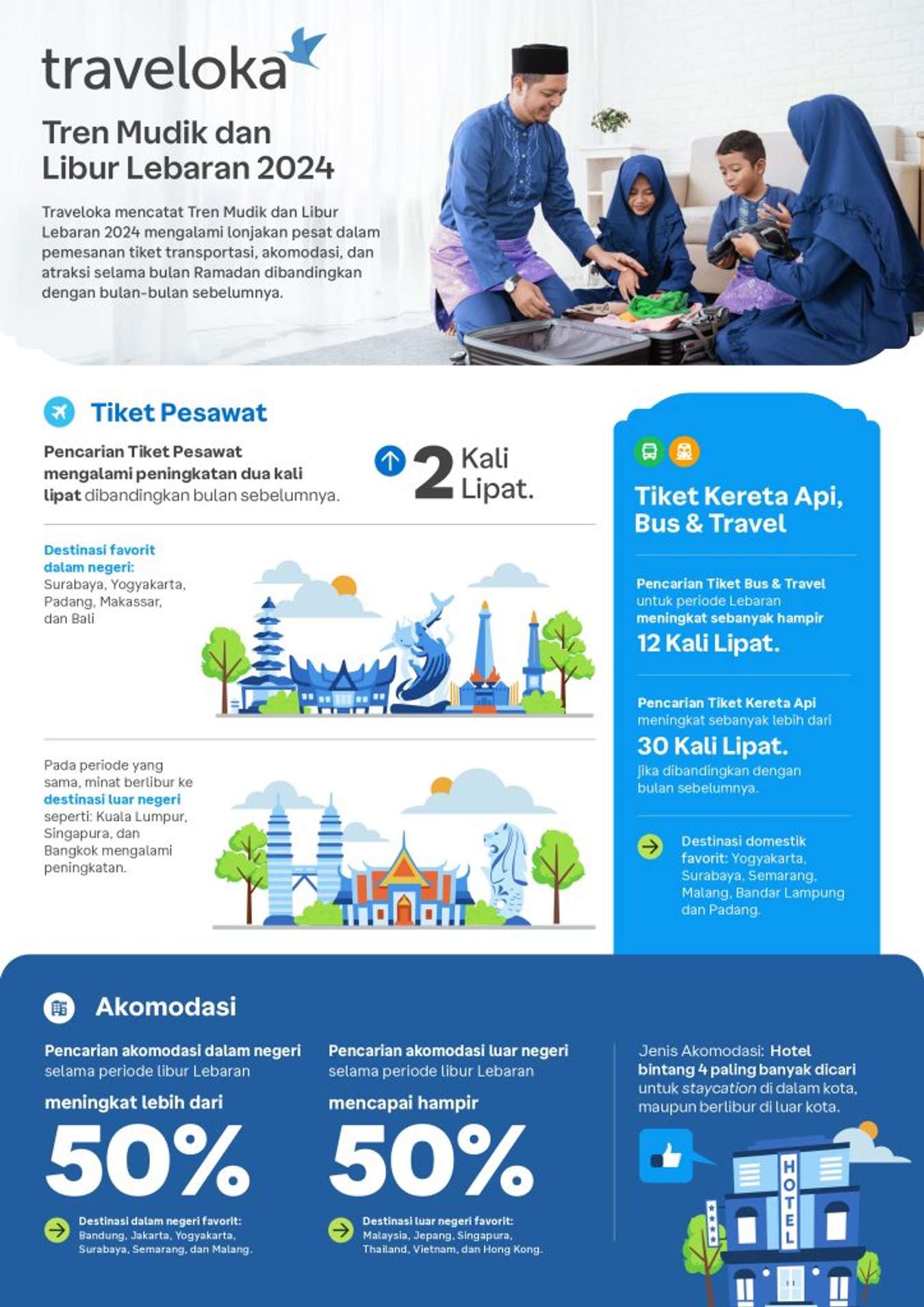
Ground transportation options like Trains, Buses, and Travel (door-to-door shuttles) remain popular, especially for inter-island travel within Java. Searches for Bus & Travel during Eid have increased nearly twelvefold, while Train searches have risen over thirtyfold compared to the previous month. Top domestic destinations for ground travel include Yogyakarta, Surabaya, Semarang, Malang, Bandar Lampung, and Padang. To address the heightened demand during the homecoming season, Traveloka has collaborated with Cititrans to introduce new bus routes such as Jakarta - Semarang - Solo - Yogyakarta and Jakarta - Surabaya - Malang, accessible through the Traveloka website or app.
Internal data from Traveloka indicates varying peak periods for both the homecoming and return journeys, based on ticket purchases. For Flights, peak departures will be on April 5-6, 2024, with returns peaking on April 14-15, 2024. Trains will see its peak departure period from April 5-8, 2024, and returns beginning on April 13-15, 2024. Similarly, Bus & Travel surge in departures will be between April 3-8, 2024, with returns peaking on April 13-15, 2024.
Following the increase in transportation searches, there was a surge of over 50% in accommodation searches during the Eid holiday, compared to the previous month. Four-star hotels were particularly popular, whether for city staycations or out-of-town getaways. Key destinations for accommodation searches during the Eid homecoming and holiday period in 2024 included Bandung, Jakarta, Yogyakarta, Surabaya, Semarang, and Malang. Traveloka also noted a nearly 50% rise in interest in international accommodations during the Eid holiday week compared to the preceding week. Asian countries such as Malaysia, Japan, Singapore, Thailand, Vietnam, and Hong Kong emerged as top destinations for the 2024 Eid holiday period.
During the Eid holiday, many individuals explore various tourist attractions, as evidenced by the doubling of searches for amusement parks and recreational areas. While residents of Jakarta typically venture outside the city or even abroad during Eid vacations, the city becomes a sought-after destination for those residing elsewhere, drawn by the relatively affordable transportation costs. This trend results in an increase in tourists from beyond Jakarta visiting popular spots such as Dufan - Ancol, Taman Mini Indonesia Indah, and Kidzania, along with other attractions like the Kecak Dance at Pura Uluwatu in Bali and Jatim Park in Malang. Moreover, there has been a twofold increase in demand for tour packages, with destinations like Labuan Bajo, Kintamani, the Thousand Islands, Ubud, and Borobudur (Punthuk Setumbu) emerging as top choices.
Easy travel with Traveloka
To accommodate the surge in traffic during the homecoming and Lebaran holidays, Traveloka has partnered with Kopi Kenangan along with well-known shuttle services, Jackal Holidays and Areon. This collaboration offers consumers a selection of convenient pick-up and drop-off locations, enhancing accessibility and convenience. Consumers can choose to depart from the Virtual Point at Kopi Kenangan Shell Kesambi (Cirebon) with Jackal Holidays, heading to Jackal Holidays' Bandung pool (Dipati Ukur & Pasteur), or departing from Kopi Kenangan Antapani (Bandung) with Areon, bound for the Areon pool in Jakarta (Setiabudi & Kuningan area).
The journey will be even more delightful with fresh drinks from Kopi Kenangan. Customers can enjoy their favorite beverages while waiting for shuttle pickup at strategic locations in cities such as Bandung and Cirebon, two top destinations for land transportation, especially shuttle services.
Ananditha Mayasari, AVP, Head of Marketing, Kopi Kenangan, said, "We're delighted to join forces with Traveloka to aid travelers during the Lebaran 2024 homecoming season. This partnership also aligns with Kopi Kenangan's commitment to offering outlets at key points along the homecoming route, such as rest areas along the Java Island toll road, providing travelers with a comforting break during their long journey."
Traveloka goes beyond providing travel solutions by offering innovative products, features, and attractive deals to meet consumer needs such as the Promo Rama dan Kenyamanan the Rama and Comfort Promo program. The program offers discounts of up to 50% on various travel products, including Flights, Accommodations, Buses, Trains, and Xperience, available on the Traveloka app and website until April 21, 2024.
Recognizing the heightened interest in international travel and the associated risks, including visa issues, Traveloka introduces the Visa Protection feature. Travelers can rest assured that if their visa is rejected, Traveloka will refund 100% of the travel costs, subject to terms and conditions. For more details on the Visa Protection feature, visit the Traveloka website.
Release ID: 89126627
If there are any deficiencies, problems, or concerns regarding the information presented in this press release that require attention or if you need assistance with a press release takedown, we encourage you to notify us without delay at [email protected]. Our diligent team is committed to promptly addressing your concerns within 8 hours and taking necessary actions to rectify any identified issues or facilitate the removal process. Providing accurate and trustworthy information is of utmost importance.

IMAGES
COMMENTS
Create An Itinerary. Having an itinerary allows you to keep your trip organized from beginning to end. This is especially important during the holiday season when travel can be delayed, canceled, and overcrowded. Take time to plan your travel to and from the airport based on your flight times in advance. Your job may arrange travel for you, so ...
01730 711 010. 0116 264 5270. Meon Valley Travel is a full-service agency booking travel for business, holidays, and worldwide emergency repatriations. Every time we answer the phone we save a life, save money or fulfill a dream.
Happy holidays to the road warriors and cheers to maintaining client relationships and starting new ones! Methodology: SAP Concur analyzed business travel bookings in Concur Travel with a U.S. origin during November and December 2023, and established holiday date ranges of 11/17-11/26 for Thanksgiving and 12/21-1/3 for Christmas and the New Year.
Follow these 6 steps for an effective business trip: Make your travel arrangements well in advance. Select your accommodation based on both price and convenience. Create an itinerary. Research your destination. Remember your electronics, accessories and travel documents. Prepare for your meeting. In today's digital world, we can communicate ...
9. Pack a Backup Battery. In this era of conveniences, it stinks to be inconvenienced by a delayed flight, stalled train, stuck elevator, and what have you. Having a backup battery on hand, also ...
According to Morning Consult data, the percentage of frequent business travelers who say they'll never return to the road has ticked up from 39% in October 2021 to 42% in February 2022. At a New ...
A 2022 survey conducted by hotel brand Crowne Plaza found that 60% plan to add leisure travel days onto future business trip itineraries. "It's almost as if Monday is the new Sunday and ...
4. Ship the rest. Depending on how serious your trip is, you might need more than a few pairs of clothing. If you have to make a presentation and need your material from the office, then ship it ...
What is business travel? Business travel represents a trip that you take for work-related reasons. It does not include trips taken for personal reasons, such as holidays or vacations. You may make these trips alone or with other colleagues. Some examples of reasons for business travel include: Events such as conferences, lectures or exhibitions
Business travel might slow down occasionally, but it never really sleeps. On top of that, the holiday season is the busiest time of year for firms all around the globe. That is precisely why we have put together this infographic to help travel managers handle business travel this holiday season.
4. Prioritizing sleep. While it might be tempting to use all your downtime to tackle more tasks on your to-do list and work late into the night, getting sleep is essential for a successful work ...
Business travel has its perks, but, especially around the holidays, you have to go through a lot to enjoy them. Let's say you are on a business trip. At your fifth business meeting of the day, you are probably picturing yourself going back to the hotel room and hoarding the plush bed all to yourself while dinner's on the way.
The busiest travel months or the peak seasons in the travel industry can vary depending on the region and the nature of the business. Some common examples include: Holiday Seasons: Major holidays such as Christmas, New Year, Thanksgiving, and Easter are prime travel times. Businesses often want to wrap up projects before the holidays or plan ...
Increased demand for midday flights. Flexible work has also changed the times of day when people travel. When work was primarily conducted in an office, workers needed to schedule their flights for later at night to get in a full day in the office before traveling. According to the New York Times.
Last year, the three busiest days for air travel over the December holidays were as follows, per TSA data: Dec. 21, 2022 (a Thursday) Dec. 30, 2022 (a Friday) Jan. 2, 2023 (a Monday — and a federal holiday following New Year's Day) This year, Christmas Day and New Year's Day fall on a Monday. It seems a safe bet that airports will be busy ...
GeoBlue offers both single-trip and multi-trip policies for business travelers, international travelers and non-profit and humanitarian groups doing work in foreign countries. Teachers, students ...
July 30: 2.793 million passengers. July 28: 2.785 million passengers. July 23: 2.789 million passengers. June 30: 2.884 million passengers (the new record for the busiest air travel day ever in the United States) June 16: 2.785 million passengers. For reference, the busiest travel day in all of 2019 was November 27, with 2.882 million passengers.
Moscow travel guide for tourists and business travelers. Full and accurate online information and travel services to help plan any trip to Moscow, Russia. Find everything you need to know about Moscow here. ... Whether you're planning a trip to Moscow or searching for a souvenir to remind you of a magical holiday, you'll find a huge range of ...
66º F. WARMEST. 29 in. WETTEST. Sep - Nov. -. 43º F. 24 in. Price trend information excludes taxes and fees and is based on base rates for a nightly stay for 2 adults found in the last 7 days on our site and averaged for commonly viewed hotels in Moscow.
August also has the best prices to fly in style to Rome. We found business-class seats from New York City to Rome for $2,553. We told you earlier that this sale included travel over the major ...
The fall season brought back the return of business travel for people around the world.
"A working holiday is a great way to fund your trip," says Bollinger, who helps people book travel to Australia, New Zealand and Canada by organising working holidays so they can extend their ...
This tour is a perfect choice for those who wish to get to know Moscow in depth. One of the highlights of this package is the KGB history tour which gives an interesting perspective on the Cold War. You will also have time for exploring the city on your own or doing extra sightseeing. $ 941 From/Per person. Details.
other similar ordinary and necessary expenses related to your business travel. These expenses might include transportation to or from a business meal, public stenographer's fees, computer rental fees, and operating and maintaining a house trailer. ... Certain weekends and holidays. Count weekends, holidays, and other necessary standby days as ...
This will not only help in the current holiday season, but also better prepare for planning in the year to come. 2. Minimize Back Office Work. High volume sales and extended hours are likely to keep owners from managing the back end of their business in a timely manner. It's the customer first, everything else later.
For instance, travel with Qatar Airways and get sweet discounts when you book your ticket using your RCBC Mastercard Credit Card. Get a seven to 10-percent discount on economy and business class ...
Day 6 - Explore the Golden Ring. Creating the Moscow itinerary may keep you busy for days with the seemingly endless amount of things to do. Visiting the so-called Golden Ring is like stepping back in time. Golden Ring is a "theme route" devised by promotion-minded journalist and writer Yuri Bychkov.
American Express research has found three-quarters of Australians have planned multiple trips this year, and nine out of 10 are using "travel hacks" to save money. These include travelling on ...
Over the two-week holiday period, Air New Zealand is expecting 790,000 customers in total (up 13 per cent from the 2023 April school holidays) - 519,000 travelling within Aotearoa, and 271,000 ...
With the mudik season and holidays drawing near, Traveloka, the leading travel platform in Southeast Asia, shares the trends for the 2024 Eid season. Iko Putera, CEO of Transport at Traveloka ...